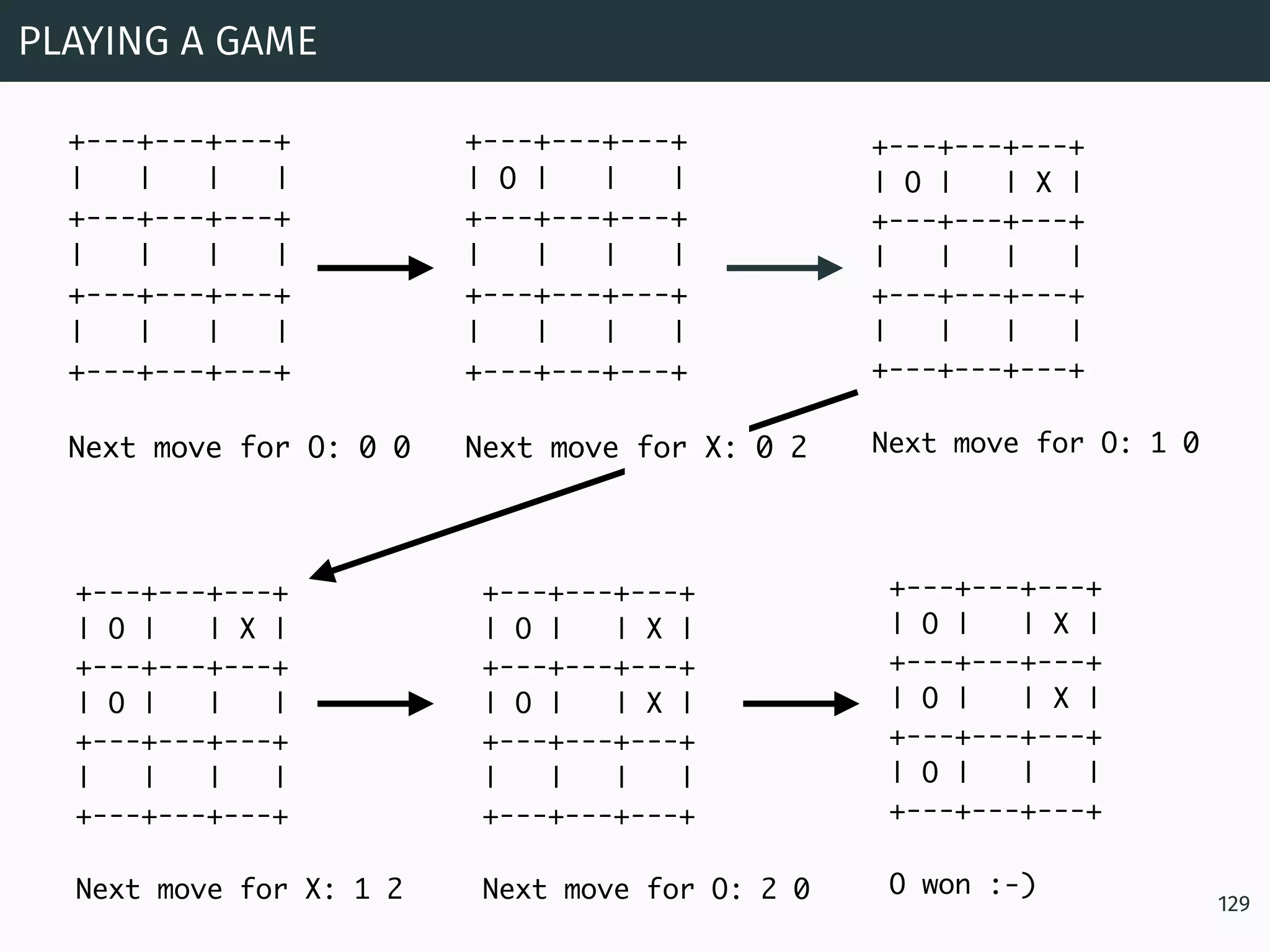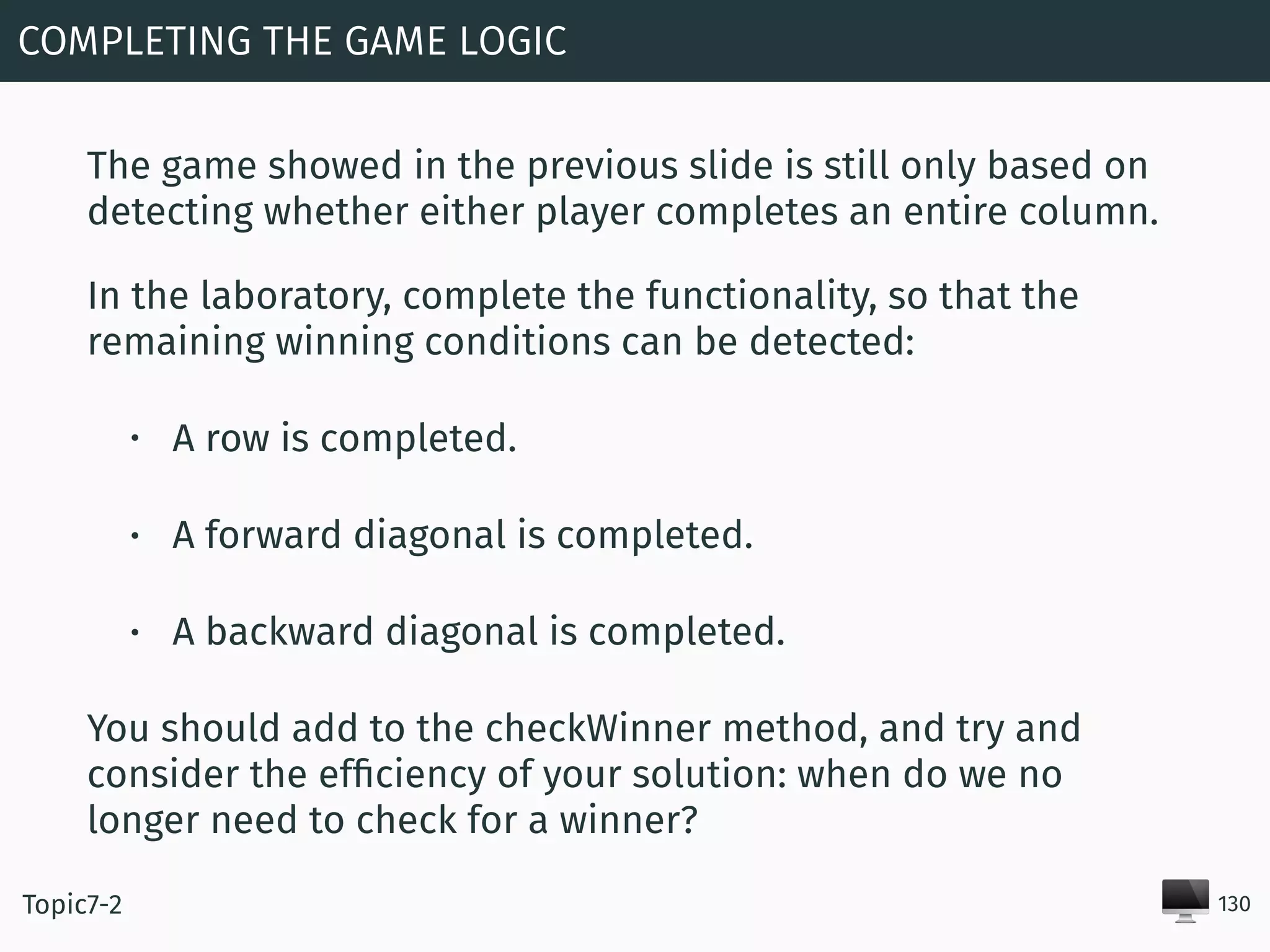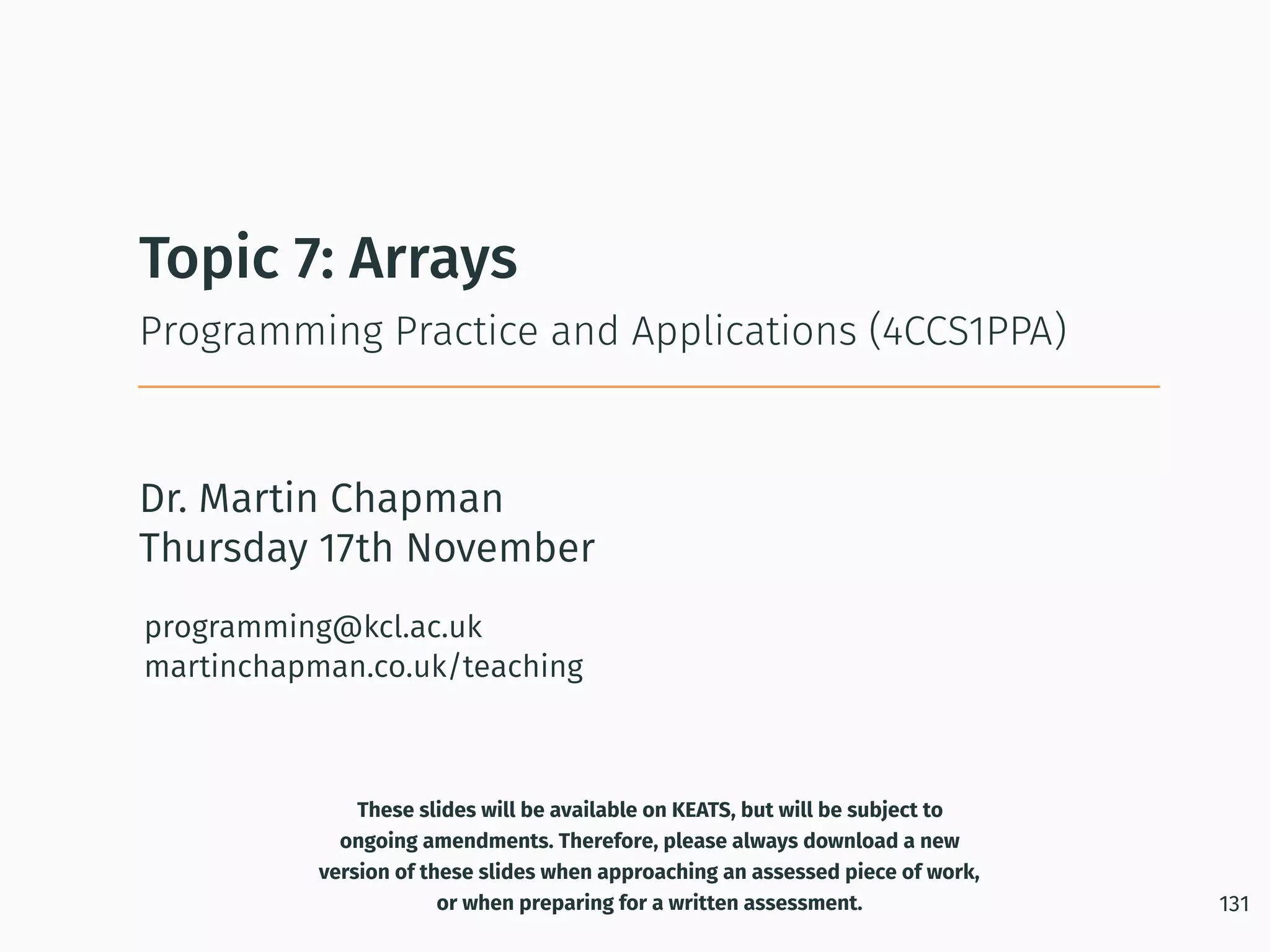The document provides an overview of arrays in programming, explaining their definition, usage, and how they can store multiple values. It covers how to create arrays, handle user input, and manage partially filled arrays, while also discussing the differences between arrays and objects in Java. Additionally, it emphasizes the importance of indexing and array length in avoiding runtime errors.
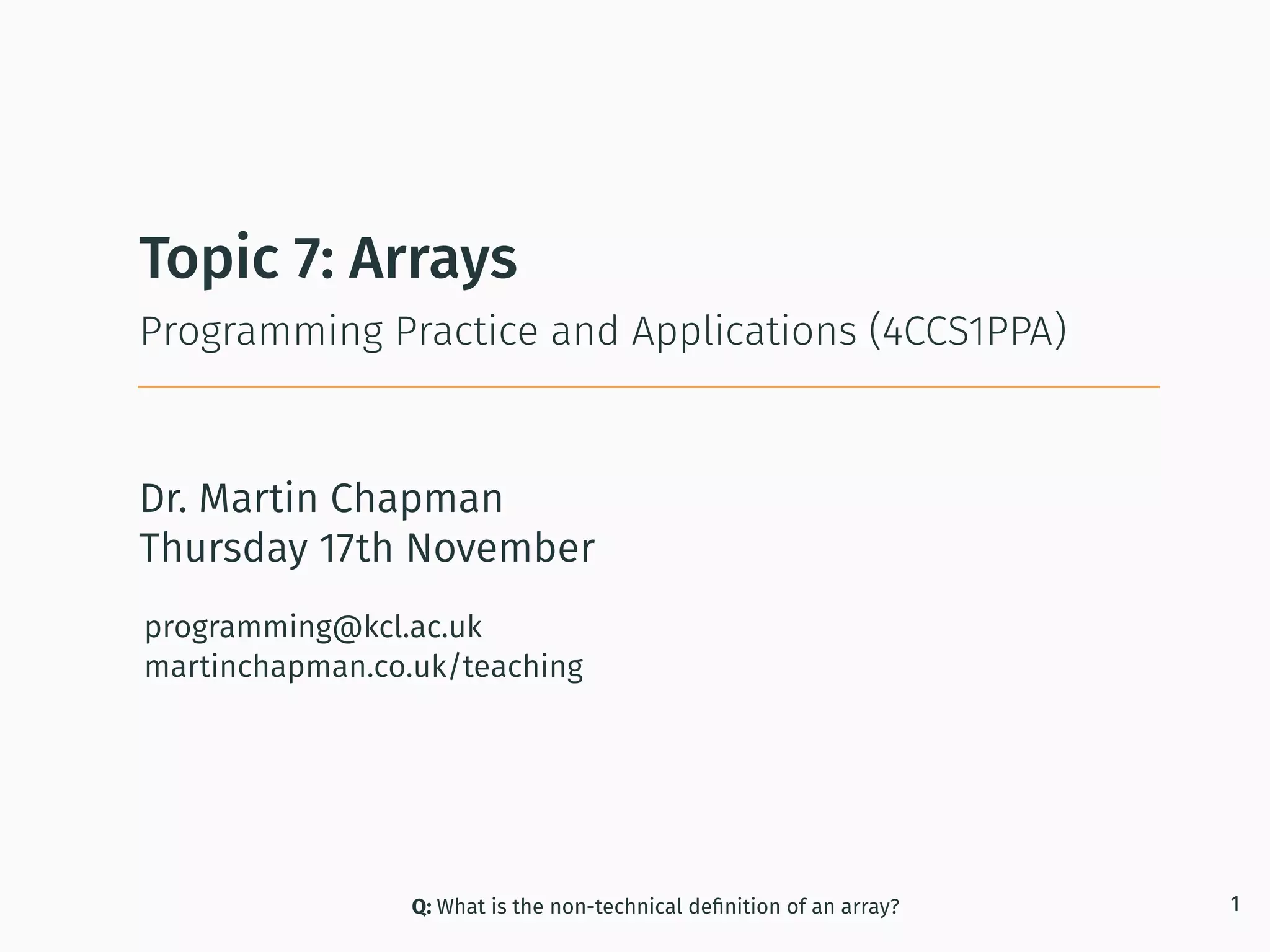
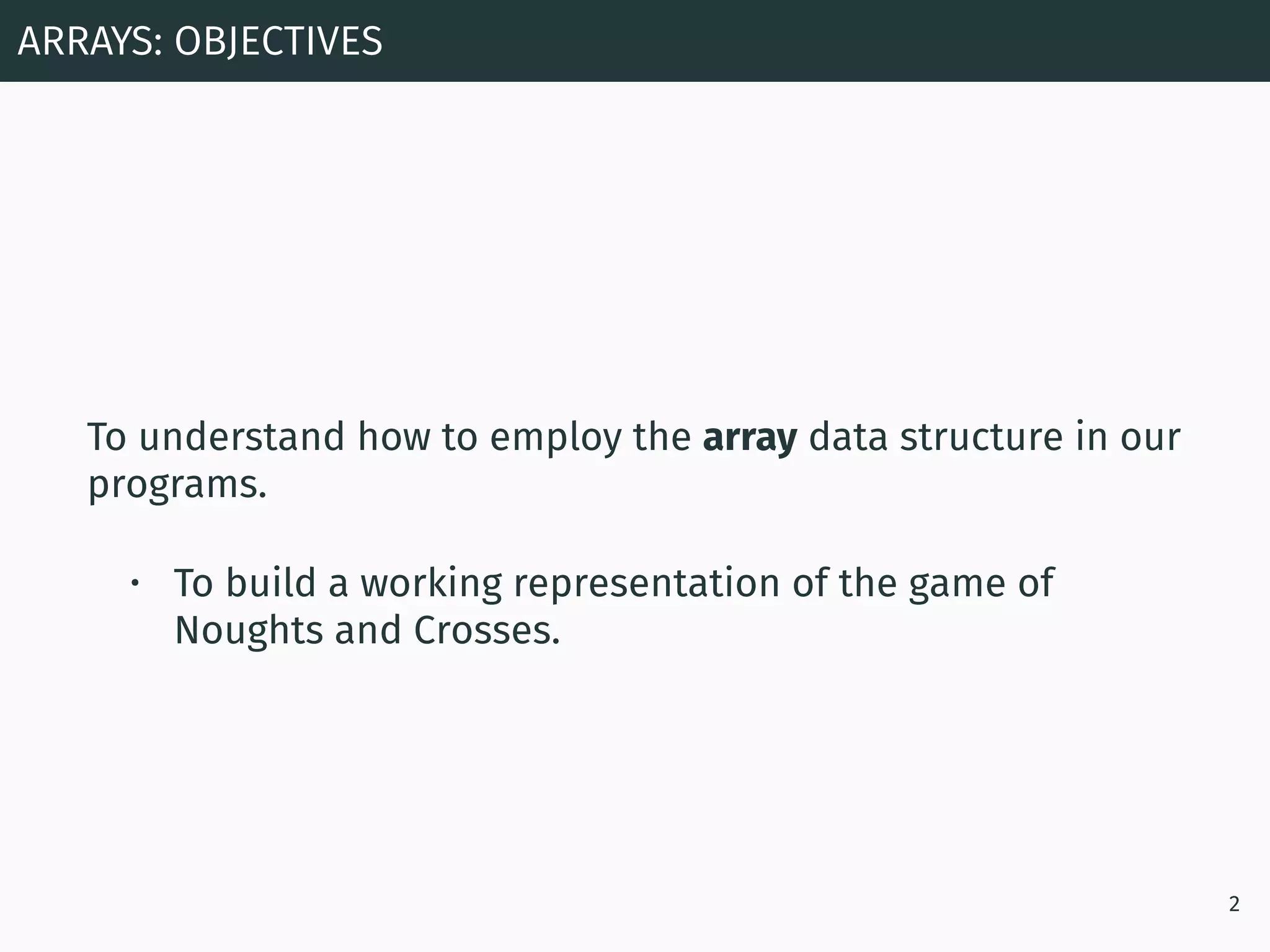
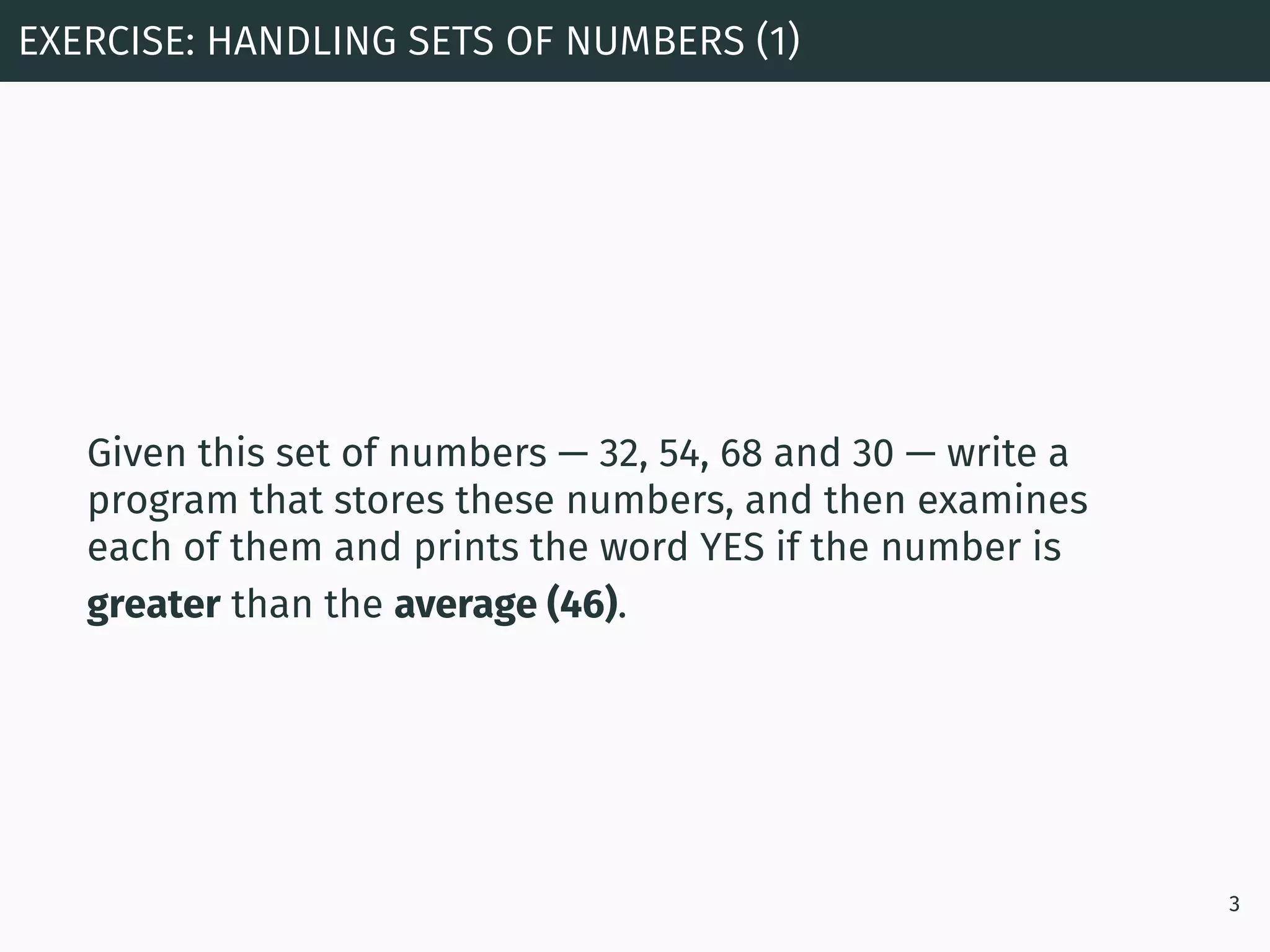
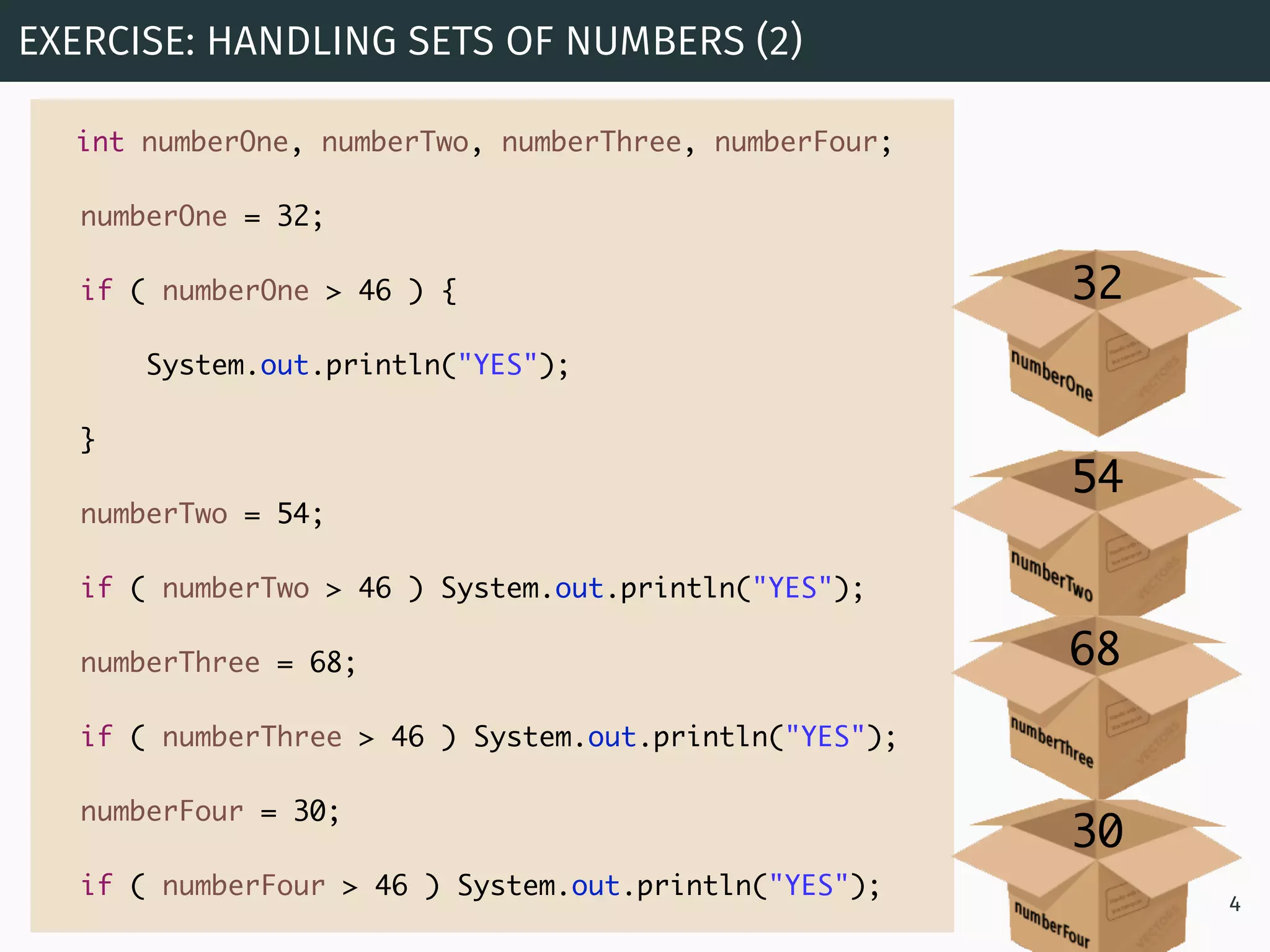
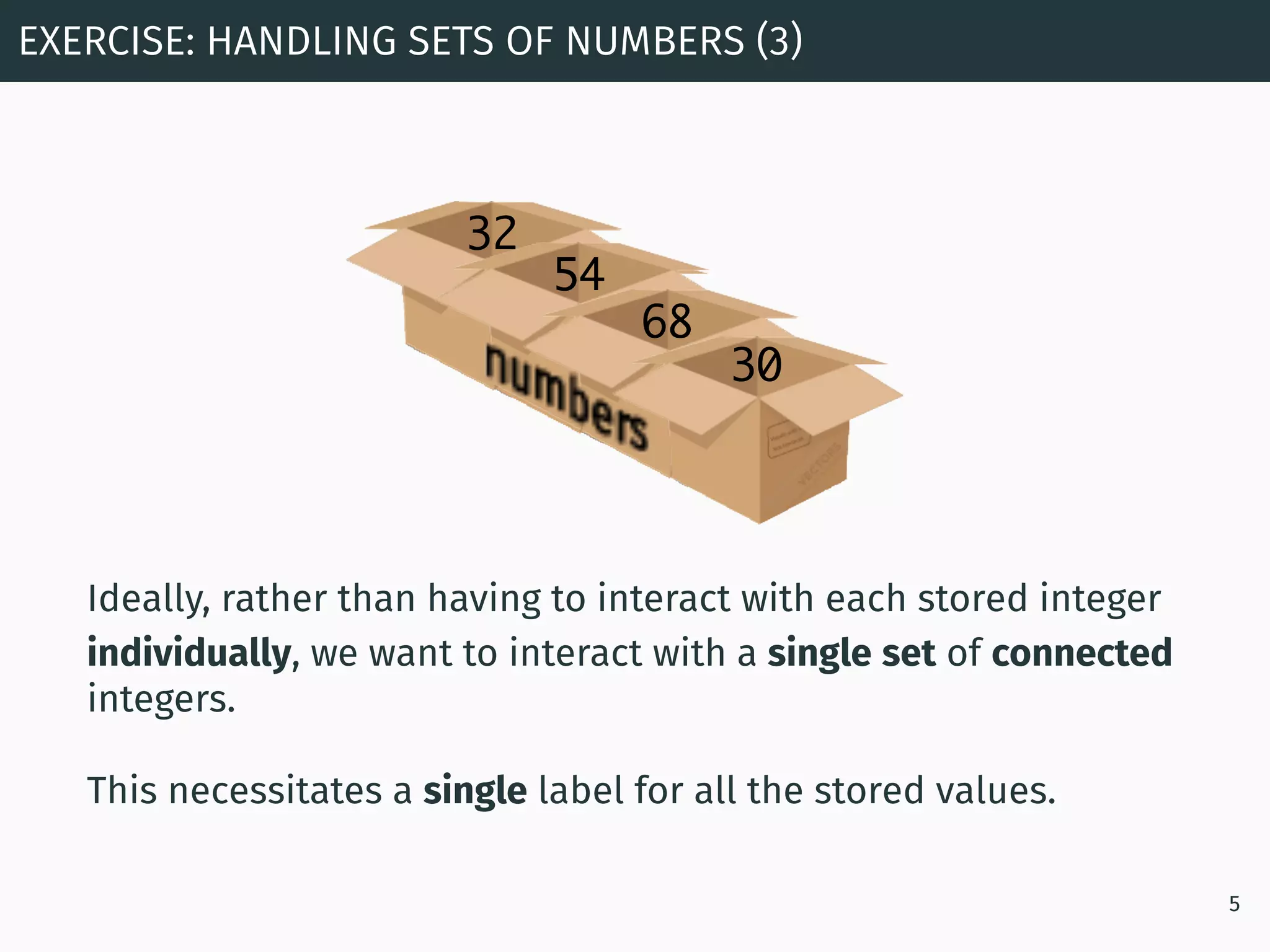
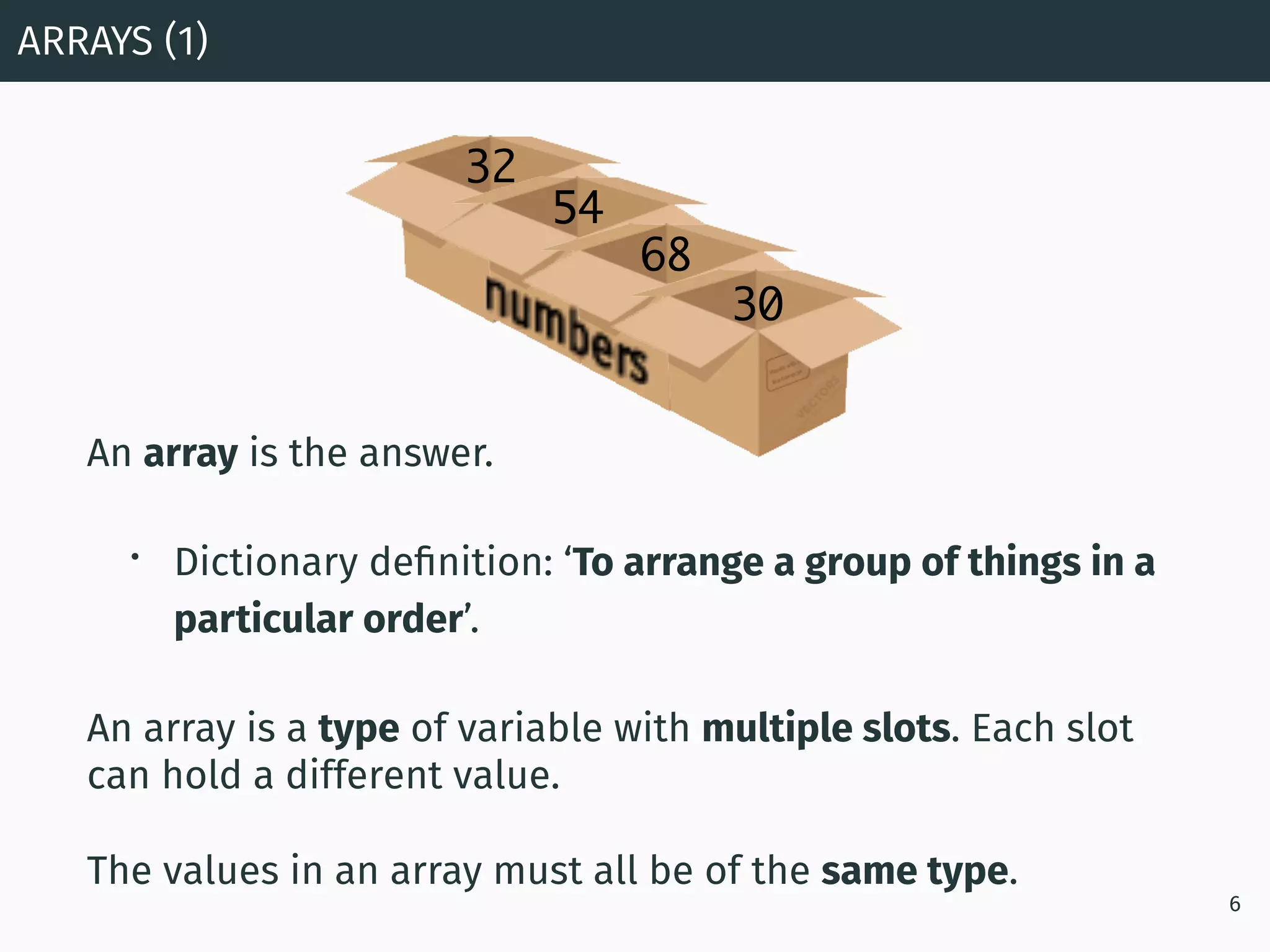
![`A array is a type of variable’ ARRAYS (2) 7 int numberOne, numberTwo, numberThree, numberFour; `with multiple slots.’ int[] numbers int[] numbers = new int[4]; `My numbers variable has 4 slots’ `Each slot can hold a different value.’ numberOne = 32; numberTwo = 54; numberThree = 68; numberFour = 30; numbers[0] = 32; numbers[1] = 54; numbers[2] = 68; numbers[3] = 30; We place square brackets after a type to indicate that we want to store a sequence of values of this type.](https://image.slidesharecdn.com/9wt4em3btiqhrbnptnkk-signature-1d71bc69af8e1ce5cfd06165f1692fb262b99bc72e1cbb4e076cc65ccd63e69f-poli-180215150739/75/Programming-in-Java-Arrays-7-2048.jpg)
![Create an array… ARRAYS (3): CREATE AND STORE (SUMMARY) 8 …and then store things in that array. int[] numbers = new int[4]; numbers[0] = 32; numbers[1] = 54; numbers[2] = 68; numbers[3] = 30; 32 54 67 2930 68 54 32 [0] [1] [2] [3] The length of the array differs from the last index.](https://image.slidesharecdn.com/9wt4em3btiqhrbnptnkk-signature-1d71bc69af8e1ce5cfd06165f1692fb262b99bc72e1cbb4e076cc65ccd63e69f-poli-180215150739/75/Programming-in-Java-Arrays-8-2048.jpg)
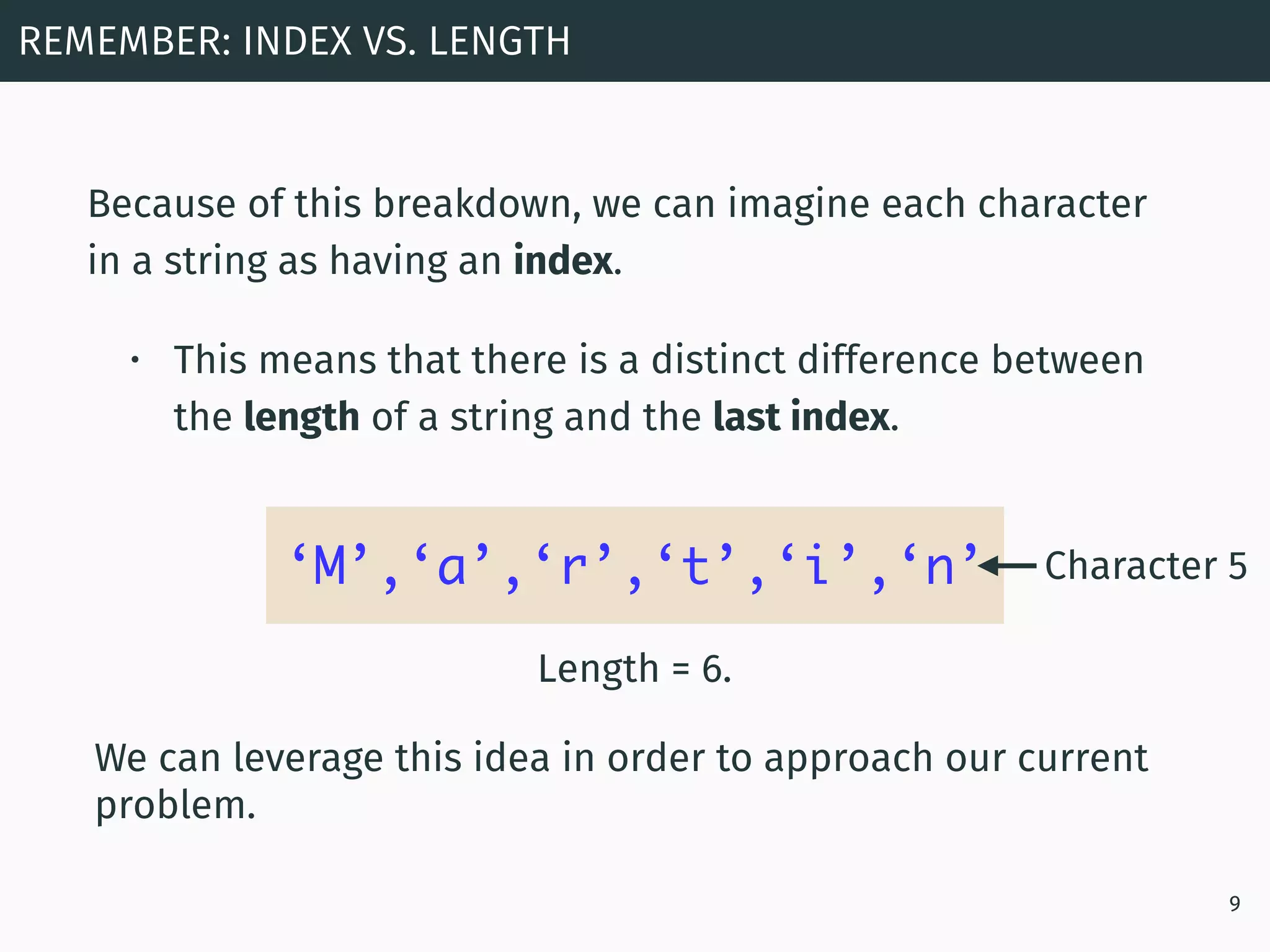
![We could combine the steps we saw previously in order to declare and initialise an array in a single line. • A similar principle as a single line declaration and initialisation for a normal variable. • Thus, we would need to know the values we want in that array immediately. This would give us an array of a size equal to the number of values. ARRAYS (3): CREATE AND STORE (SINGLE LINE) 10 int[] numbers = { 32, 54, 68, 30 };](https://image.slidesharecdn.com/9wt4em3btiqhrbnptnkk-signature-1d71bc69af8e1ce5cfd06165f1692fb262b99bc72e1cbb4e076cc65ccd63e69f-poli-180215150739/75/Programming-in-Java-Arrays-10-2048.jpg)
![FIXED ARRAY SIZE 11 int[] numbers = new int[4]; numbers[0] = 32; numbers[1] = 54; numbers[2] = 68; numbers[3] = 30; When we specify the initial size of an array, this size is fixed, such that if we try and write to a non-existent index, the following occurs: numbers[4] = 52;](https://image.slidesharecdn.com/9wt4em3btiqhrbnptnkk-signature-1d71bc69af8e1ce5cfd06165f1692fb262b99bc72e1cbb4e076cc65ccd63e69f-poli-180215150739/75/Programming-in-Java-Arrays-11-2048.jpg)
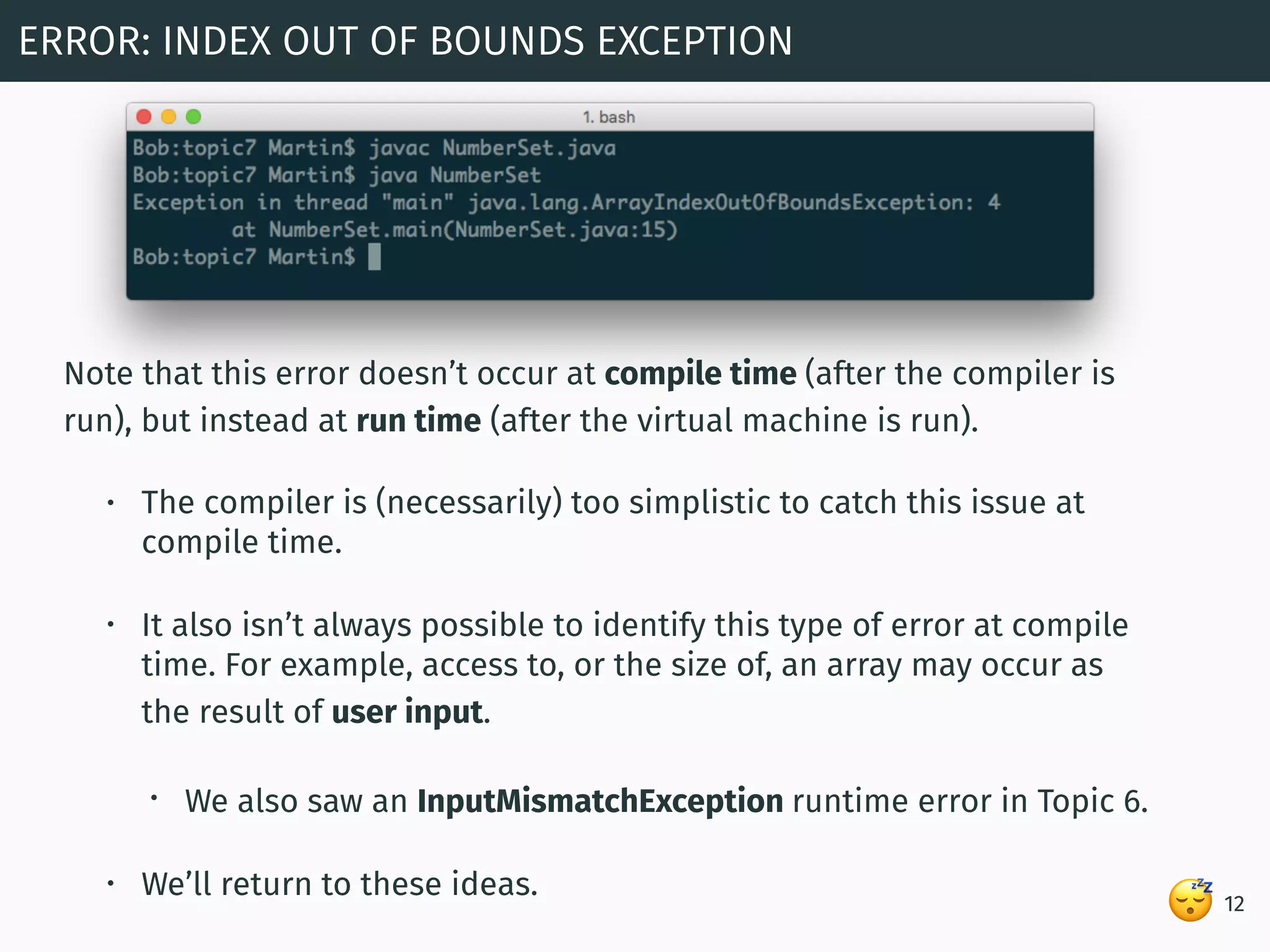
![We first need to work out how to determine the length of an array. HOW DO WE AVOID A NON-EXISTENT INDEX IN AN ARRAY BEING WRITTEN TO? (1) 13 int[] numbers = new int[4]; System.out.println("The length of the " + "numbers array is: " + );numbers.length If we want to split a string over two lines, we need to concatenate.](https://image.slidesharecdn.com/9wt4em3btiqhrbnptnkk-signature-1d71bc69af8e1ce5cfd06165f1692fb262b99bc72e1cbb4e076cc65ccd63e69f-poli-180215150739/75/Programming-in-Java-Arrays-13-2048.jpg)
![HOW DO WE AVOID A NON-EXISTENT INDEX IN AN ARRAY BEING WRITTEN TO? (2) 14 int i = 4, value = 52; int[] numbers = new int[4]; if ( 0 <= i && i < ) { numbers[i] = value; } numbers.length We can then combine this information with a conditional statement, to ensure that a non-existent index in an array is not written to. This test would become particularly important if we weren’t (directly) in control of the value in i.](https://image.slidesharecdn.com/9wt4em3btiqhrbnptnkk-signature-1d71bc69af8e1ce5cfd06165f1692fb262b99bc72e1cbb4e076cc65ccd63e69f-poli-180215150739/75/Programming-in-Java-Arrays-14-2048.jpg)
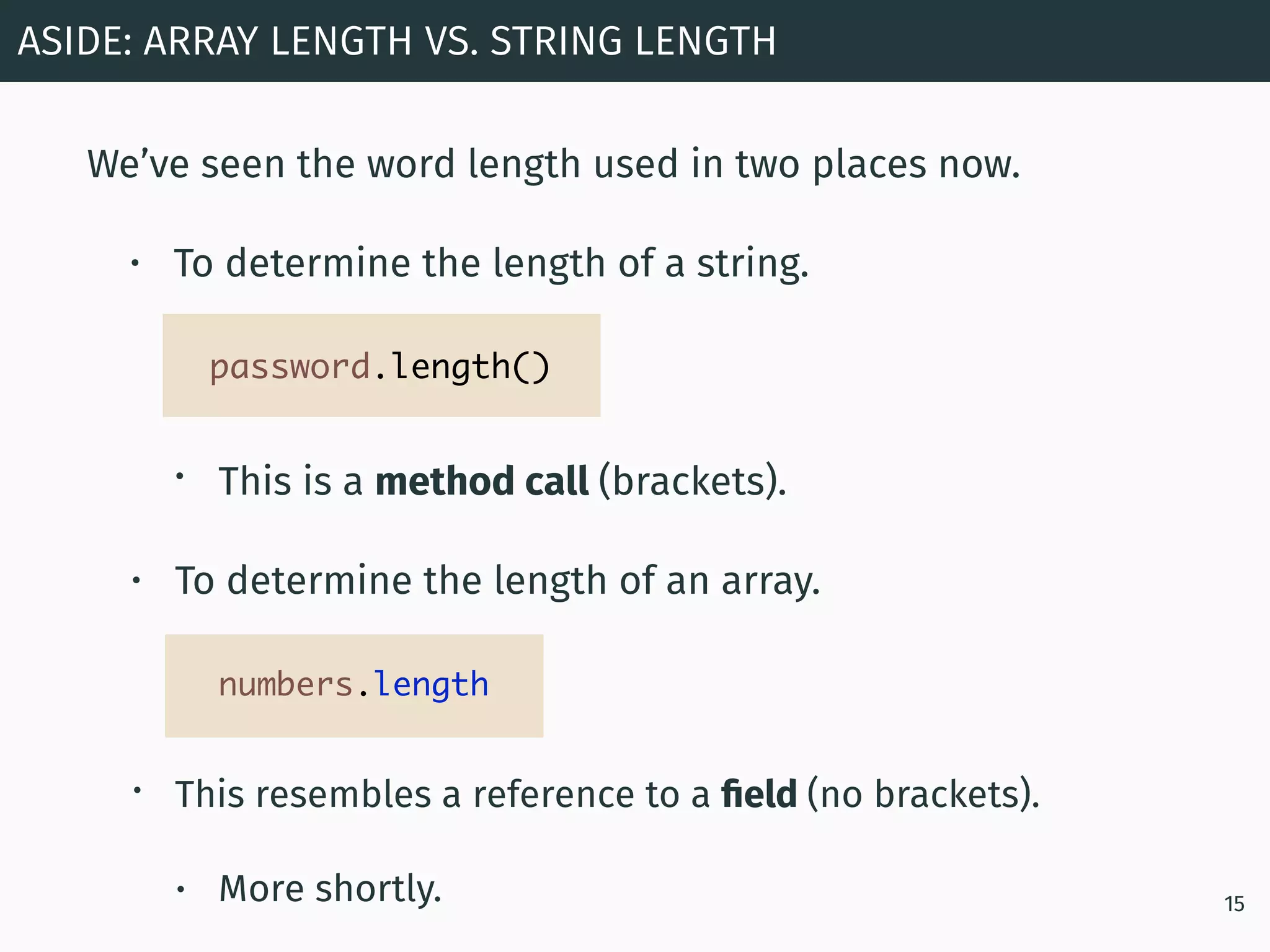
![In order to get data back from an array, we simply reference the index of the data that we want. HOW DO WE GET DATA BACK FROM AN ARRAY? 16 int[] numbers = new int[4]; numbers[0] = 32; numbers[1] = 54; numbers[2] = 68; numbers[3] = 30; System.out.println("The value in slot 2 is: " + numbers[2]);](https://image.slidesharecdn.com/9wt4em3btiqhrbnptnkk-signature-1d71bc69af8e1ce5cfd06165f1692fb262b99bc72e1cbb4e076cc65ccd63e69f-poli-180215150739/75/Programming-in-Java-Arrays-16-2048.jpg)
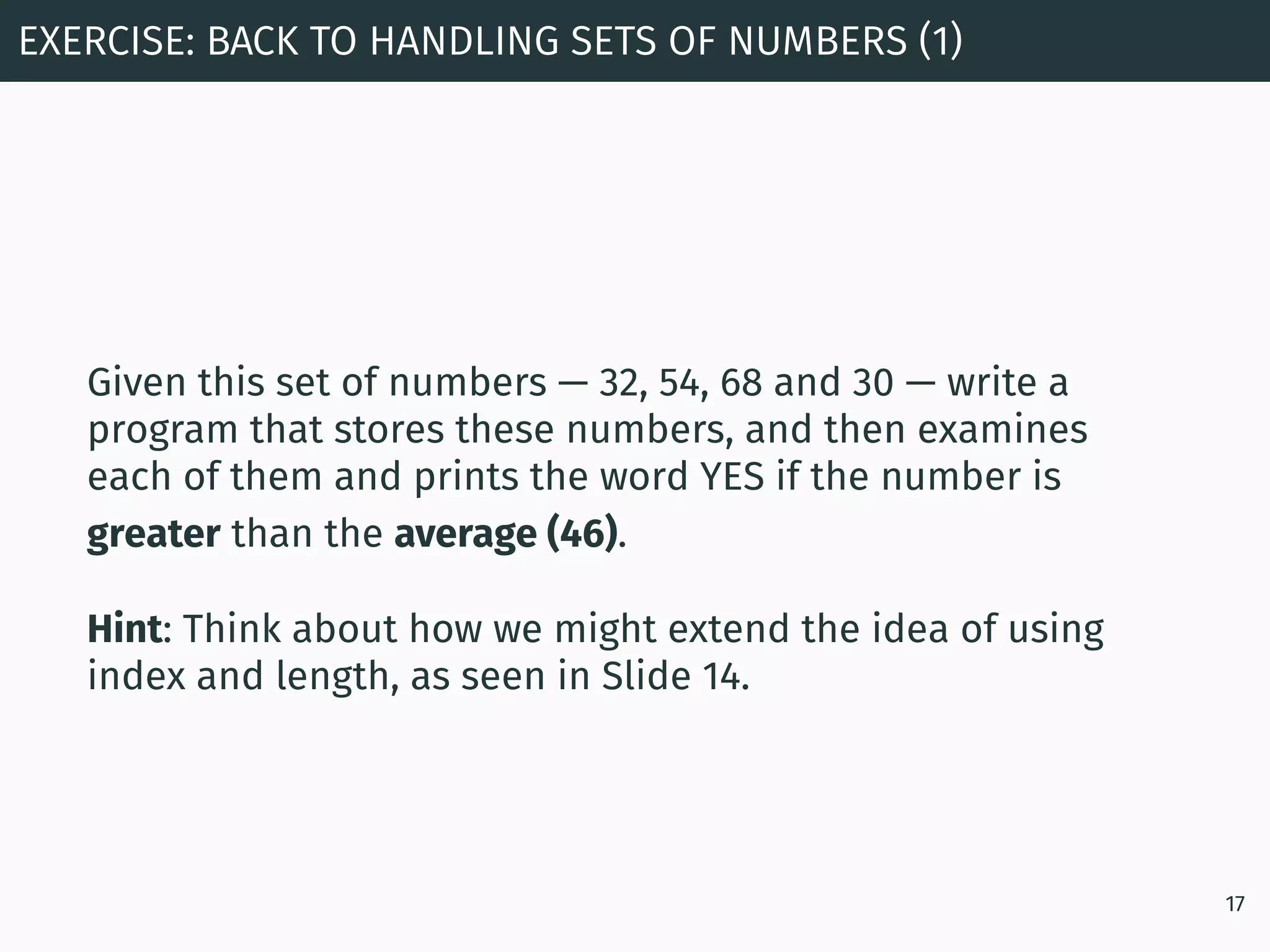
![REMEMBER: LEVERAGING THE LOOP INDEX (3) 18 public class NumberPrinter { public void printNumber(int num) { System.out.println("+------+"); System.out.println("|" + num + "|"); System.out.println("+------+"); } } public class Driver { public static void main(String[] args) { NumberPrinter numberPrinter = new NumberPrinter(); for ( int i = 1; i < 4; i++ ) { numberPrinter.printNumber(i); } } } As the loop index is just a variable declaration, it can be referenced inside the loop.](https://image.slidesharecdn.com/9wt4em3btiqhrbnptnkk-signature-1d71bc69af8e1ce5cfd06165f1692fb262b99bc72e1cbb4e076cc65ccd63e69f-poli-180215150739/75/Programming-in-Java-Arrays-18-2048.jpg)
![EXERCISE: BACK TO HANDLING SETS OF NUMBERS (2) 19 int[] numbers = new int[4]; numbers[0] = 32; numbers[1] = 54; numbers[2] = 68; numbers[3] = 30; for ( int i = 0; i < numbers.length; i++ ) { if ( numbers[i] > 46 ) System.out.println("YES"); } We use our knowledge of loop bounds to carefully control how we access each index. We could shorten this to a single line initialisation and declaration.](https://image.slidesharecdn.com/9wt4em3btiqhrbnptnkk-signature-1d71bc69af8e1ce5cfd06165f1692fb262b99bc72e1cbb4e076cc65ccd63e69f-poli-180215150739/75/Programming-in-Java-Arrays-19-2048.jpg)
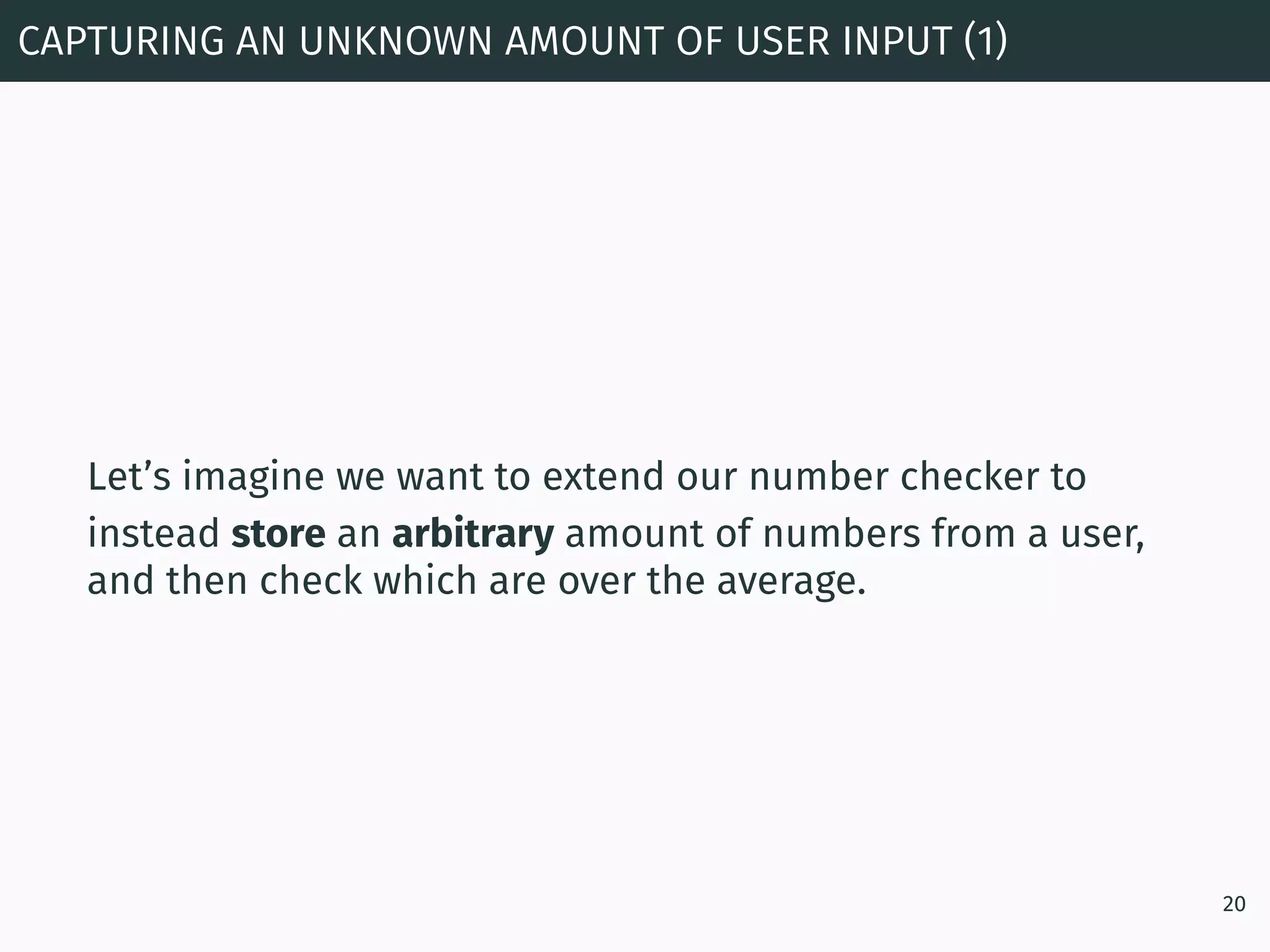
![REMEMBER: TRACKING A USER’S CALORIES (3) 21 import java.util.Scanner; public class CalorieTracker { public static void main(String[] args) { Scanner in = new Scanner(System.in); Person person = new Person(); System.out.println("Enter the calories in your starter:"); Dish starter = new Dish(); starter.setCalories(in.nextInt()) Every time we invoke the nextInt method, our program will stop and wait for another token of user input.](https://image.slidesharecdn.com/9wt4em3btiqhrbnptnkk-signature-1d71bc69af8e1ce5cfd06165f1692fb262b99bc72e1cbb4e076cc65ccd63e69f-poli-180215150739/75/Programming-in-Java-Arrays-21-2048.jpg)
![CAPTURING AN UNKNOWN AMOUNT OF USER INPUT (2) 22 import java.util.Scanner; Scanner in = new Scanner(System.in); in.nextInt(); in.close(); int[] numbers = new int[ ]; for ( int i = 0; i < ; i++ ) { numbers[i] = } What are our options here? ? ? Let’s fill in as much of the solution as we can: Familiar scanner syntax. Familiar array syntax.](https://image.slidesharecdn.com/9wt4em3btiqhrbnptnkk-signature-1d71bc69af8e1ce5cfd06165f1692fb262b99bc72e1cbb4e076cc65ccd63e69f-poli-180215150739/75/Programming-in-Java-Arrays-22-2048.jpg)
![OPTION 1: LET THE USER SPECIFY A MAXIMUM 23 import java.util.Scanner; Scanner in = new Scanner(System.in); in.nextInt(); in.close(); int[] numbers = new int[ ]; for ( int i = 0; i < ; i++ ) { numbers[i] = } What if the user themselves is unsure? in.nextInt() numbers.length](https://image.slidesharecdn.com/9wt4em3btiqhrbnptnkk-signature-1d71bc69af8e1ce5cfd06165f1692fb262b99bc72e1cbb4e076cc65ccd63e69f-poli-180215150739/75/Programming-in-Java-Arrays-23-2048.jpg)
![OPTION 2: SPECIFY A MAXIMUM FOR THE USER (1) 24 import java.util.Scanner; Scanner in = new Scanner(System.in); in.nextInt(); in.close(); int[] numbers = new int[ ]; for ( int i = 0; i < ; i++ ) { numbers[i] = } 100 numbers.length](https://image.slidesharecdn.com/9wt4em3btiqhrbnptnkk-signature-1d71bc69af8e1ce5cfd06165f1692fb262b99bc72e1cbb4e076cc65ccd63e69f-poli-180215150739/75/Programming-in-Java-Arrays-24-2048.jpg)
![OPTION 2: SPECIFY A MAXIMUM FOR THE USER (2) 25 import java.util.Scanner; Scanner in = new Scanner(System.in); in.nextInt(); in.close(); int[] numbers = new int[ ]; for ( int i = 0; i < ; i++ ) { numbers[i] = } 100 numbers.length What if someone wants to enter less than 100 numbers?](https://image.slidesharecdn.com/9wt4em3btiqhrbnptnkk-signature-1d71bc69af8e1ce5cfd06165f1692fb262b99bc72e1cbb4e076cc65ccd63e69f-poli-180215150739/75/Programming-in-Java-Arrays-25-2048.jpg)
![OPTION 2: SPECIFY A MAXIMUM FOR THE USER (3) 26 import java.util.Scanner; Scanner in = new Scanner(System.in); in.nextInt(); in.close(); int[] numbers = new int[ ]; while ( in.hasNextInt() ) { numbers[i] = } 100 What if someone wants to enter less than 100 numbers? How do we know where to place the next number? We could keep looping while there are still integers to read. System.out.println("Enter N numbers." + "Type 'done' to finish.");](https://image.slidesharecdn.com/9wt4em3btiqhrbnptnkk-signature-1d71bc69af8e1ce5cfd06165f1692fb262b99bc72e1cbb4e076cc65ccd63e69f-poli-180215150739/75/Programming-in-Java-Arrays-26-2048.jpg)
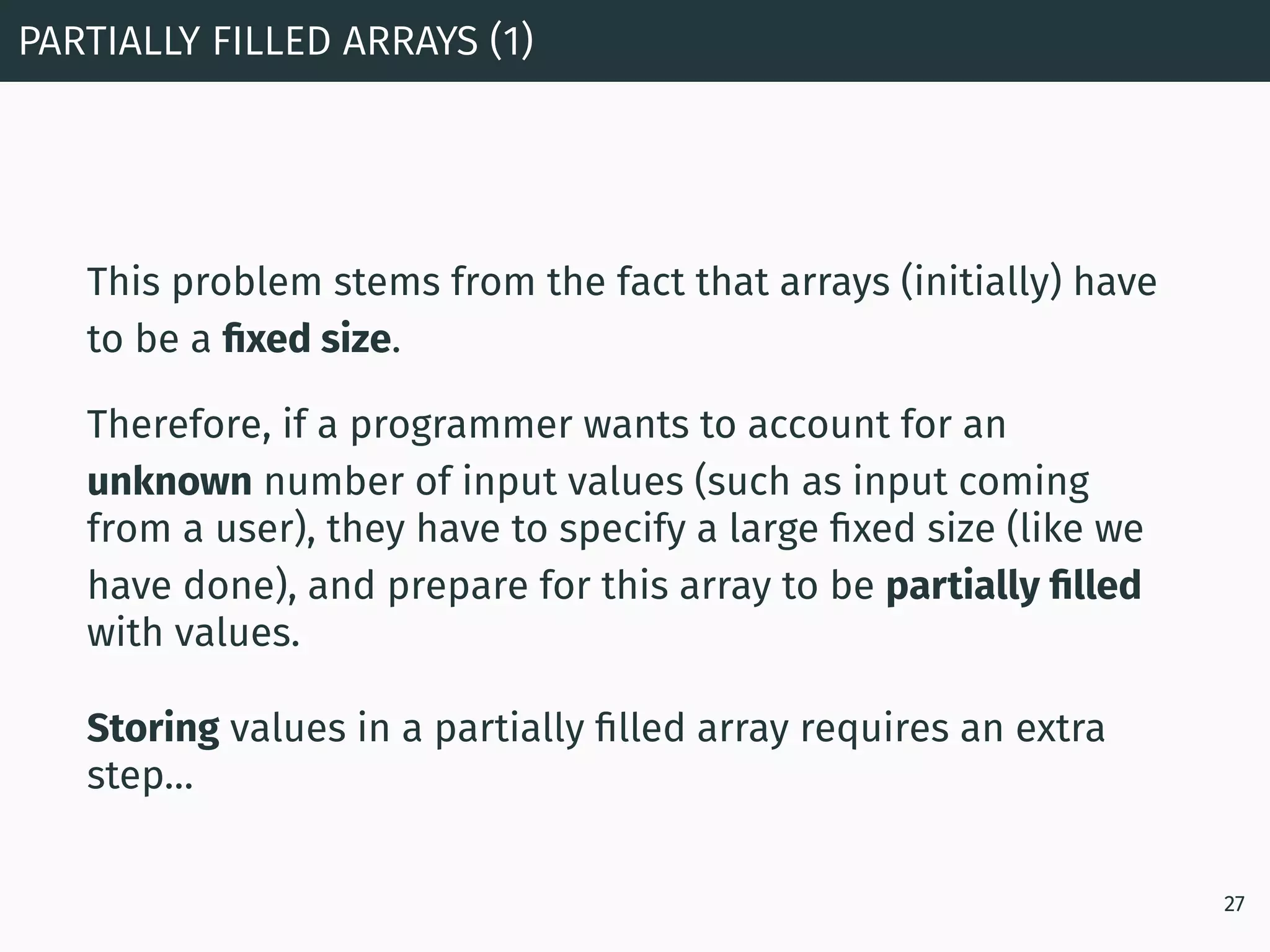
![PARTIALLY FILLED ARRAYS (2) 28 Scanner in = new Scanner(System.in); int[] numbers = new int[100]; while ( in.hasNextInt() ) { numbers[ ] = in.nextInt(); } in.close(); import java.util.Scanner; int elements = 0; elements++ We define an additional variable to track the next free slot in the array. Every time we add an item to the array, we increment this variable.](https://image.slidesharecdn.com/9wt4em3btiqhrbnptnkk-signature-1d71bc69af8e1ce5cfd06165f1692fb262b99bc72e1cbb4e076cc65ccd63e69f-poli-180215150739/75/Programming-in-Java-Arrays-28-2048.jpg)
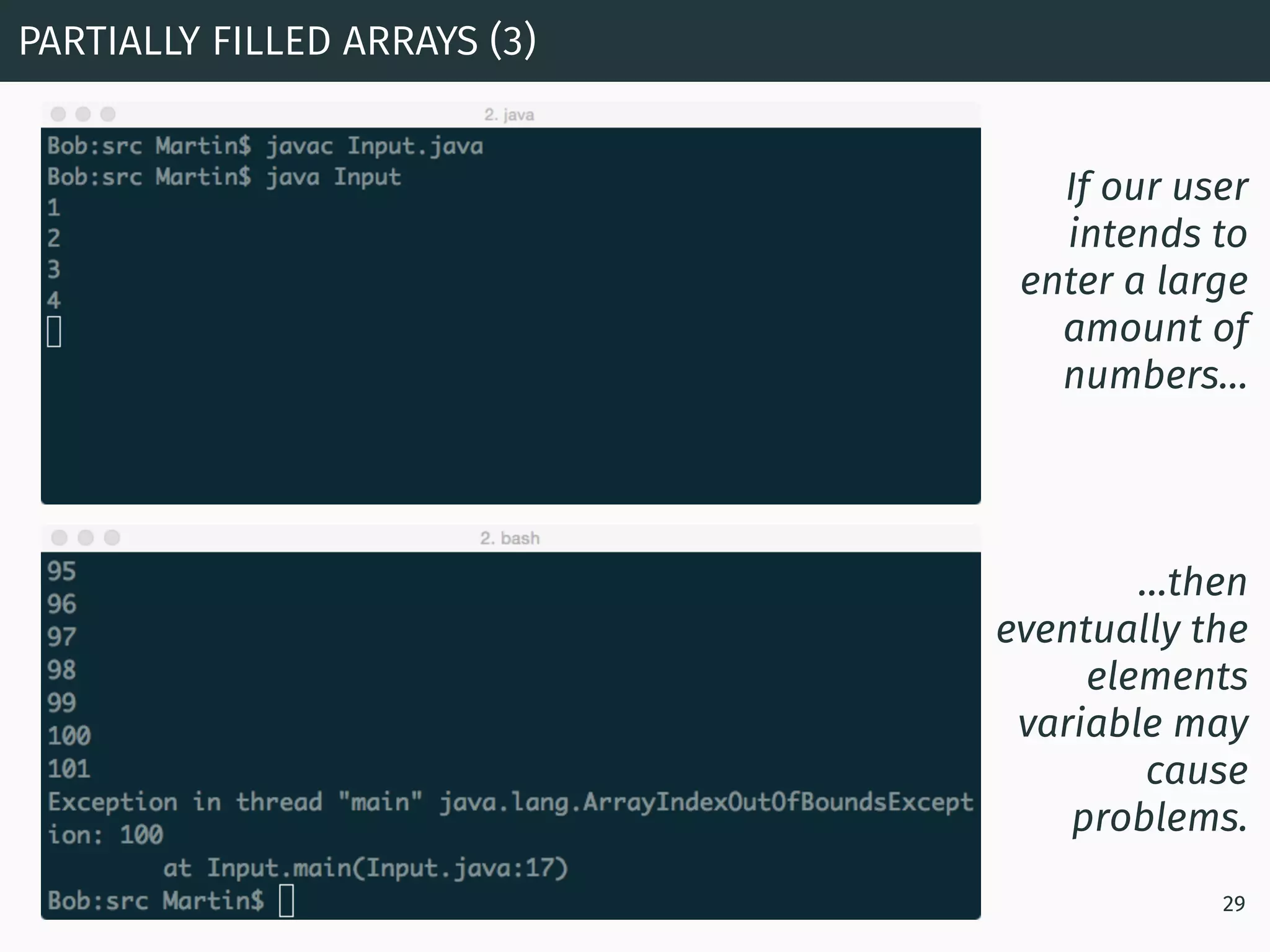
![PARTIALLY FILLED ARRAYS (4) 30 Scanner in = new Scanner(System.in); int[] numbers = new int[100]; while ( in.hasNextInt() && ) { numbers[ ] = in.nextInt(); } in.close(); import java.util.Scanner; int elements = 0; elements++ elements < numbers.length We can also use our element index variable to check whether it’s possible to continue adding items to the array.](https://image.slidesharecdn.com/9wt4em3btiqhrbnptnkk-signature-1d71bc69af8e1ce5cfd06165f1692fb262b99bc72e1cbb4e076cc65ccd63e69f-poli-180215150739/75/Programming-in-Java-Arrays-30-2048.jpg)
![Once a user has finished inputting their numbers, we can examine what they have entered by again using our elements variable. ACCESSING DATA IN A PARTIALLY FILLED ARRAY (1) 31 for ( int i = 0; i < elements; i++) { total += numbers[i]; } for ( int i = 0; i < elements; i++) { if ( numbers[i] > total / elements ) System.out.println("YES"); } (double) Length is no longer useful because it refers to the length of the array, not the number of items in it.](https://image.slidesharecdn.com/9wt4em3btiqhrbnptnkk-signature-1d71bc69af8e1ce5cfd06165f1692fb262b99bc72e1cbb4e076cc65ccd63e69f-poli-180215150739/75/Programming-in-Java-Arrays-31-2048.jpg)
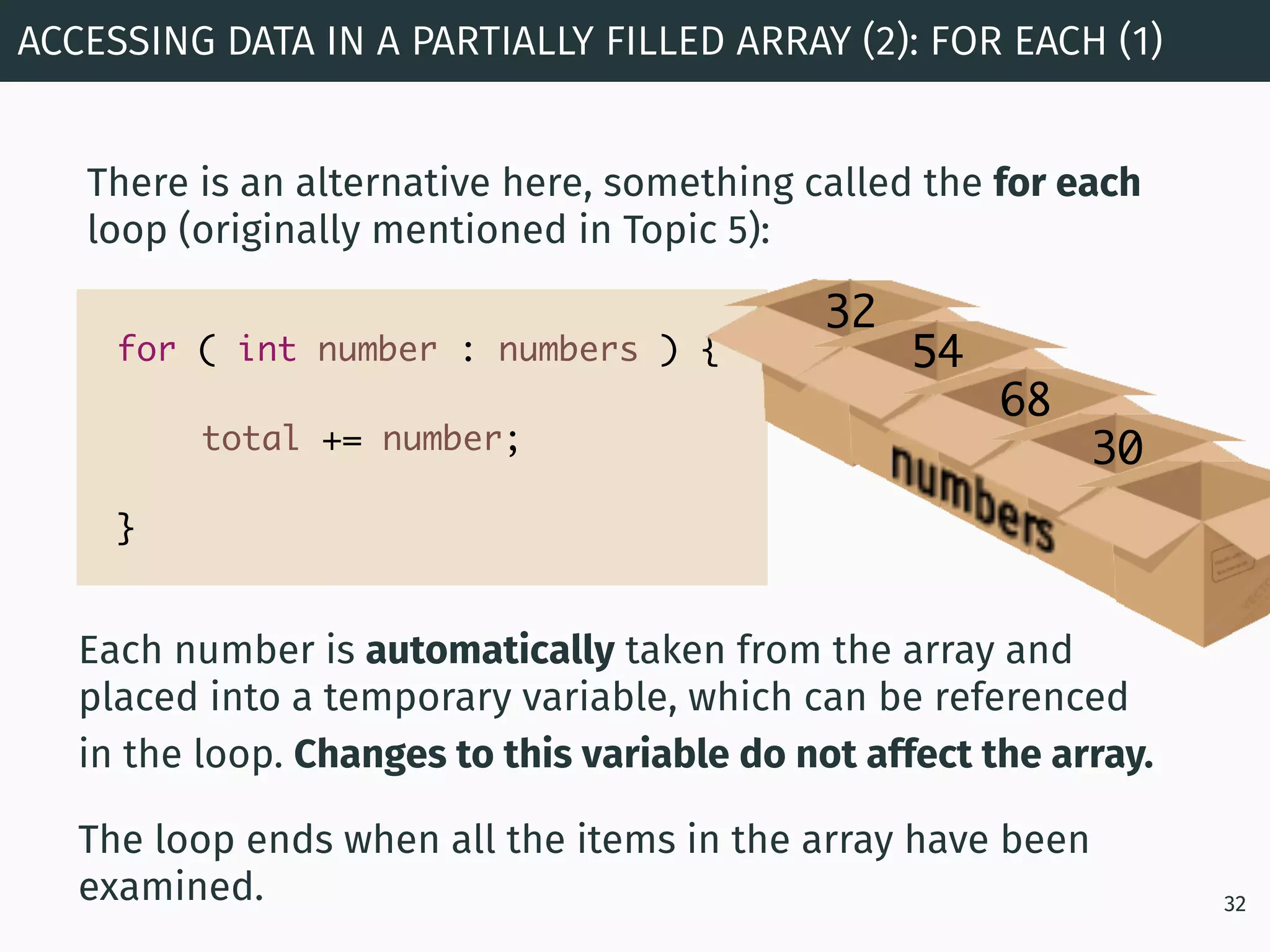
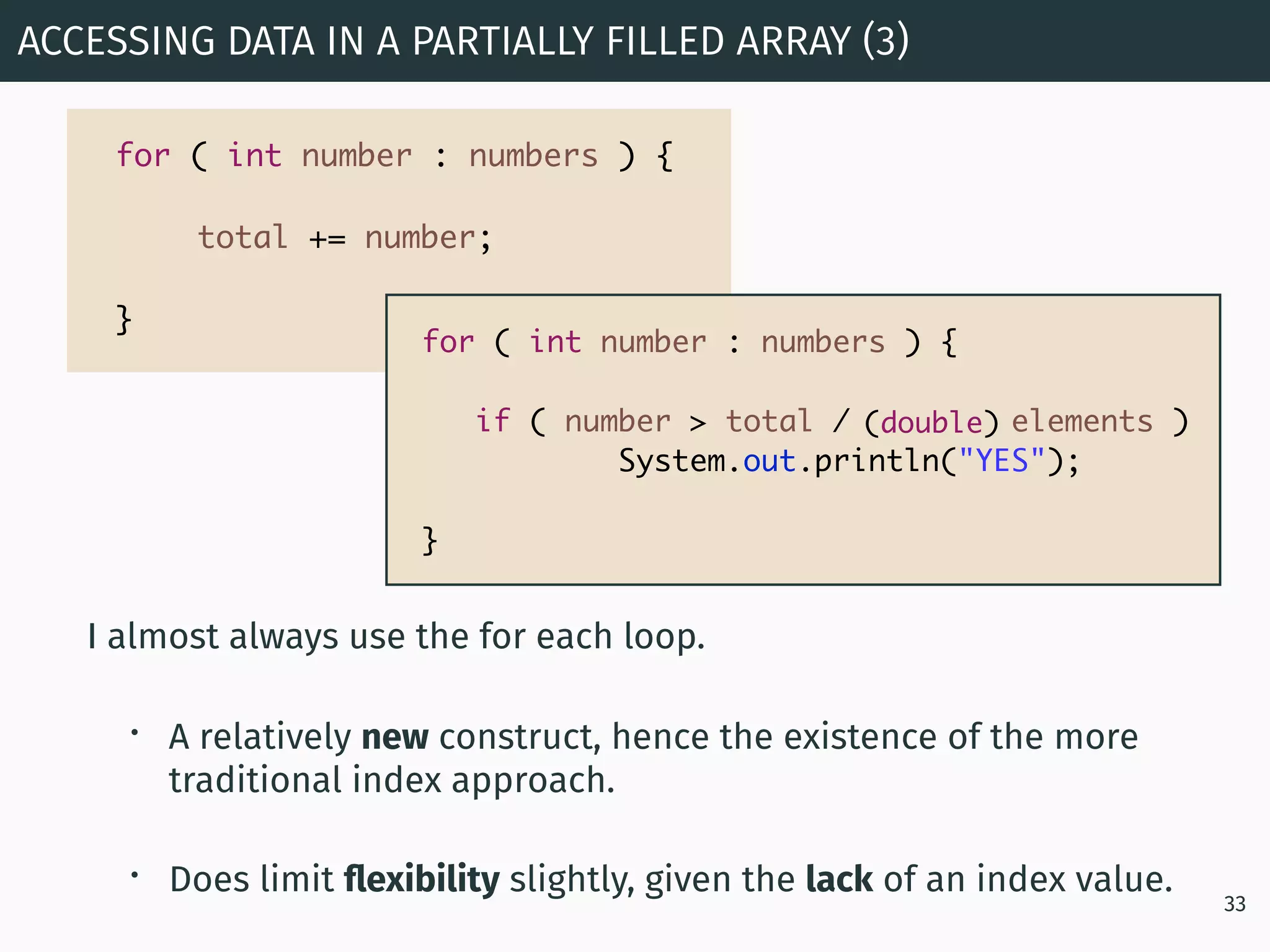
![If we were to fill partially fill an array with a certain number of values, but then accidentally access an index that was within the size of the array, but not manually filled, what would happen? • We would not be given an error, but instead a zero would be printed. • Arrays of a primitive type contain default values. ACCESSING DATA IN A PARTIALLY FILLED ARRAY (4) 34 int[] numbers = new int[100]; for ( int i = 0; i < 50; i++) { numbers[ i ] = i; } System.out.println(numbers[50]);](https://image.slidesharecdn.com/9wt4em3btiqhrbnptnkk-signature-1d71bc69af8e1ce5cfd06165f1692fb262b99bc72e1cbb4e076cc65ccd63e69f-poli-180215150739/75/Programming-in-Java-Arrays-34-2048.jpg)
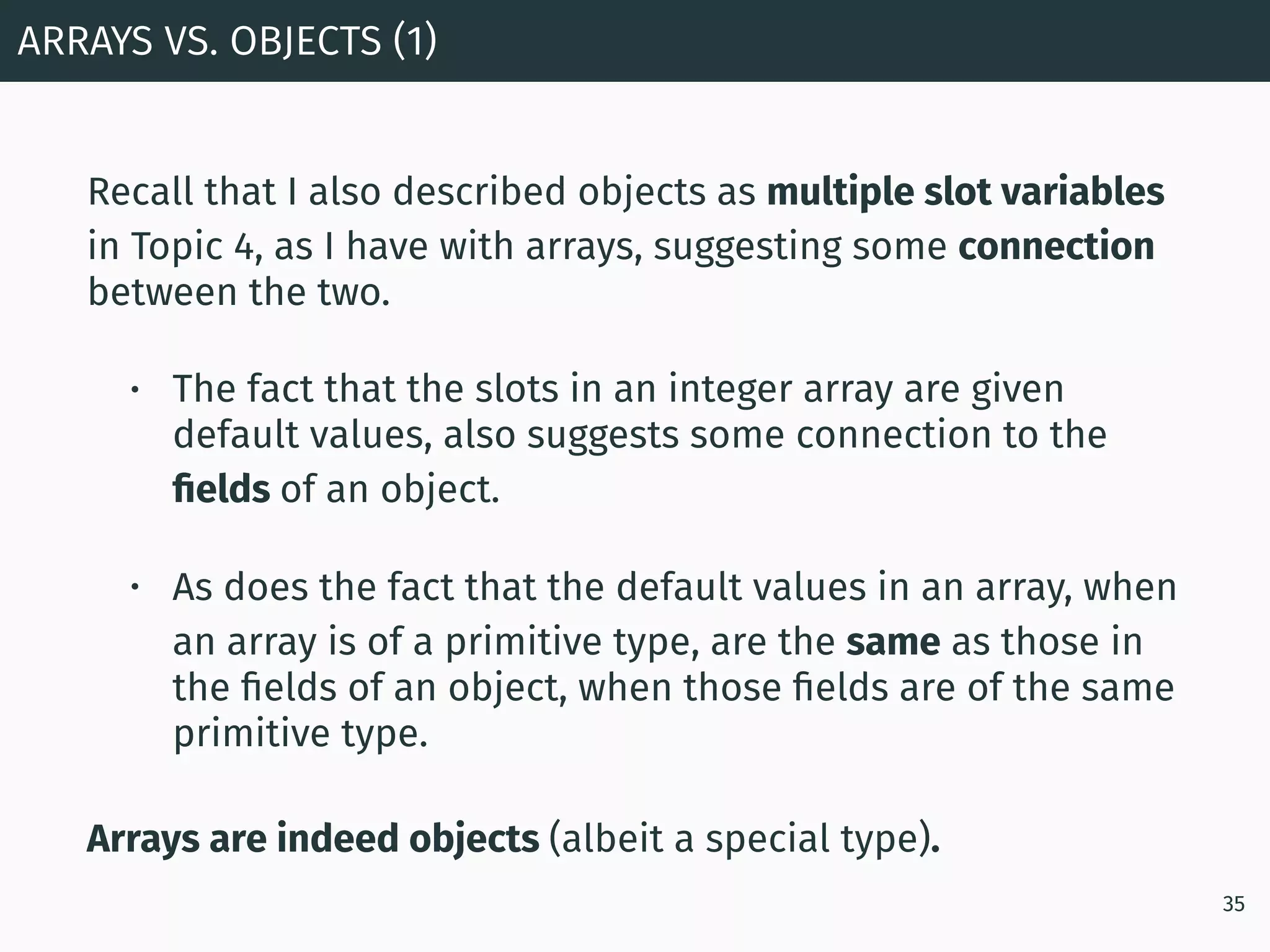
![The array types themselves (e.g. int[], boolean[]) aren’t physical classes, but instead simulated runtime classes provided to us by the JVM, that have certain properties that are similar to those demonstrated by actual classes. • The use of the new command. • New copies to store different data. • Default field values (mentioned). • Public (immutable) fields. ARRAYS VS. OBJECTS (2) 36 numbers.length int[] numbers = new int[4];](https://image.slidesharecdn.com/9wt4em3btiqhrbnptnkk-signature-1d71bc69af8e1ce5cfd06165f1692fb262b99bc72e1cbb4e076cc65ccd63e69f-poli-180215150739/75/Programming-in-Java-Arrays-36-2048.jpg)
![Recall that in Topic 4 we determined that primitive types can be replaced with class types. This idea doesn’t stop with arrays. ARRAYS OF OBJECTS (1) 37 We can, as we might expect, connect a set of objects in an array. Indeed, we’ve had an example of this right under our noses for quite some time: int[] numbers = new int[4]; private Dish[] starterMainDessert = new Dish[3]; String[] args](https://image.slidesharecdn.com/9wt4em3btiqhrbnptnkk-signature-1d71bc69af8e1ce5cfd06165f1692fb262b99bc72e1cbb4e076cc65ccd63e69f-poli-180215150739/75/Programming-in-Java-Arrays-37-2048.jpg)
![We now know a even more about main. • We know that main can never return anything (where would it go anyway?) • This is a parameter, so main must accept some information. • But unfortunately, we still aren’t in a position to discuss what is passed to the main method. REMEMBER: BACK TO MAIN 38 public static void main(String[] args) { • We know that main has to be visible from outside the class, so that it can be run by the JVM (Topic 4). • We know that main can be accessed without having to make an object of our driver class, which makes things easier for the JVM.](https://image.slidesharecdn.com/9wt4em3btiqhrbnptnkk-signature-1d71bc69af8e1ce5cfd06165f1692fb262b99bc72e1cbb4e076cc65ccd63e69f-poli-180215150739/75/Programming-in-Java-Arrays-38-2048.jpg)
![We now know everything about main. • We know that main can never return anything (where would it go anyway?) • This is a String array, which is passed to the main method. • We know that main has to be visible from outside the class, so that it can be run by the JVM (Topic 4). • We know that main can be accessed without having to make an object of our driver class, which makes things easier for the JVM (Topic 6). REMEMBER: BACK TO MAIN 39 public static void main(String[] args) {](https://image.slidesharecdn.com/9wt4em3btiqhrbnptnkk-signature-1d71bc69af8e1ce5cfd06165f1692fb262b99bc72e1cbb4e076cc65ccd63e69f-poli-180215150739/75/Programming-in-Java-Arrays-39-2048.jpg)
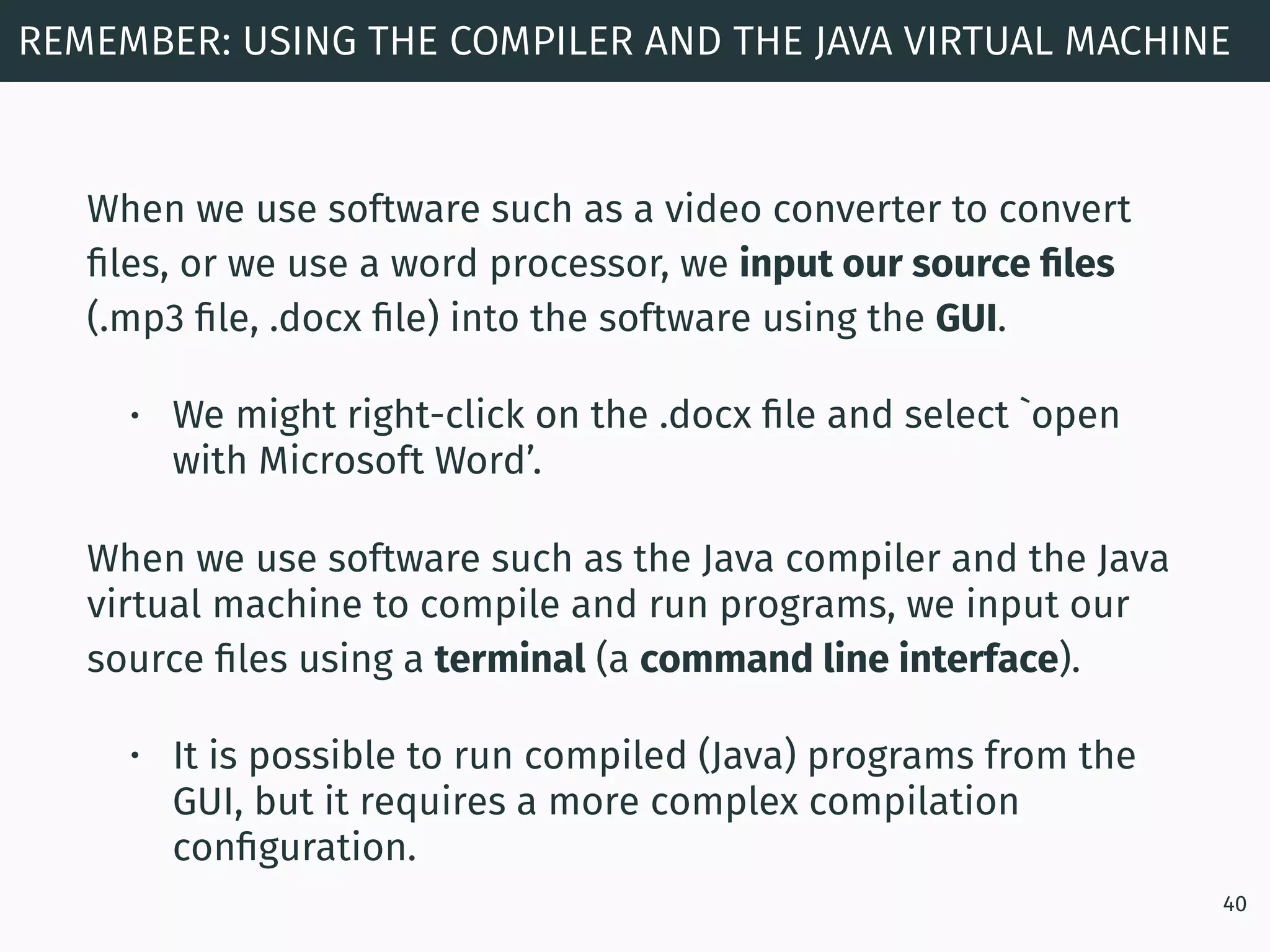
![Each token we write after the name of our compiled program when we pass it to the Java virtual machine, will be passed, token-by-token, to each index of the args array. COMMAND LINE ARGUMENTS (1) 41 public class CommandLineArguments { public static void main(String[] args) { System.out.println(args.length); for ( String argument: args ) { System.out.println(argument); } } }](https://image.slidesharecdn.com/9wt4em3btiqhrbnptnkk-signature-1d71bc69af8e1ce5cfd06165f1692fb262b99bc72e1cbb4e076cc65ccd63e69f-poli-180215150739/75/Programming-in-Java-Arrays-41-2048.jpg)
![COMMAND LINE ARGUMENTS (2) 42 32 54 67 29 [0] [1] [2] [3] [4] Hello My Name Is Martin Each token we write after the name of our compiled program when we pass it to the Java virtual machine, will be passed, token-by-token, to each index of the args array.](https://image.slidesharecdn.com/9wt4em3btiqhrbnptnkk-signature-1d71bc69af8e1ce5cfd06165f1692fb262b99bc72e1cbb4e076cc65ccd63e69f-poli-180215150739/75/Programming-in-Java-Arrays-42-2048.jpg)
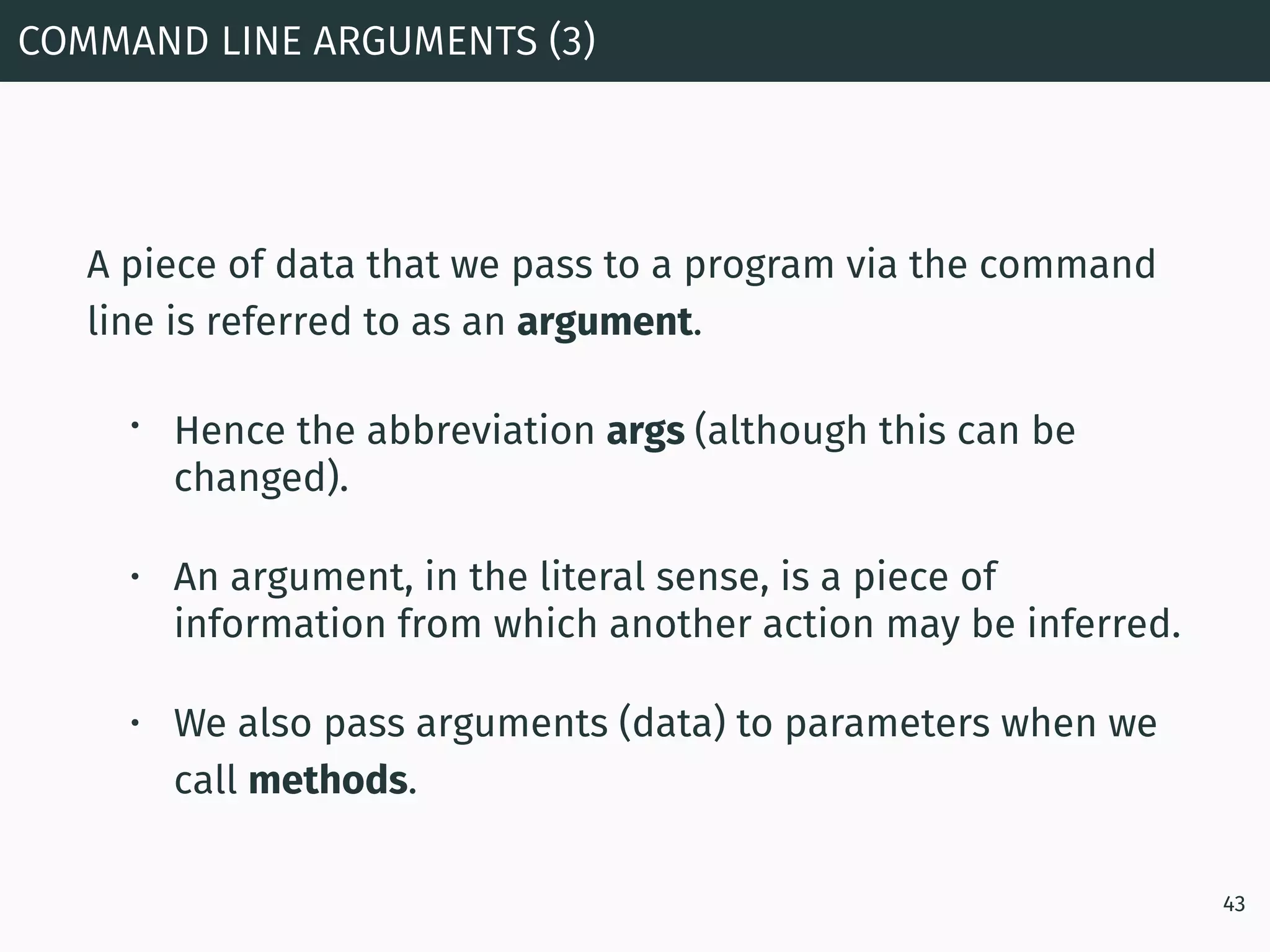
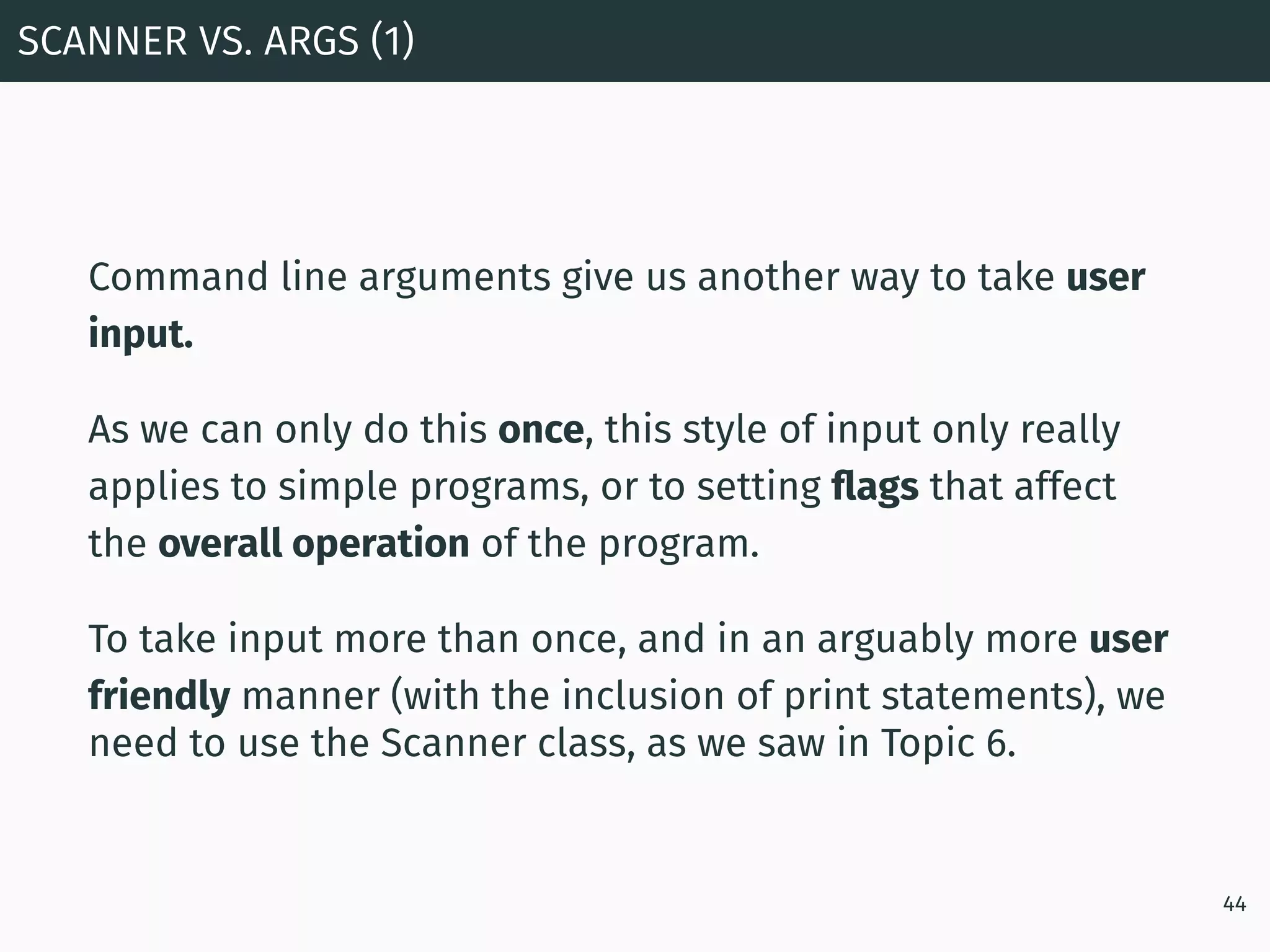
![😴 SCANNER VS. ARGS (2): SIMPLE PROGRAMS 45 public class Adder { public static void main(String[] args) { if ( args.length == 2 ) { System.out.println(Integer.parseInt(args[0]) + Integer.parseInt(args[1])); } } } Another Library class enabling the conversion of strings to integers. We will return to look at this class and this idea. Even if we enter numbers into the command line, each token is always treated as a string.](https://image.slidesharecdn.com/9wt4em3btiqhrbnptnkk-signature-1d71bc69af8e1ce5cfd06165f1692fb262b99bc72e1cbb4e076cc65ccd63e69f-poli-180215150739/75/Programming-in-Java-Arrays-45-2048.jpg)
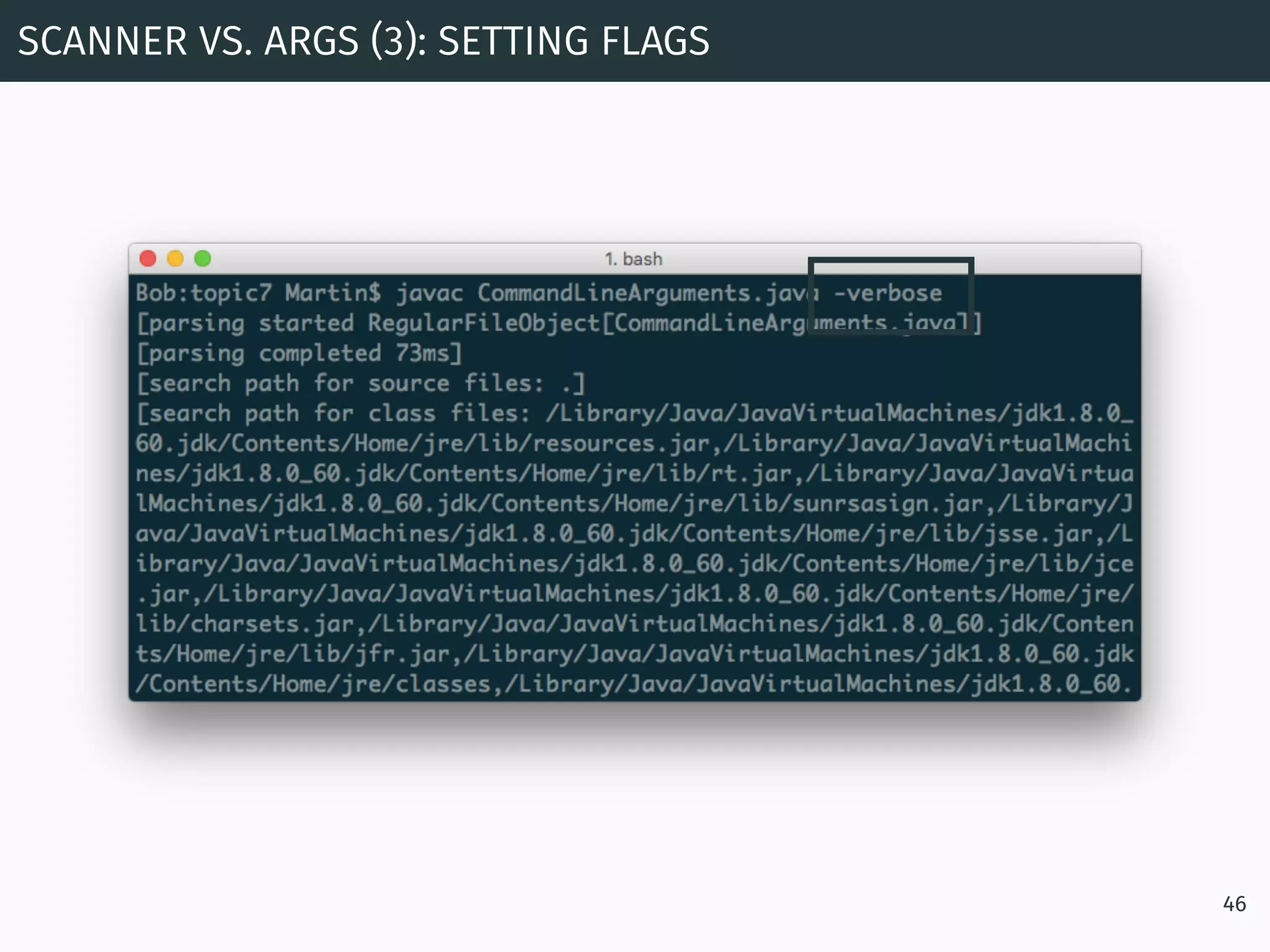
![REMEMBER: LECTURE EXERCISE: BLOCKCHAIN (4) - MINER AND BLOCKCHAIN 47 public class Miner { public static void main(String[] args) { Block myBlock = new Block(); Blockchain chain = new Blockchain(); chain.addBlock(myBlock); } } public class Blockchain { public void addBlock(Block block) { } } Keep a list of blocks Add the block to a list How do we do this? On to Topic 7! Back to arrays of objects…](https://image.slidesharecdn.com/9wt4em3btiqhrbnptnkk-signature-1d71bc69af8e1ce5cfd06165f1692fb262b99bc72e1cbb4e076cc65ccd63e69f-poli-180215150739/75/Programming-in-Java-Arrays-47-2048.jpg)
![REMEMBER: LECTURE EXERCISE: BLOCKCHAIN (4) - MINER AND BLOCKCHAIN 48 public class Miner { public static void main(String[] args) { Block myBlock = new Block(); Blockchain chain = new Blockchain(); chain.addBlock(myBlock); } } public class Blockchain { private Block[] chain; private int blocks; public Blockchain(int chainLength) { chain = new Block[chainLength]; } public void addBlock(Block block) { chain[blocks++] = block; } }](https://image.slidesharecdn.com/9wt4em3btiqhrbnptnkk-signature-1d71bc69af8e1ce5cfd06165f1692fb262b99bc72e1cbb4e076cc65ccd63e69f-poli-180215150739/75/Programming-in-Java-Arrays-48-2048.jpg)
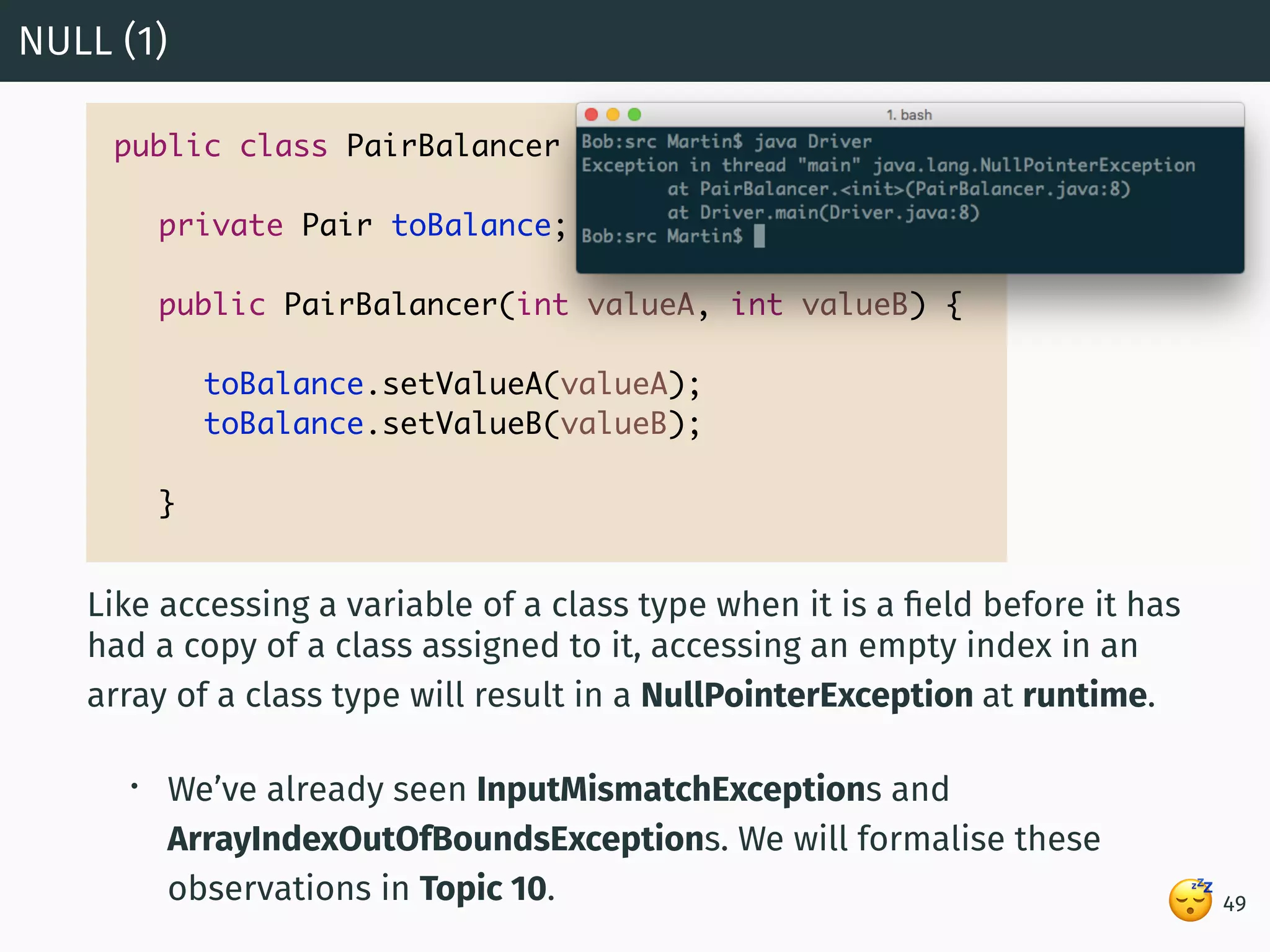
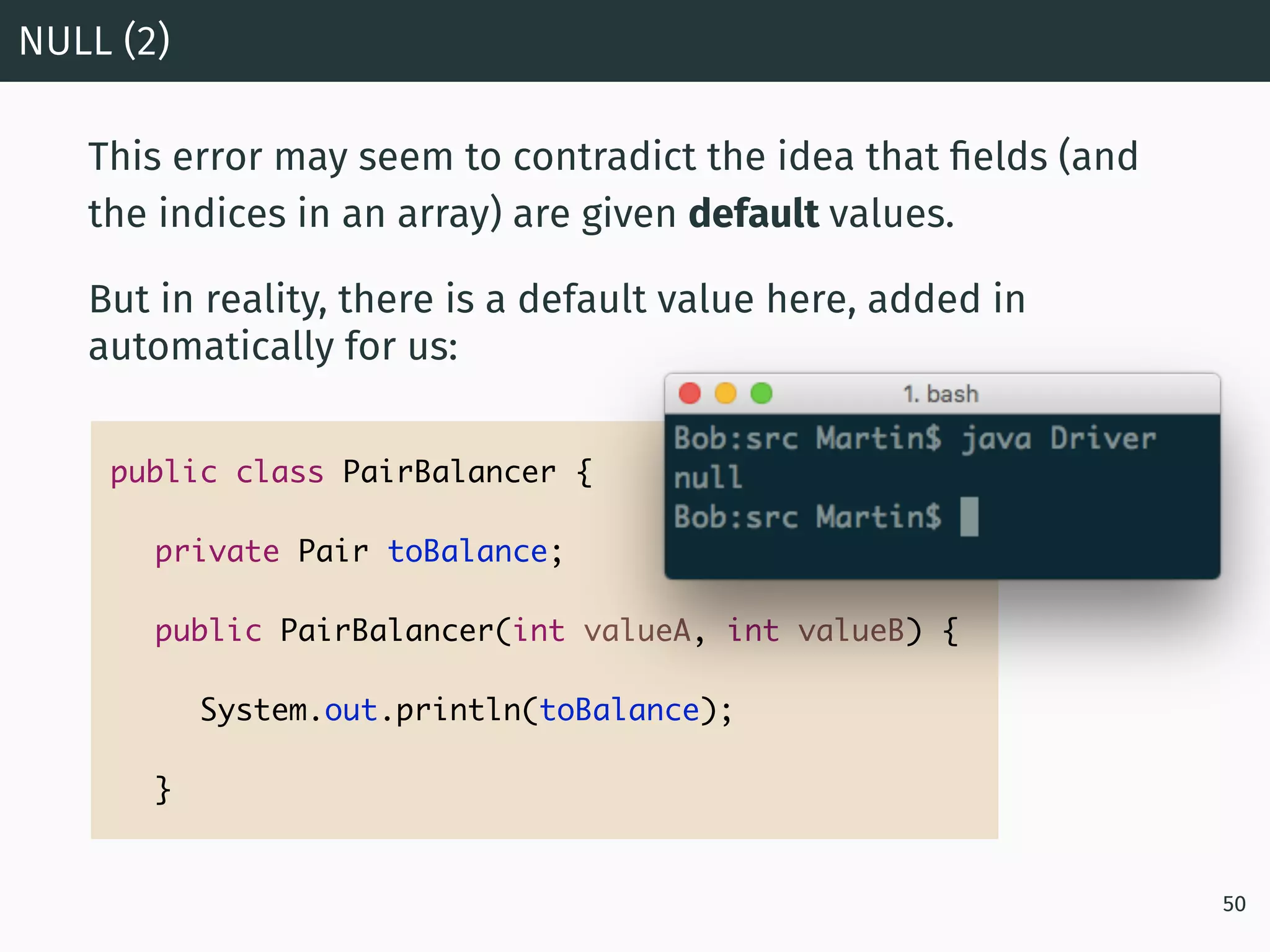
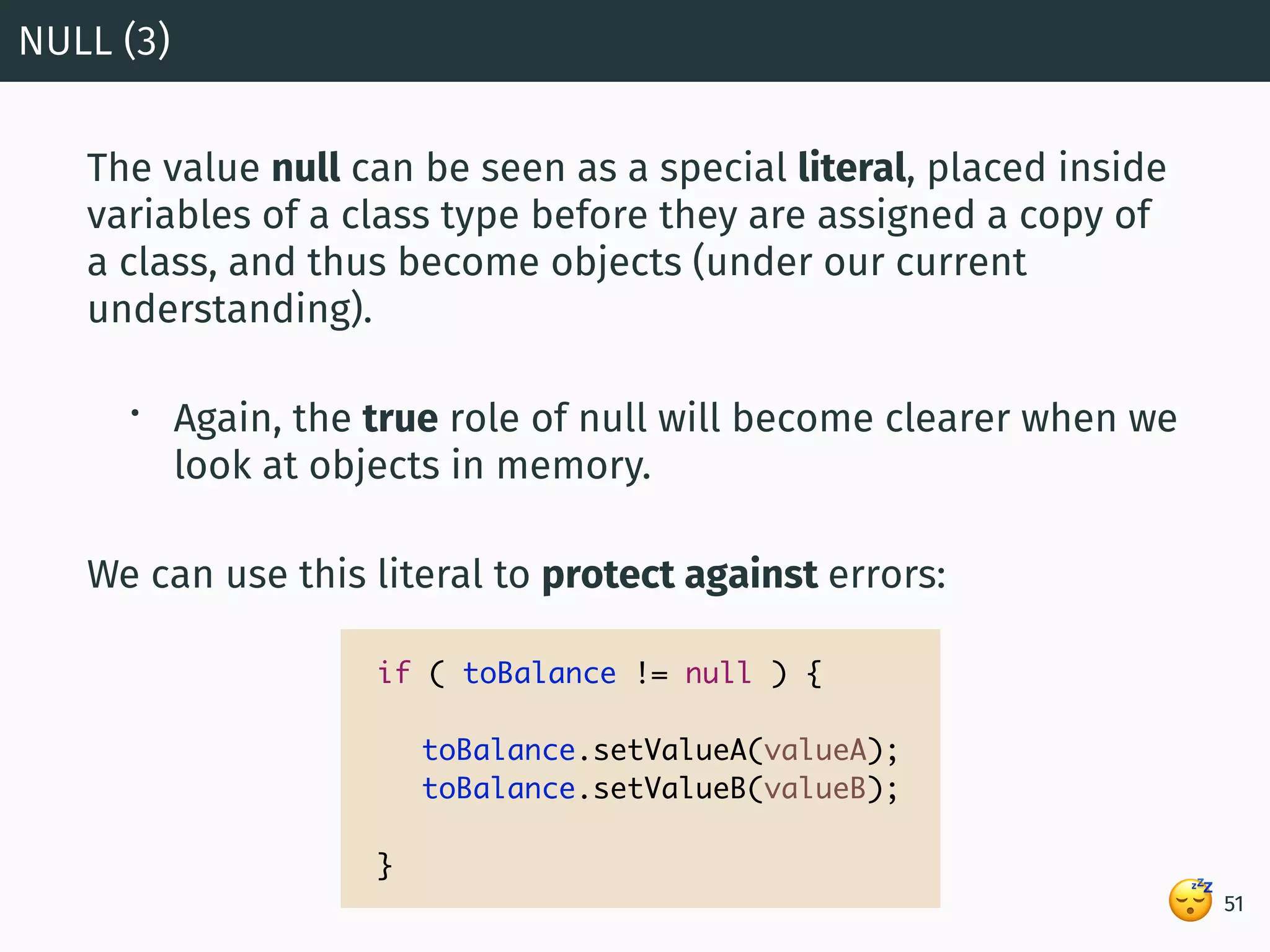
![In the Java library, you’ll find a class called Arrays. ASIDE: THE ARRAYS UTILITY CLASS 52 The class has a number of useful static methods: int[] hulk = new int[10]; int elements = 0; for ( int i = 0; i < 100; i++ ) { if ( elements == hulk.length ) { hulk = Arrays.copyOf(hulk, hulk.length * 2); } hulk[elements++] = i; } System.out.println(Arrays.toString(hulk)); Double the size of the array as necessary (not particularly neat). Print the content of the array. Open question: what happens if we print the array directly? import java.util.Arrays;](https://image.slidesharecdn.com/9wt4em3btiqhrbnptnkk-signature-1d71bc69af8e1ce5cfd06165f1692fb262b99bc72e1cbb4e076cc65ccd63e69f-poli-180215150739/75/Programming-in-Java-Arrays-52-2048.jpg)
![Given the array of numbers we had earlier: LECTURE EXERCISE: LARGEST NUMBER (1) 53 Write a program that identifies the largest number in the list. int[] numbers = { 32, 54, 68, 30 };](https://image.slidesharecdn.com/9wt4em3btiqhrbnptnkk-signature-1d71bc69af8e1ce5cfd06165f1692fb262b99bc72e1cbb4e076cc65ccd63e69f-poli-180215150739/75/Programming-in-Java-Arrays-53-2048.jpg)
![LECTURE EXERCISE: LARGEST NUMBER (2) 54 int largest = numbers[0]; for ( int i = 1; i < numbers.length; i++ ) { if ( numbers[i] > largest ) { largest = numbers[i]; } } System.out.println("Largest: " + largest);](https://image.slidesharecdn.com/9wt4em3btiqhrbnptnkk-signature-1d71bc69af8e1ce5cfd06165f1692fb262b99bc72e1cbb4e076cc65ccd63e69f-poli-180215150739/75/Programming-in-Java-Arrays-54-2048.jpg)
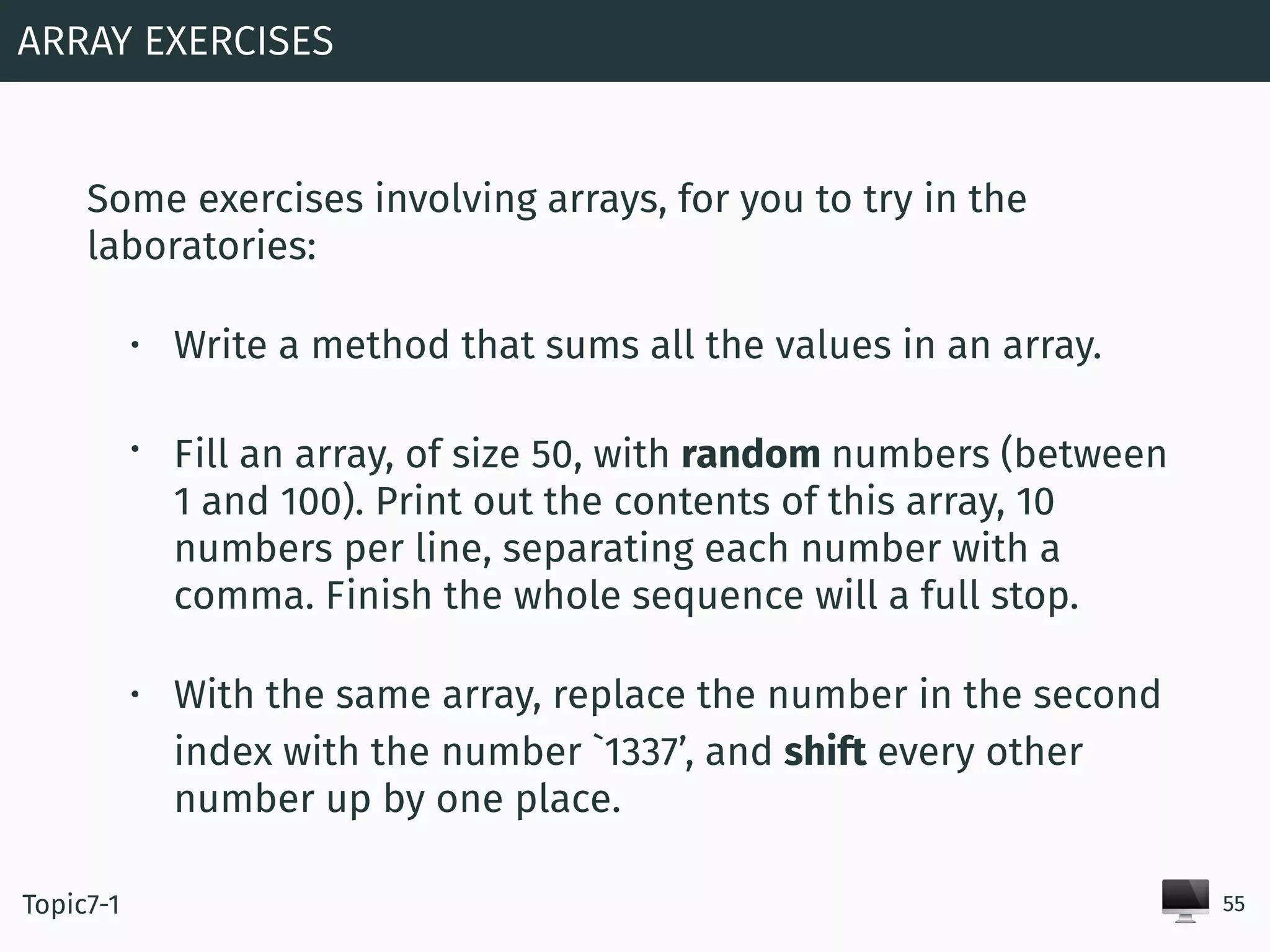

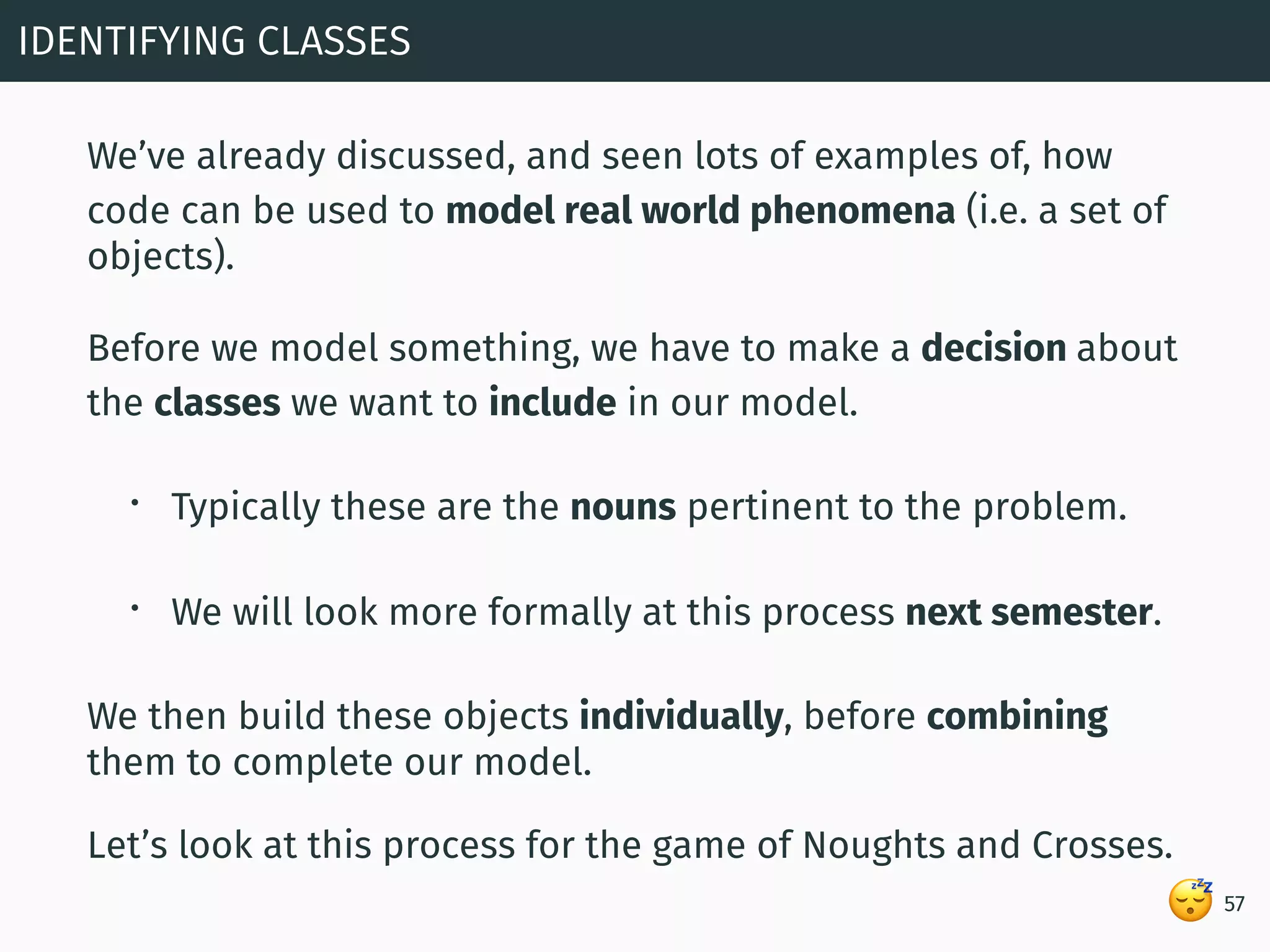
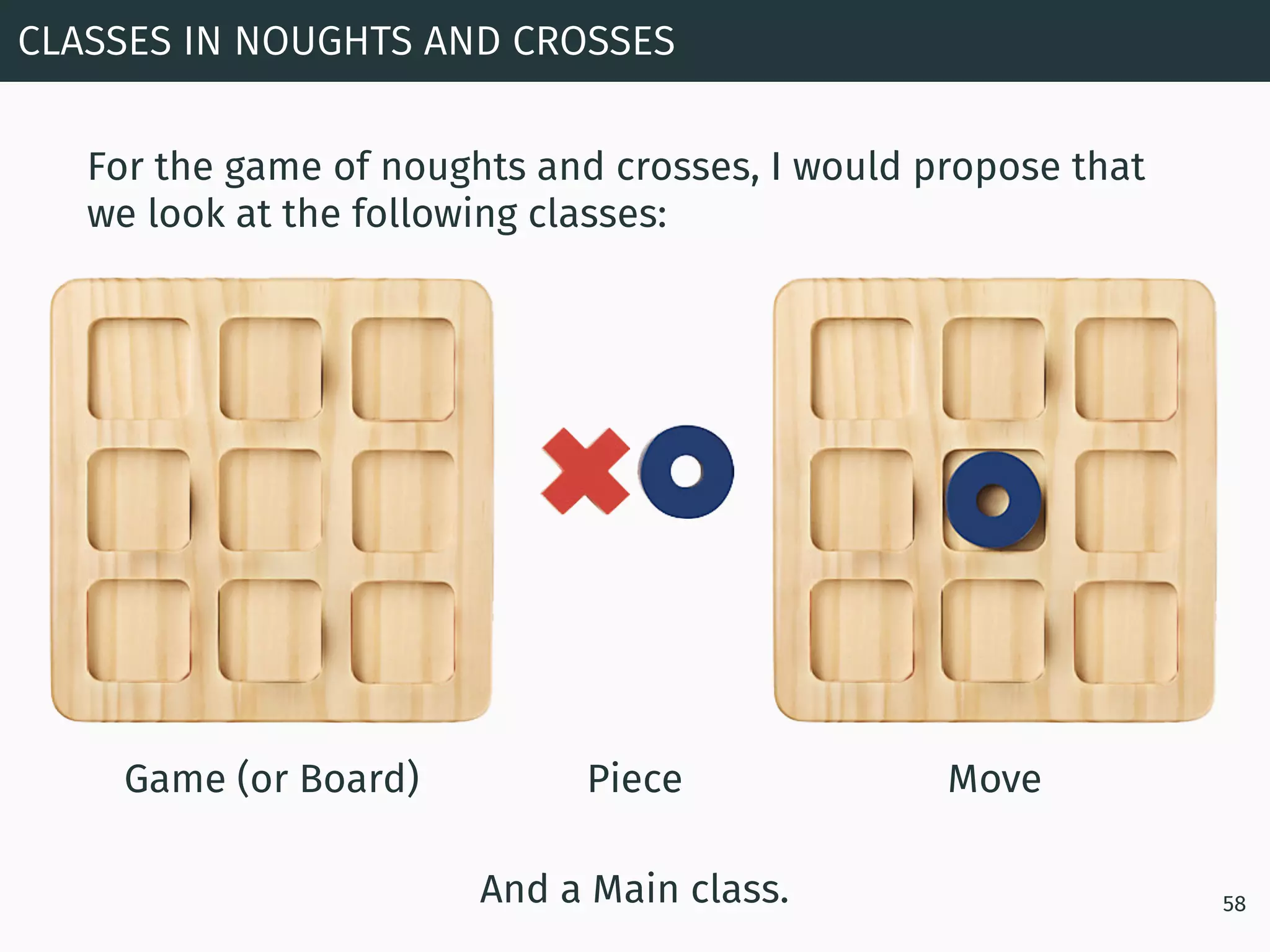
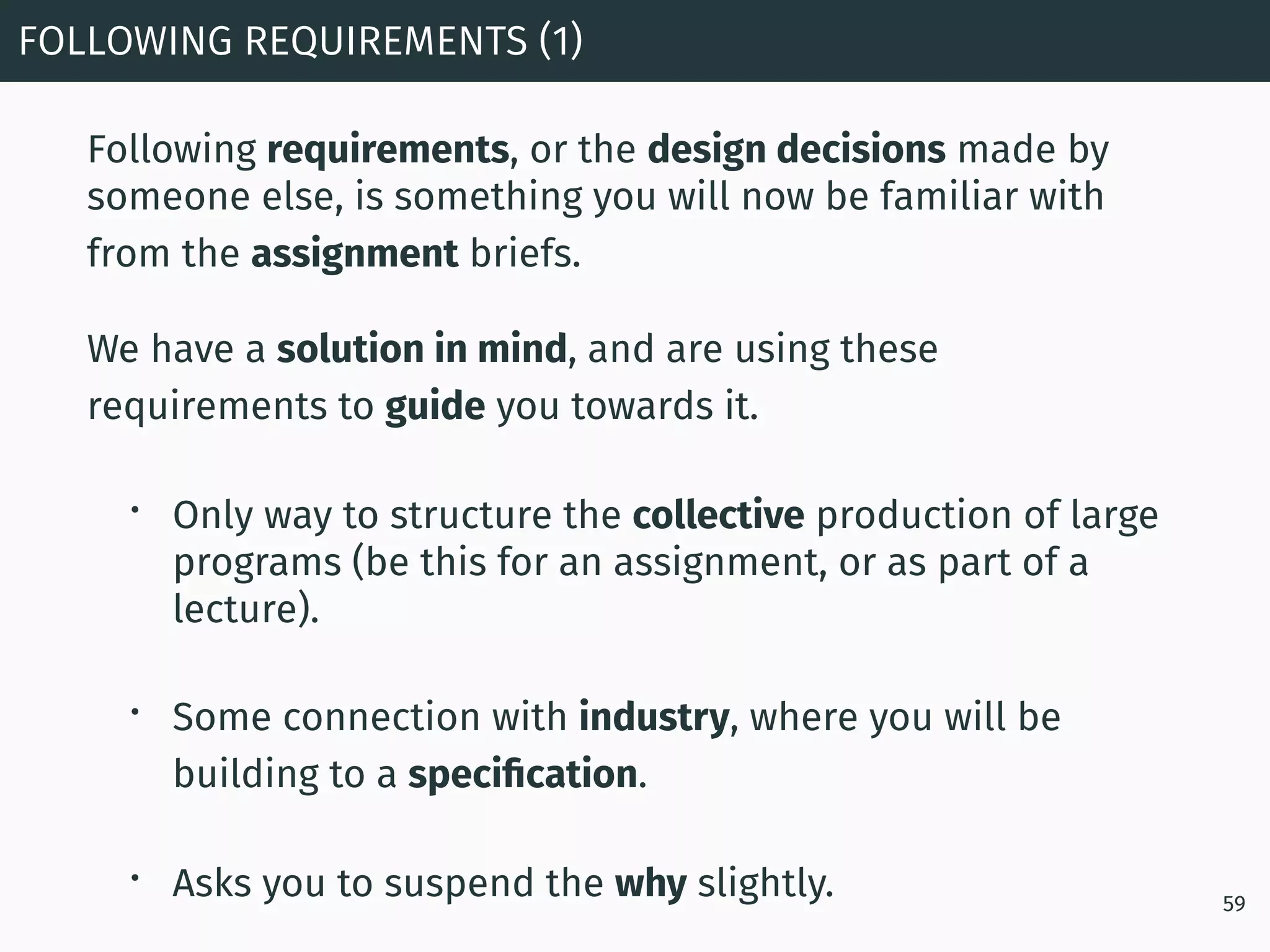
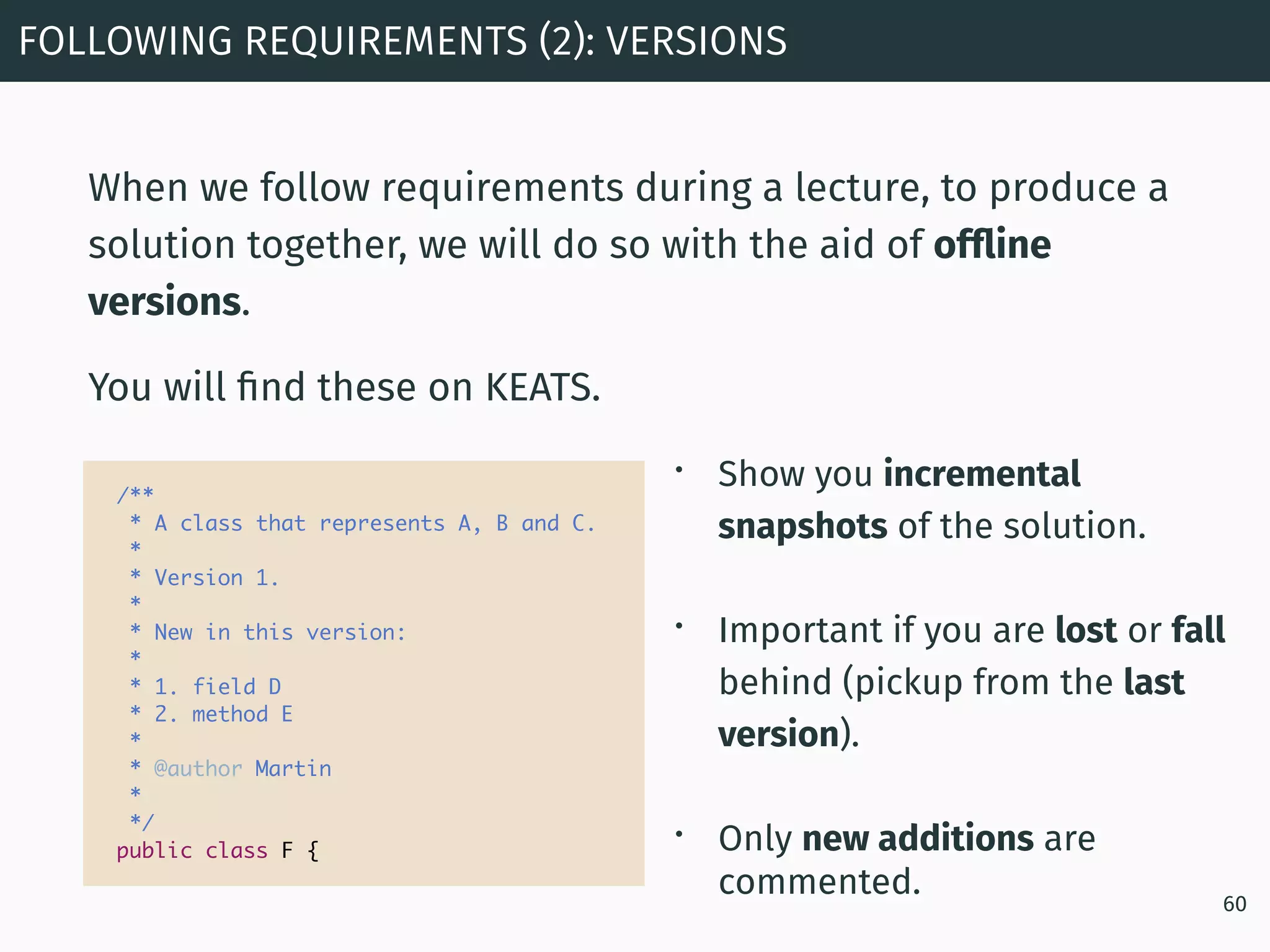
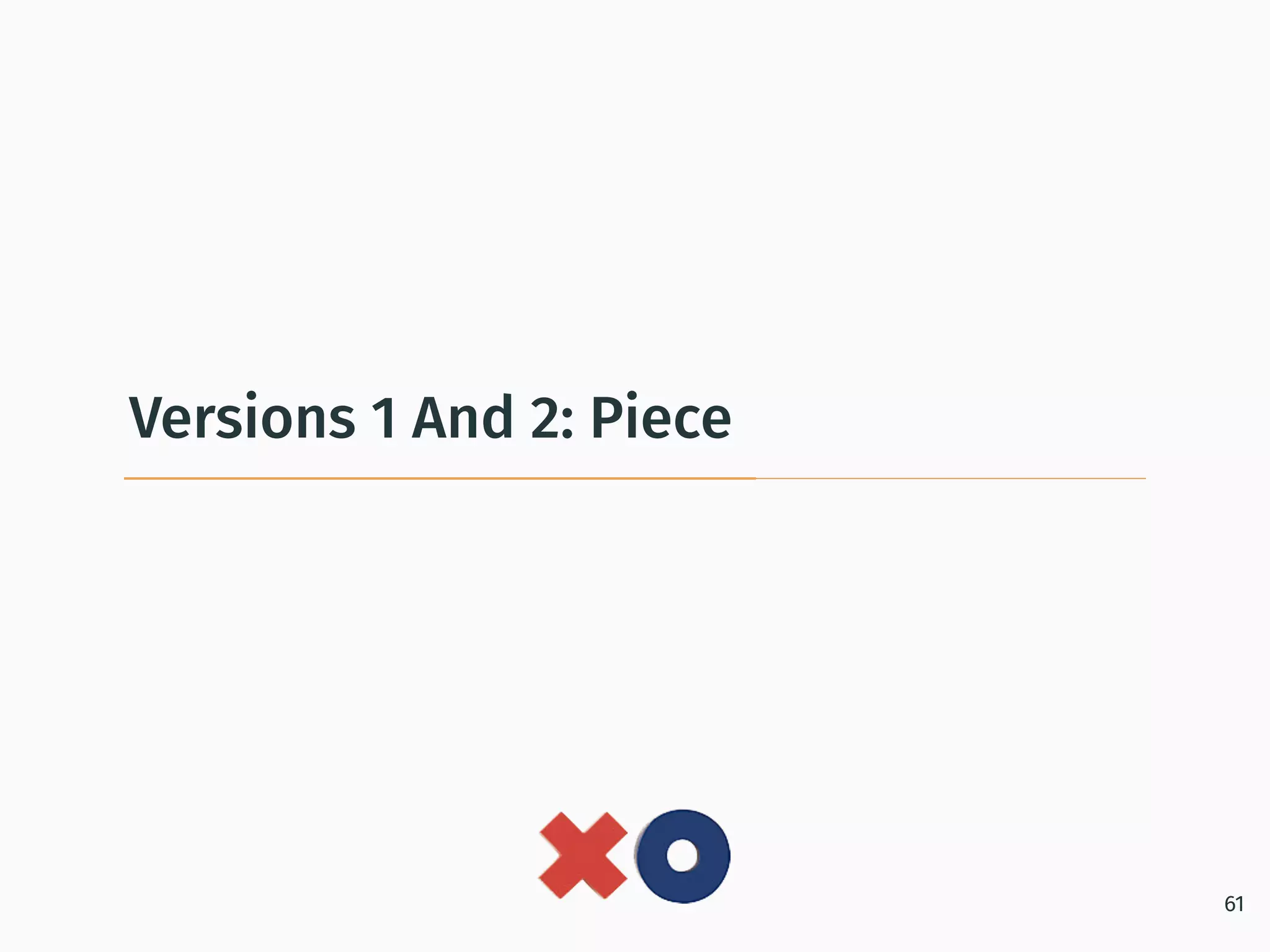
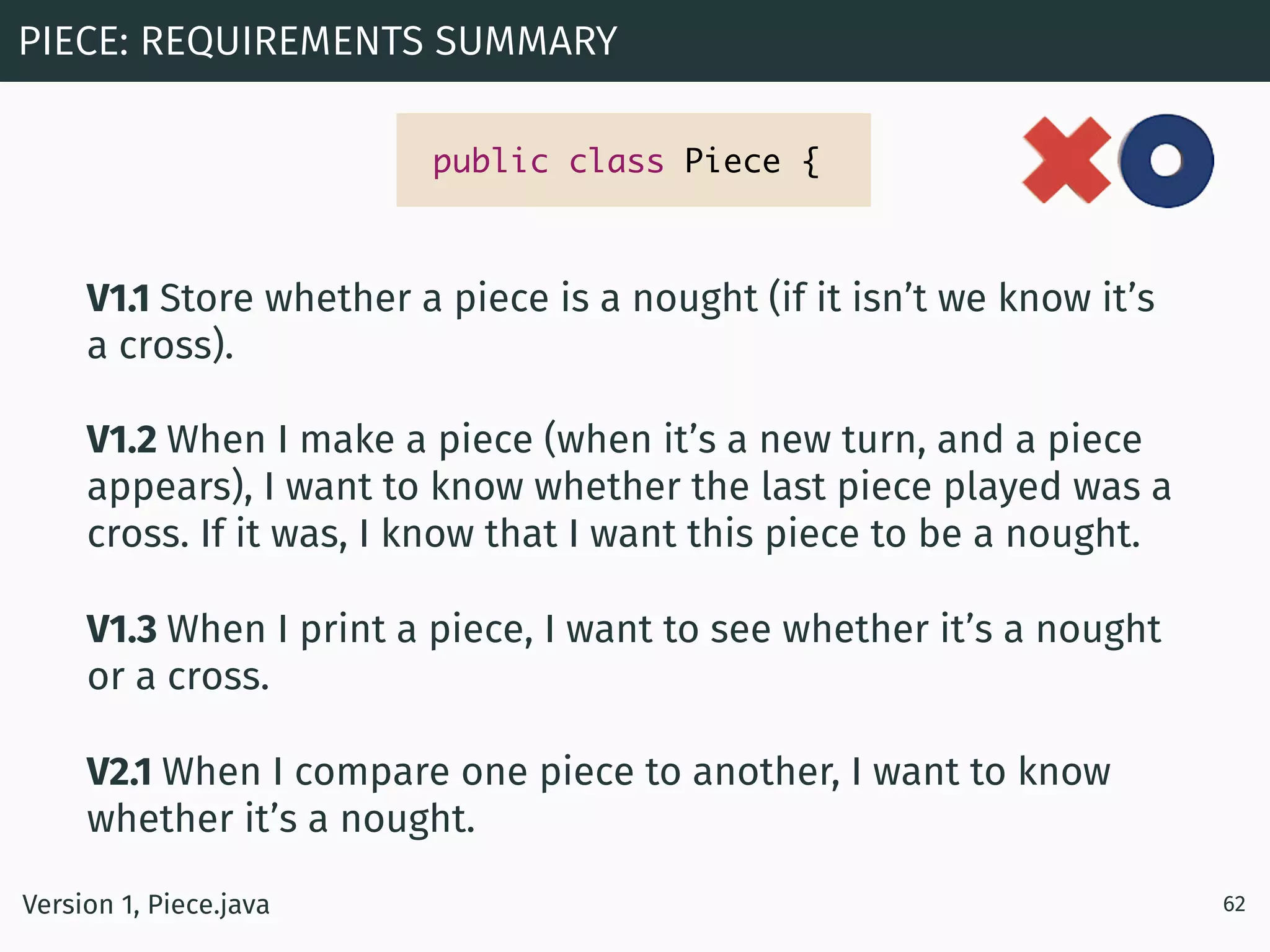
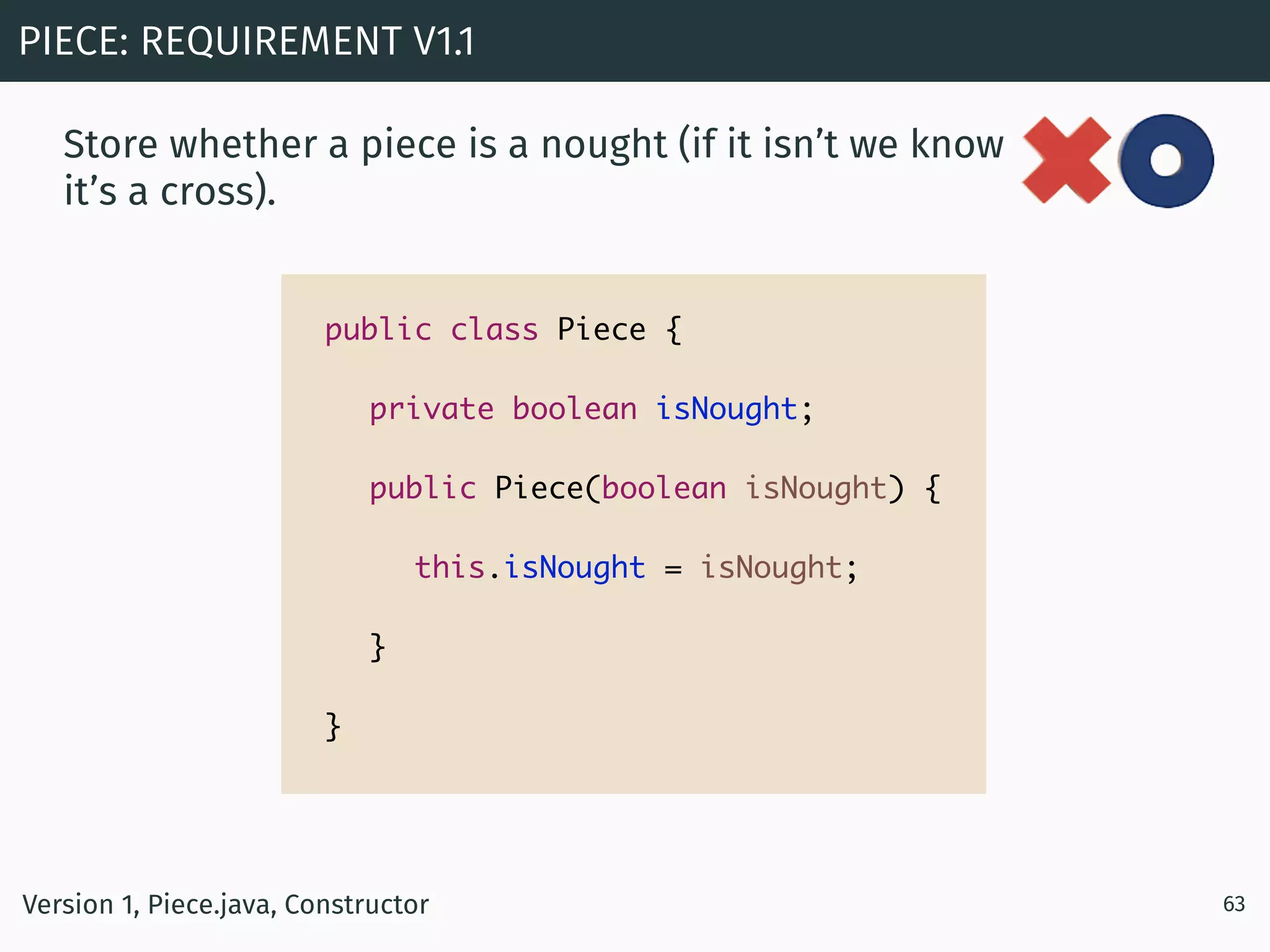
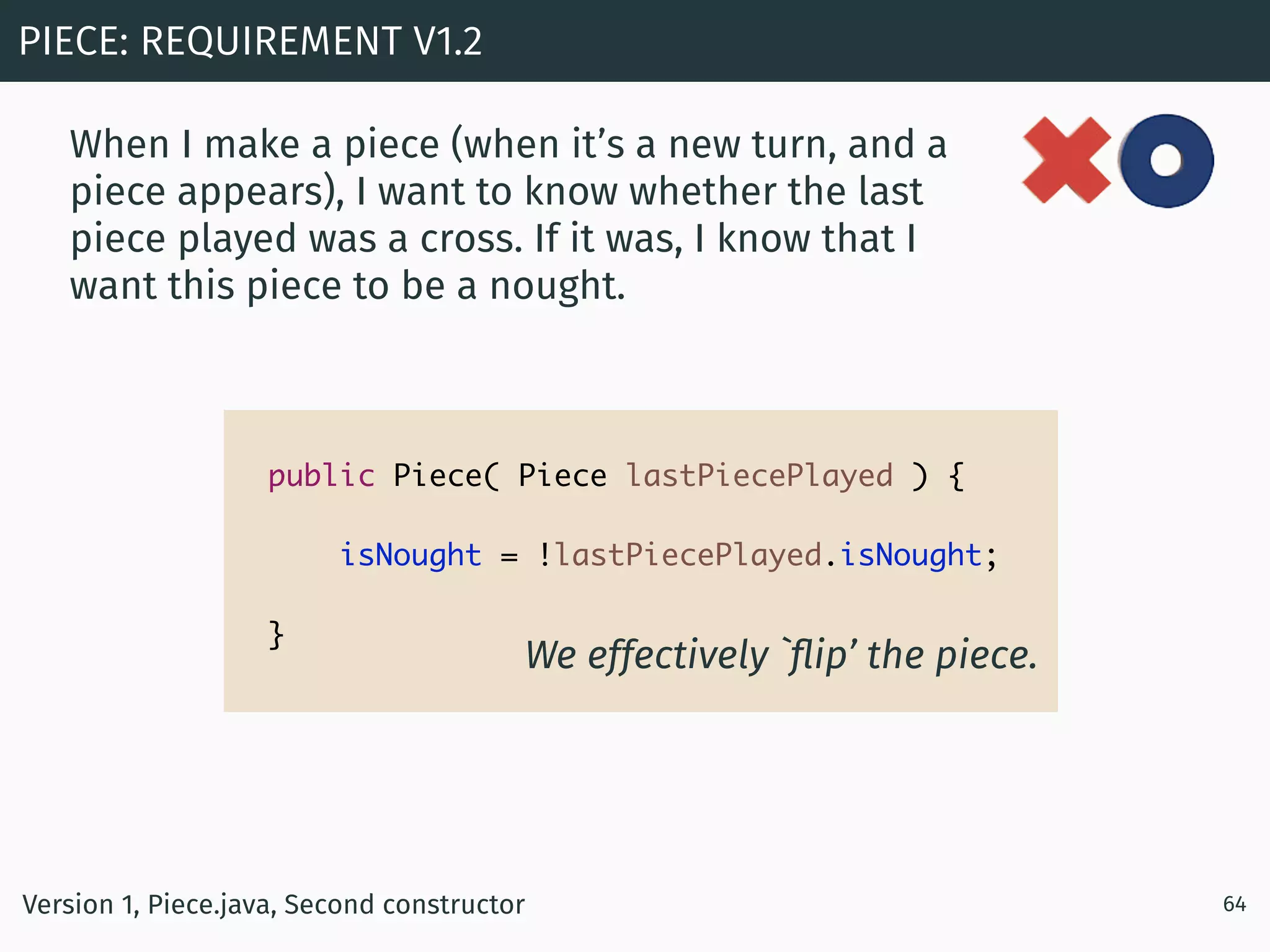
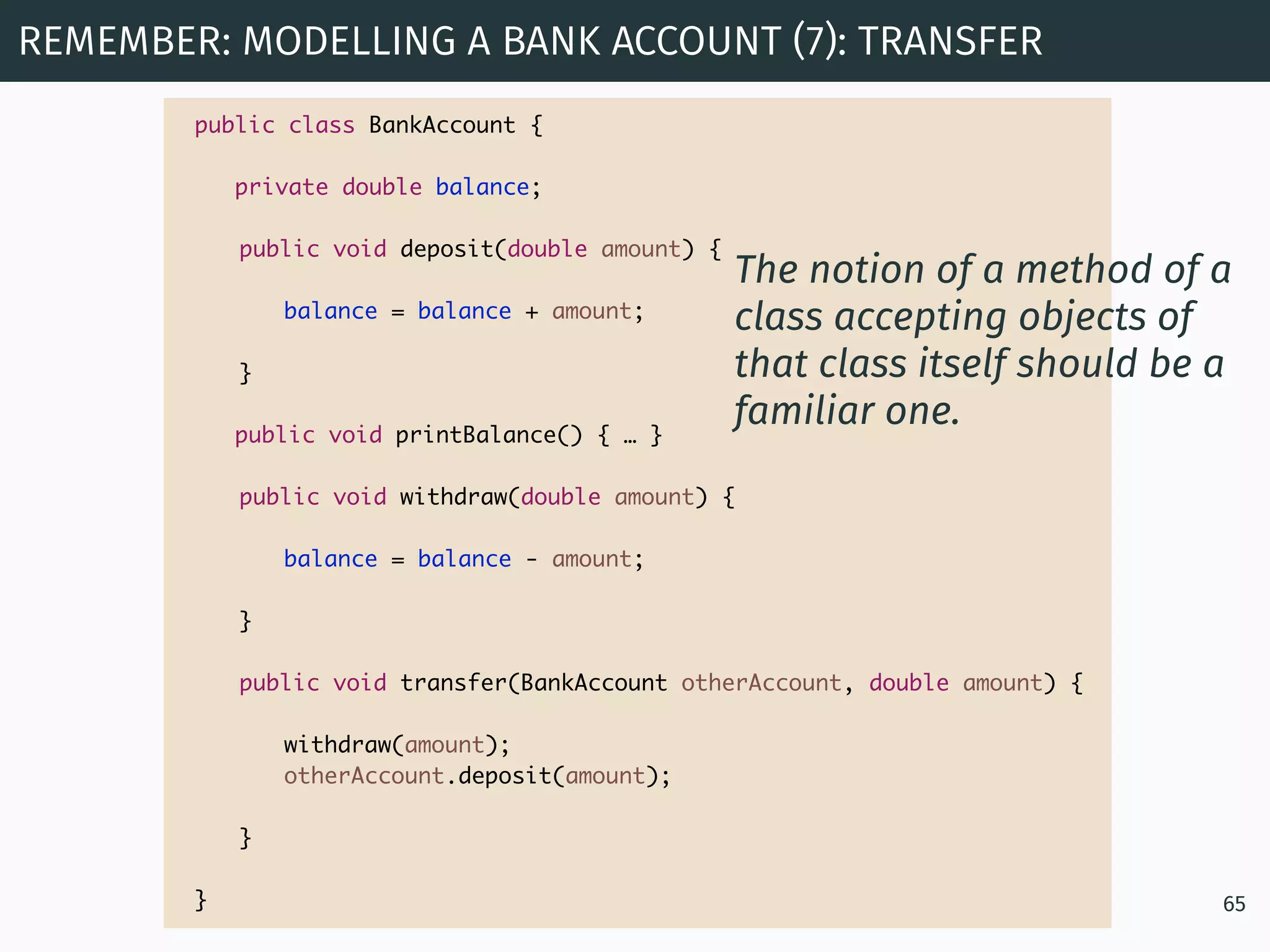
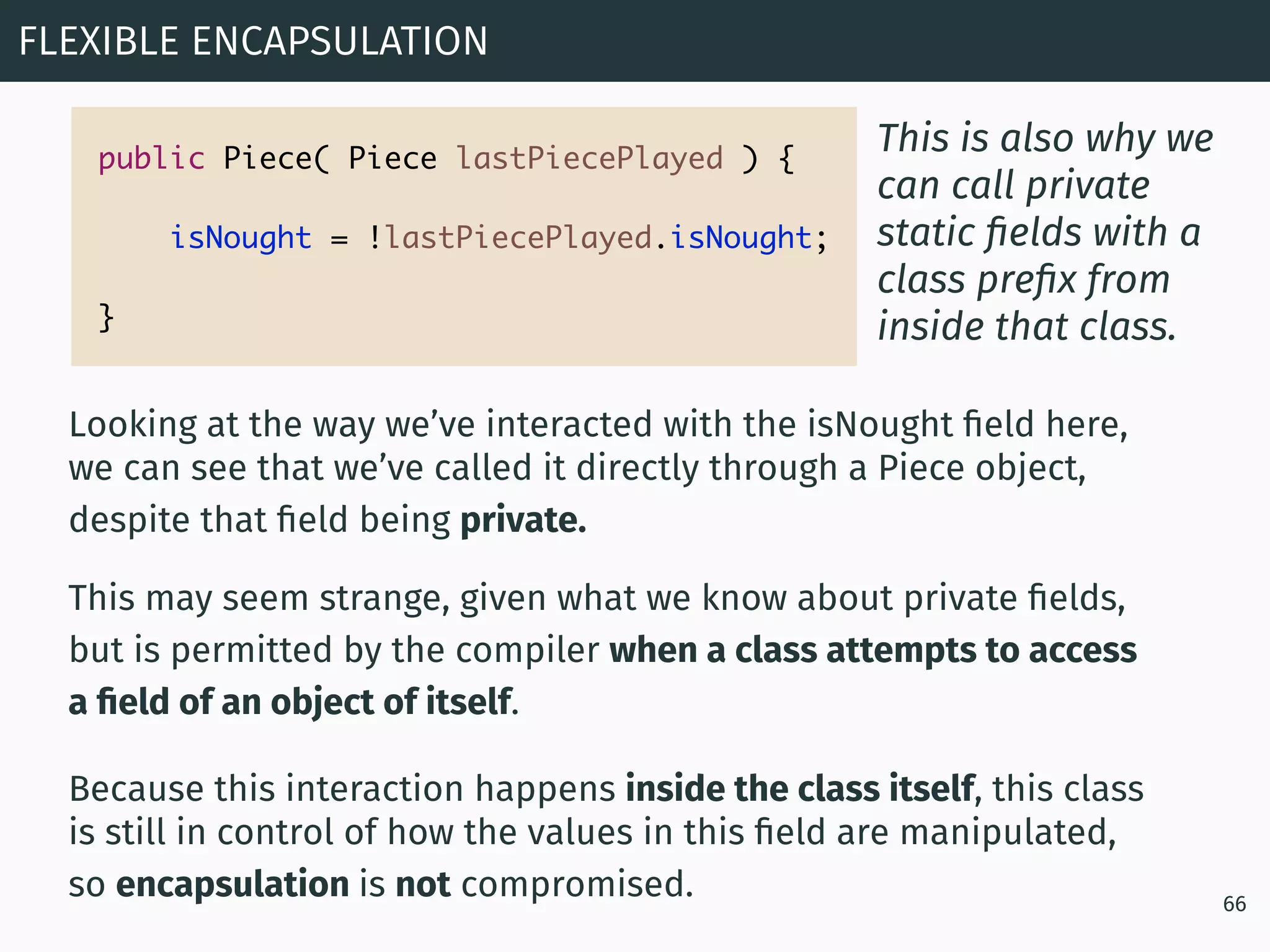
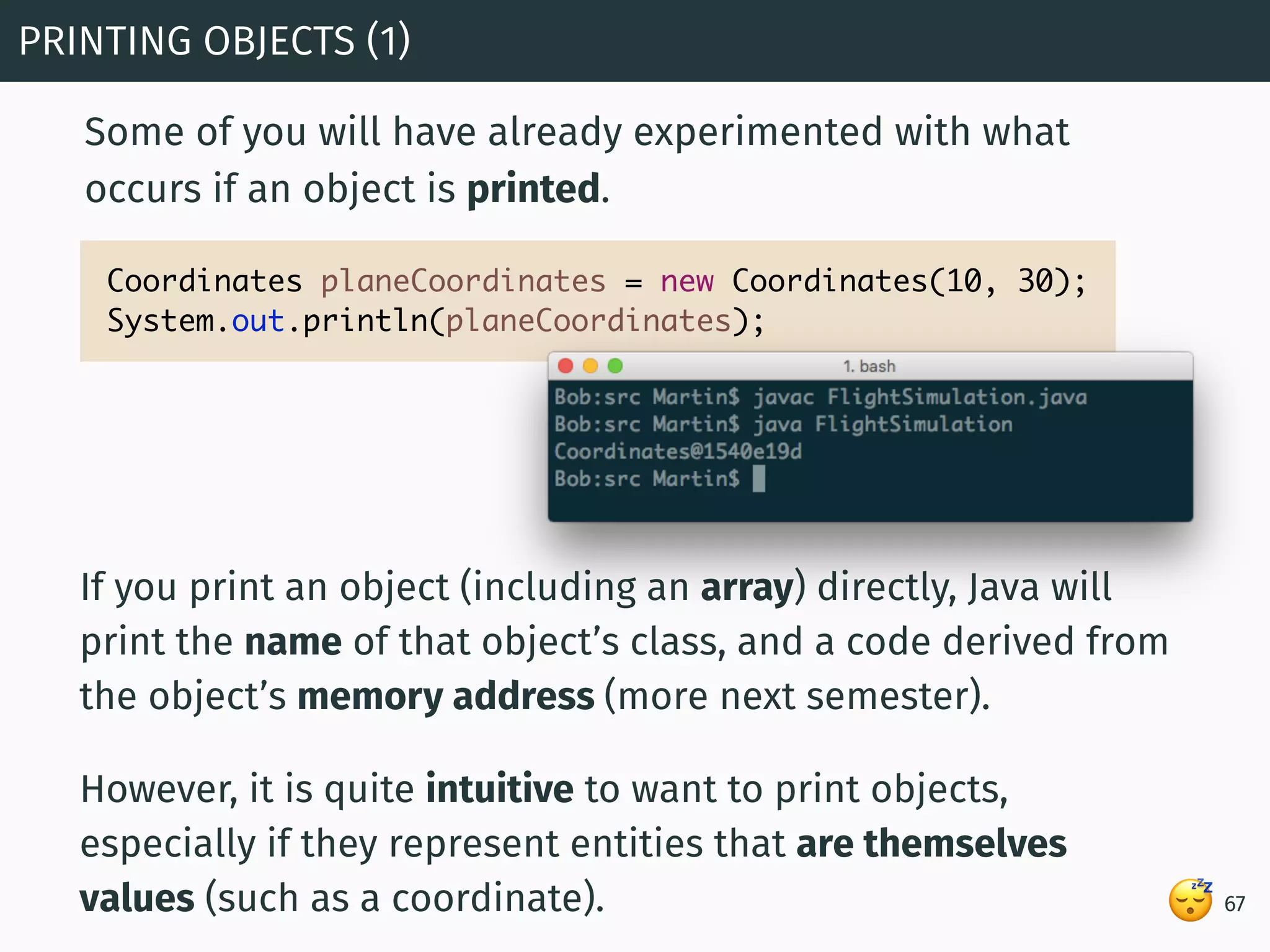
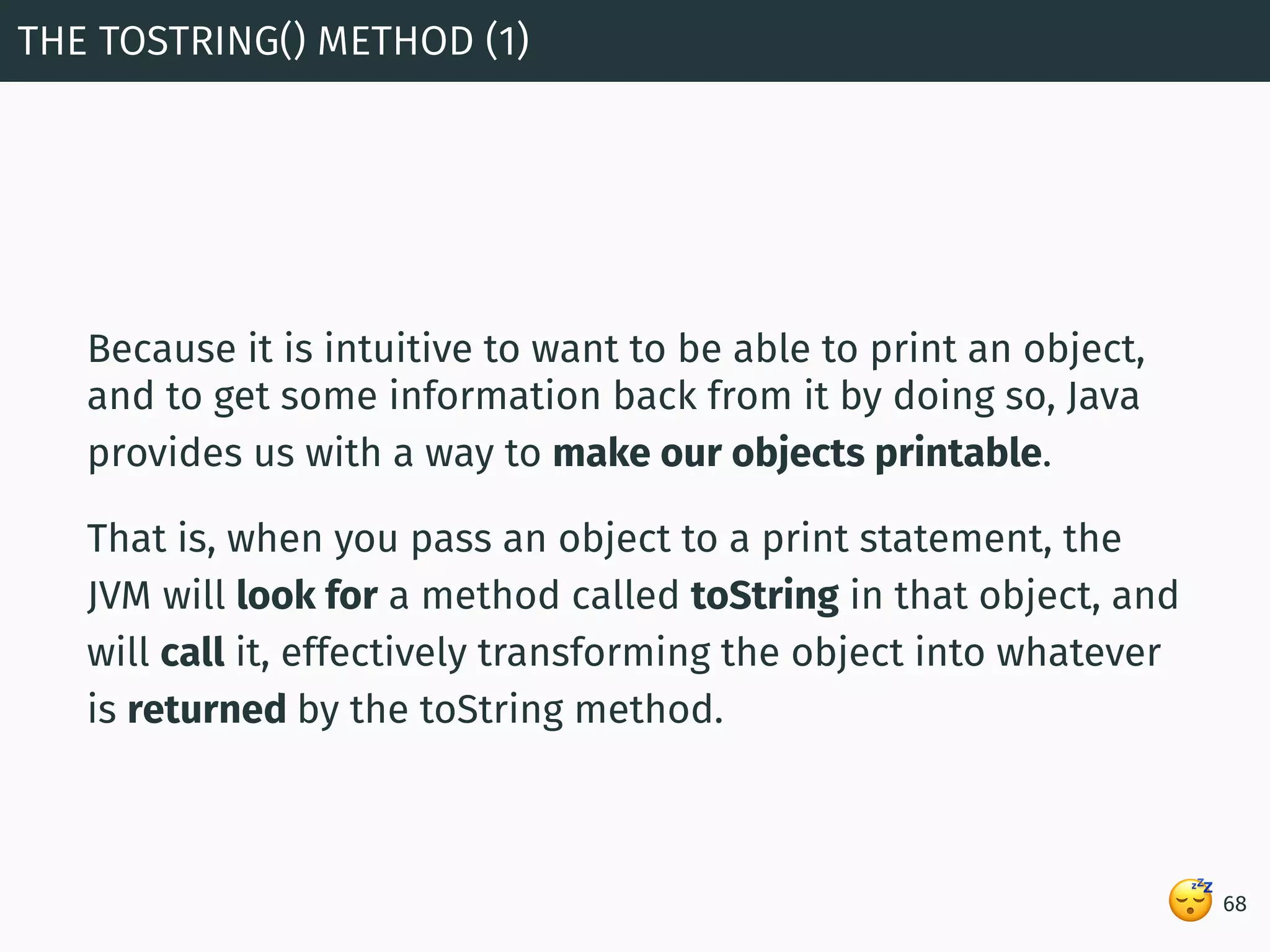
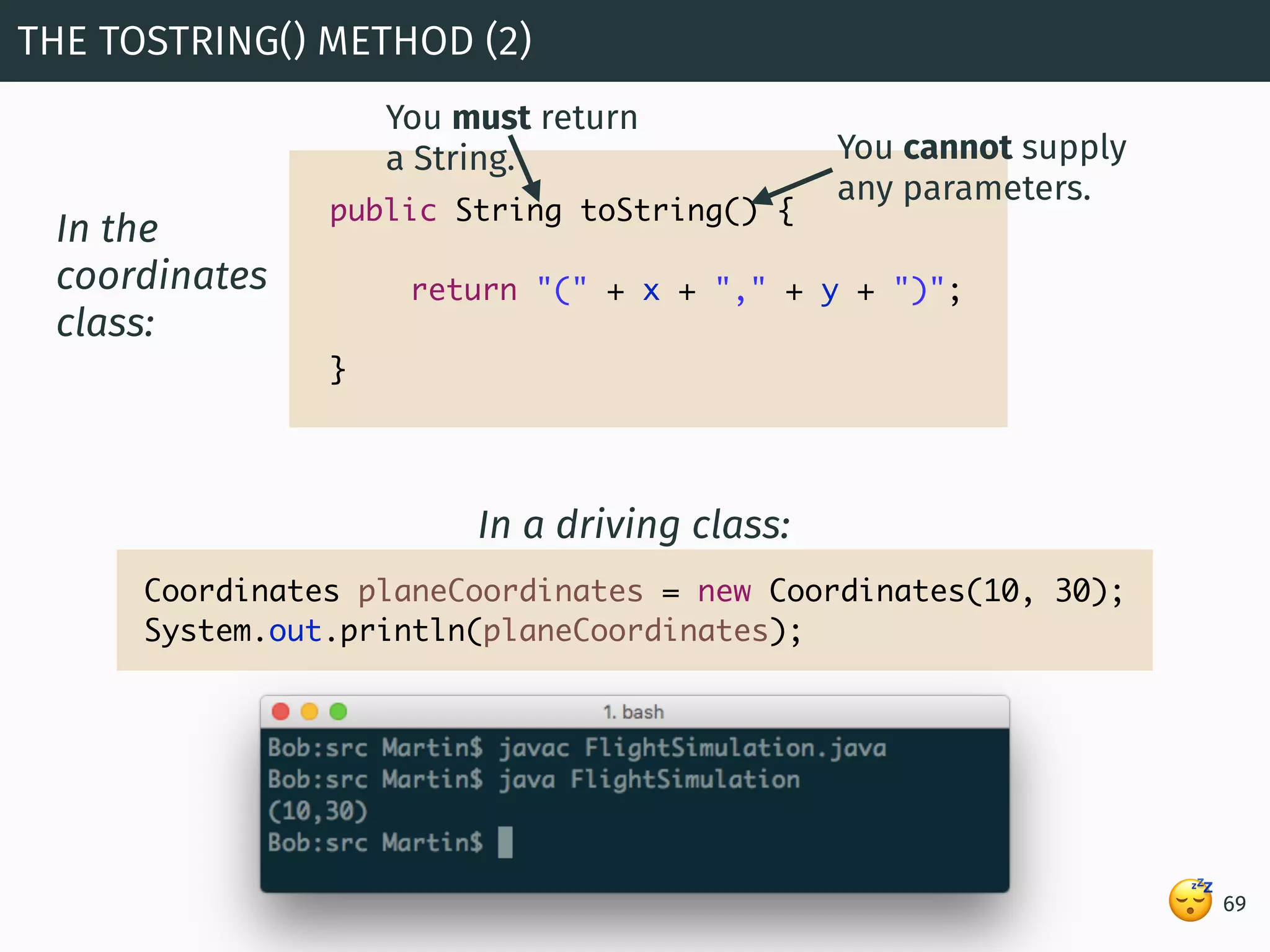
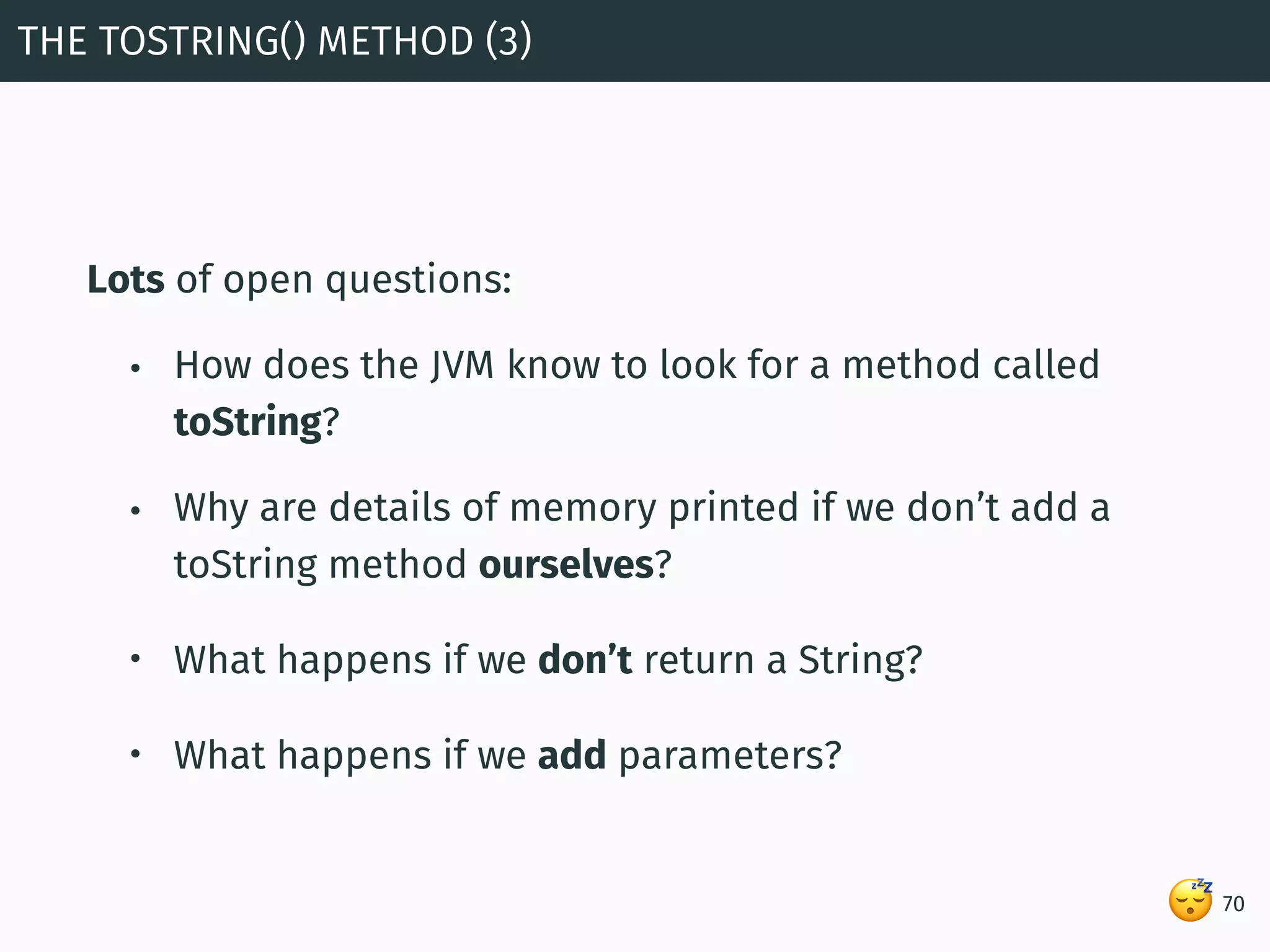
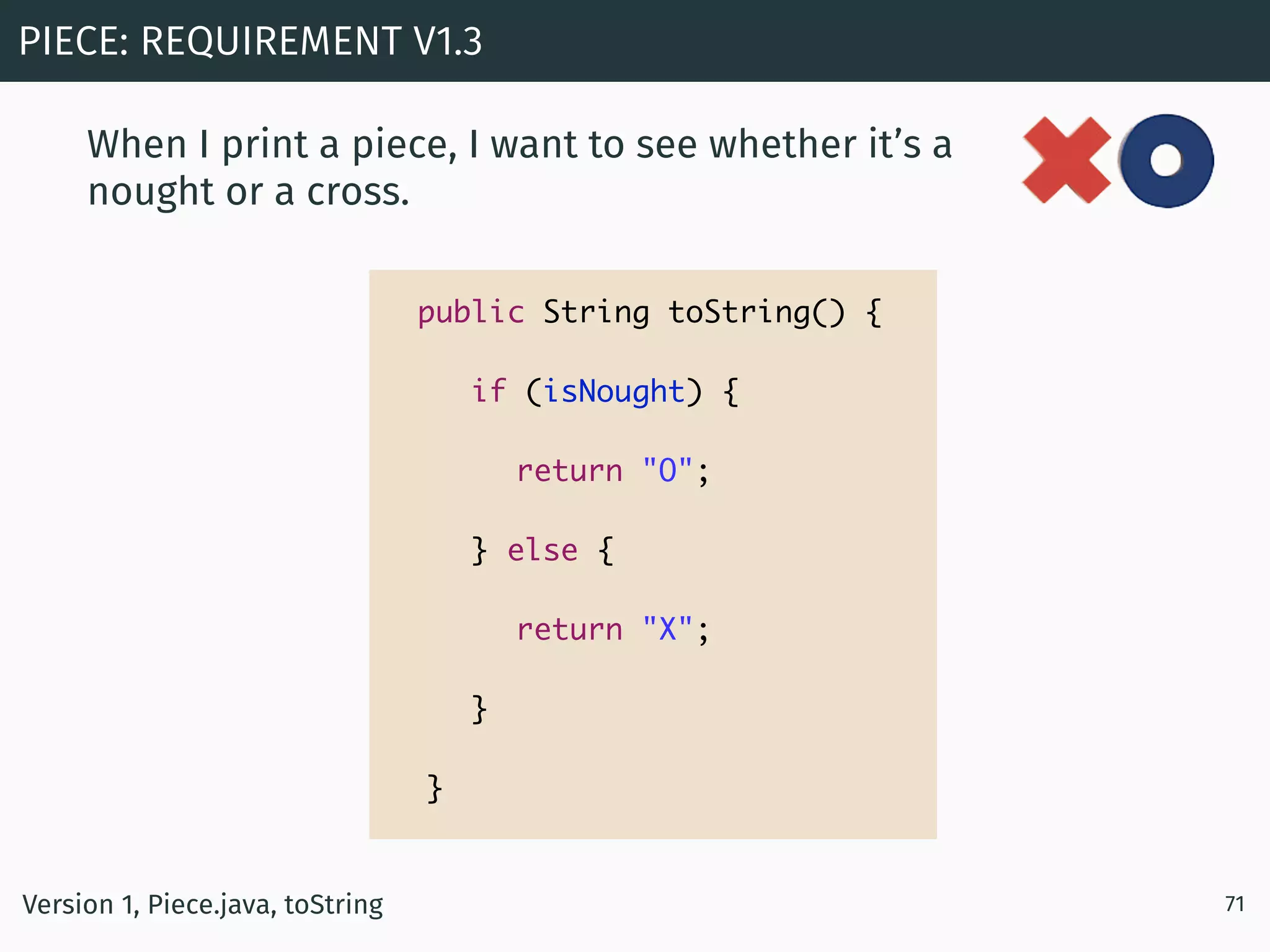
![public class Main { public static void main(String[] args) { Piece pieceOne = new Piece(true); System.out.println(pieceOne); Piece pieceTwo = new Piece(pieceOne); System.out.println(pieceTwo); } } VERSION 1: TESTING 72Version 1, Main.java, main method](https://image.slidesharecdn.com/9wt4em3btiqhrbnptnkk-signature-1d71bc69af8e1ce5cfd06165f1692fb262b99bc72e1cbb4e076cc65ccd63e69f-poli-180215150739/75/Programming-in-Java-Arrays-72-2048.jpg)
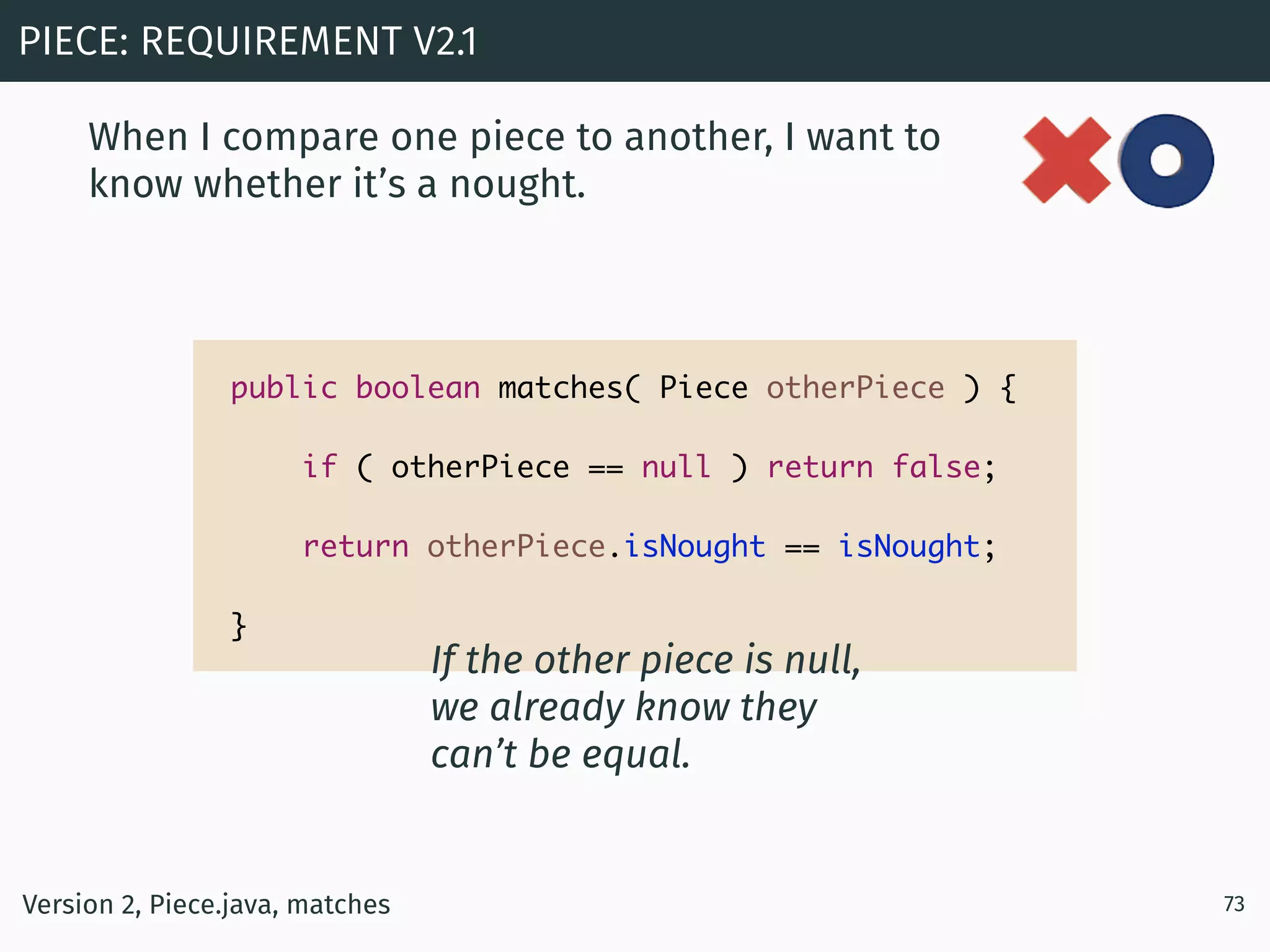
![VERSION 2: TESTING 74 public class Main { public static void main(String[] args) { Piece pieceOne = new Piece(true); System.out.println(pieceOne); Piece pieceTwo = new Piece(pieceOne); System.out.println(pieceTwo); System.out.println(pieceOne.matches(pieceTwo)); Piece pieceThree = new Piece(true); System.out.println(pieceOne.matches(pieceThree)); } } Version 2, Main.java, main method](https://image.slidesharecdn.com/9wt4em3btiqhrbnptnkk-signature-1d71bc69af8e1ce5cfd06165f1692fb262b99bc72e1cbb4e076cc65ccd63e69f-poli-180215150739/75/Programming-in-Java-Arrays-74-2048.jpg)
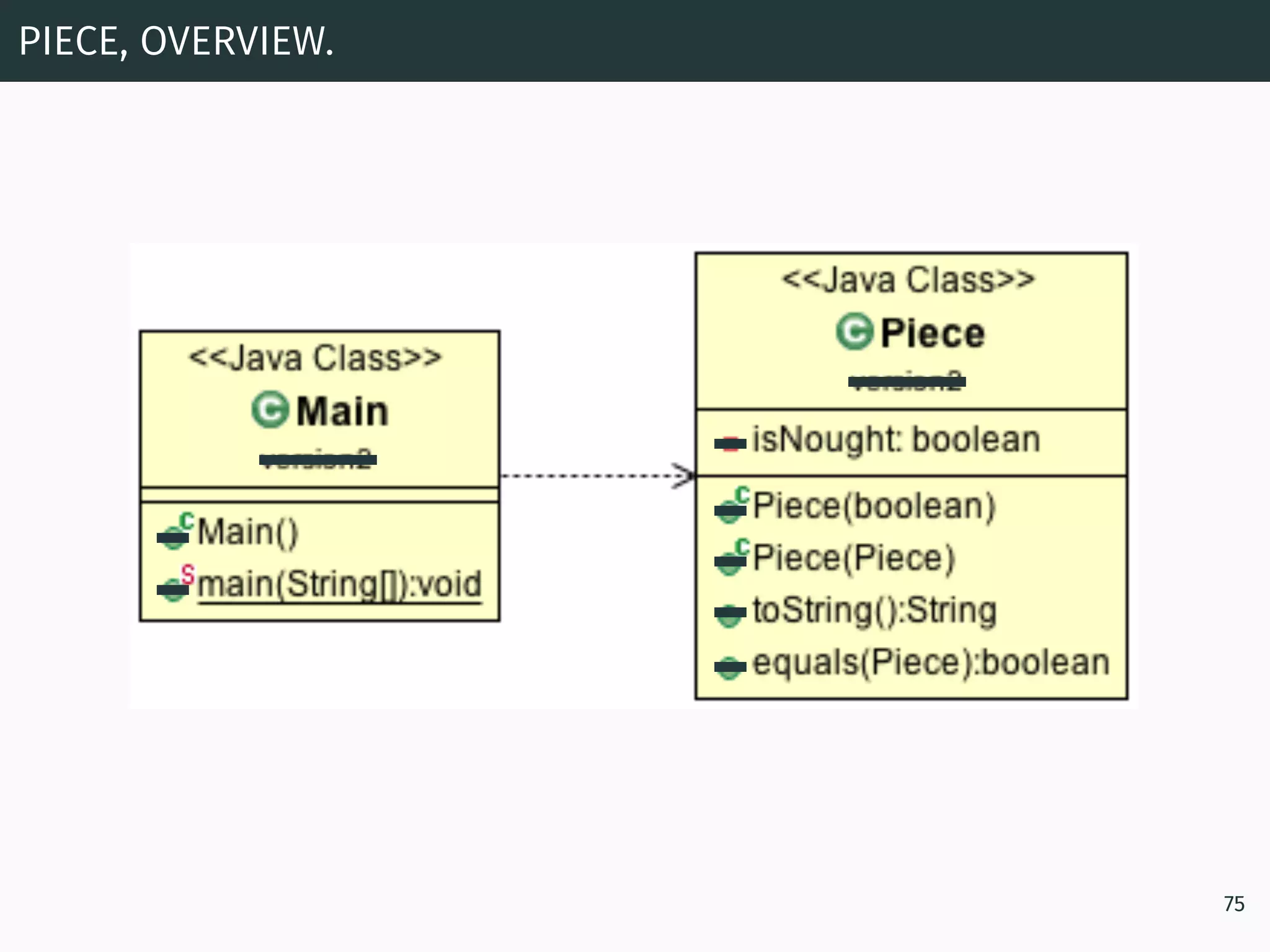
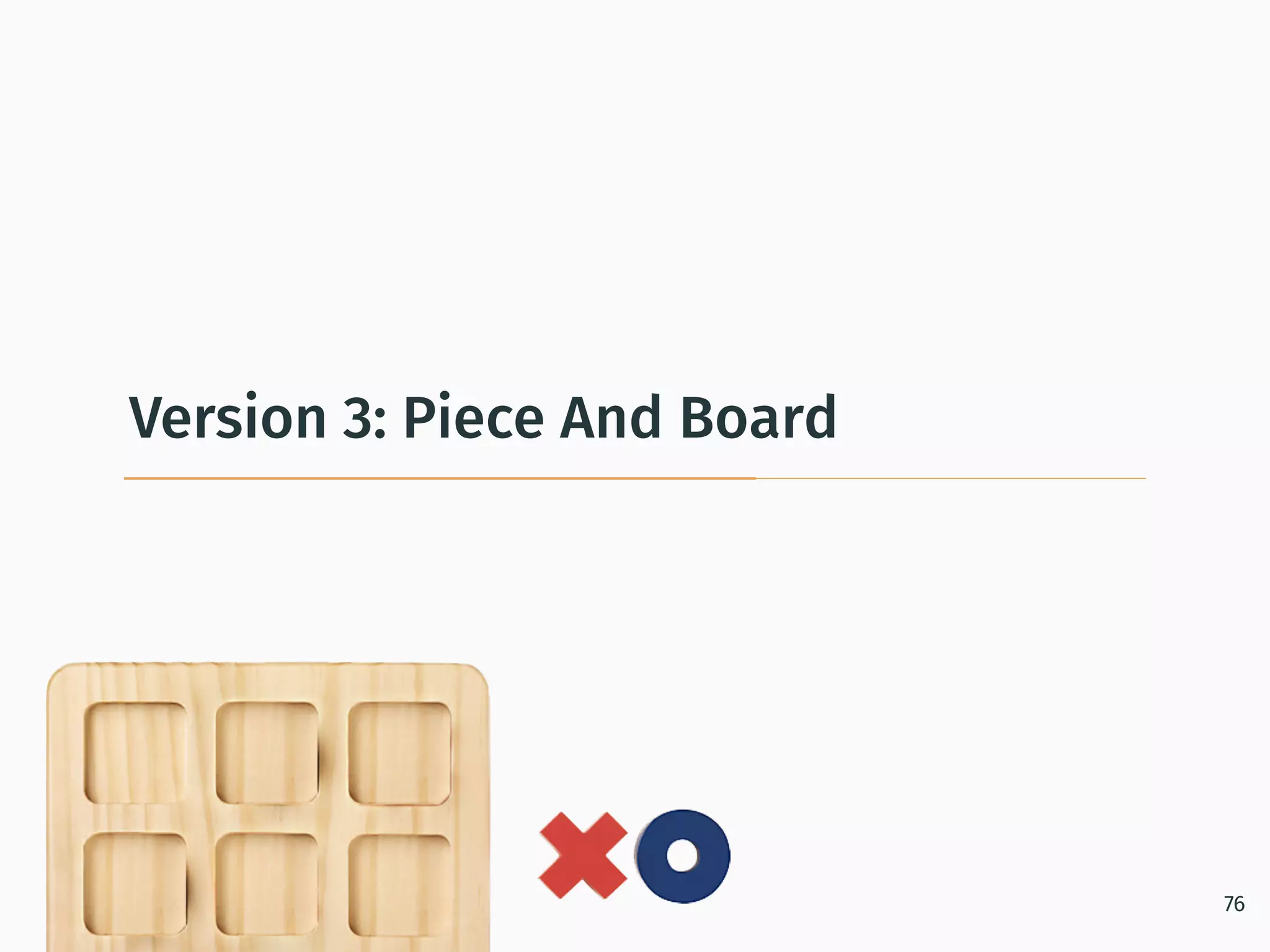
![PREFACE: MODELLING A 2D SPACE (1) 77 0 1 2 0 1 2 Piece[] row0 = { new Piece(true), null, new Piece(false) }; Piece[] row1 = { new Piece(true), new Piece(true), new Piece(false) }; Piece[] row2 = { new Piece(true), new Piece(false), null };](https://image.slidesharecdn.com/9wt4em3btiqhrbnptnkk-signature-1d71bc69af8e1ce5cfd06165f1692fb262b99bc72e1cbb4e076cc65ccd63e69f-poli-180215150739/75/Programming-in-Java-Arrays-77-2048.jpg)
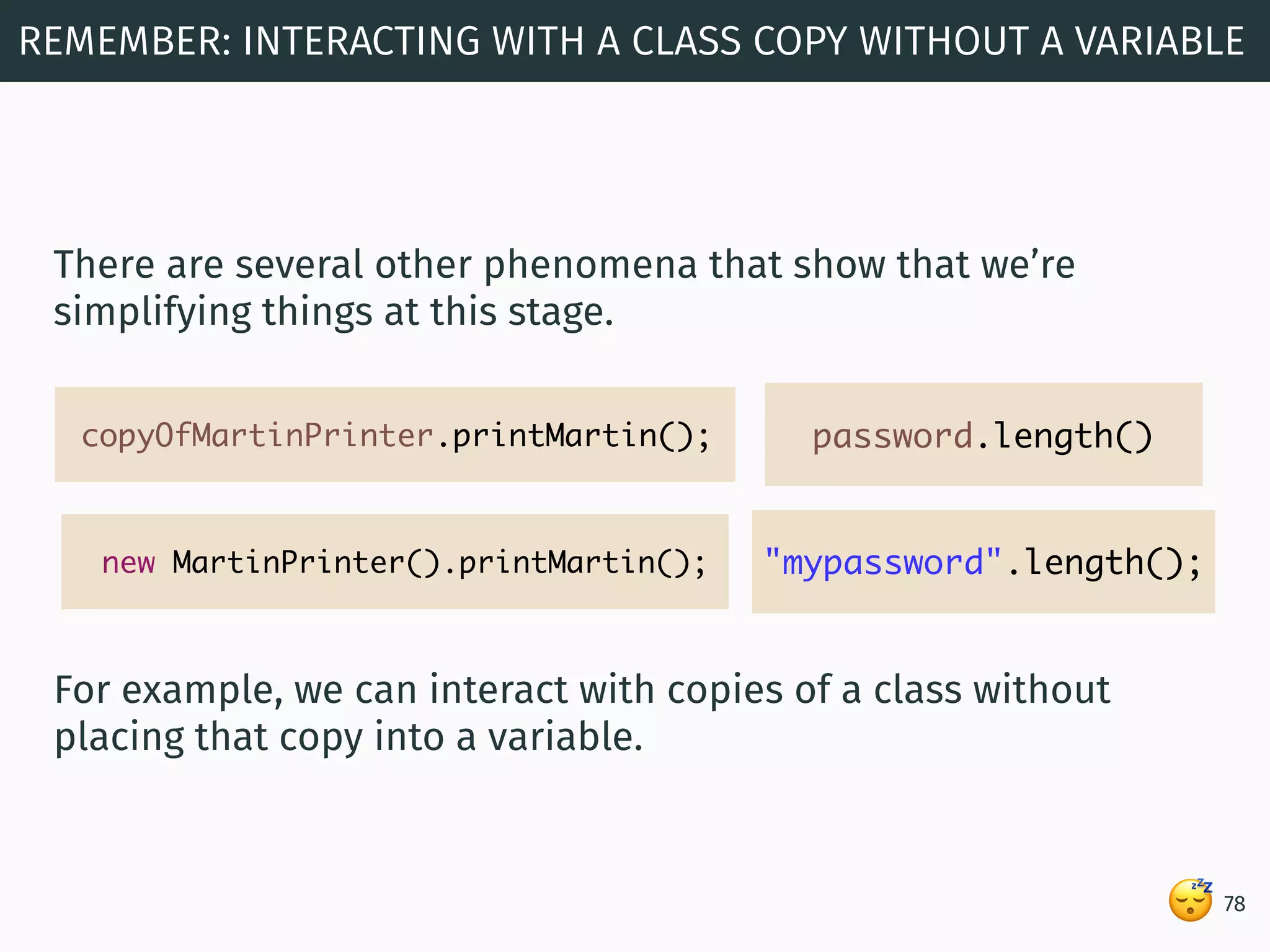
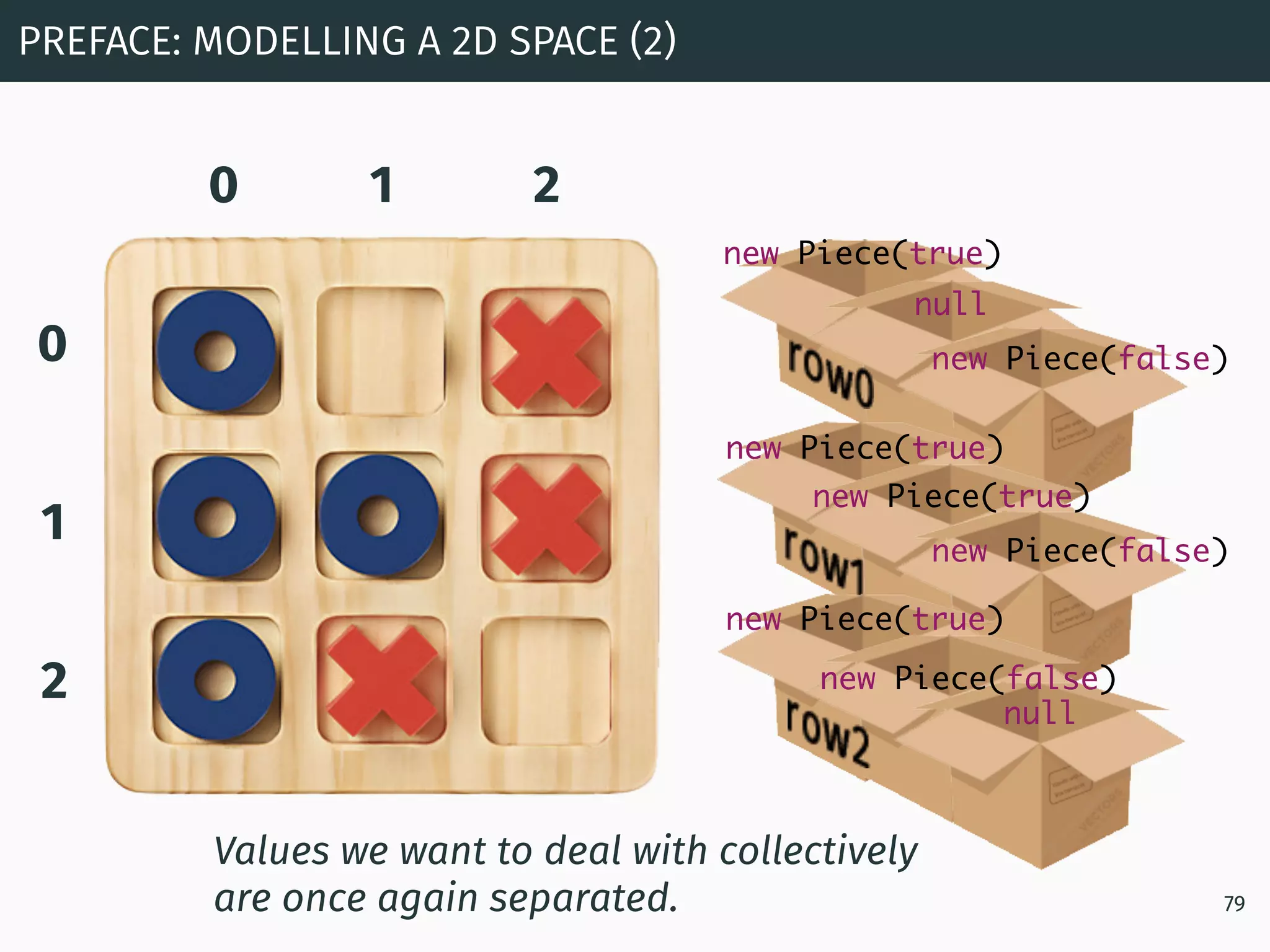
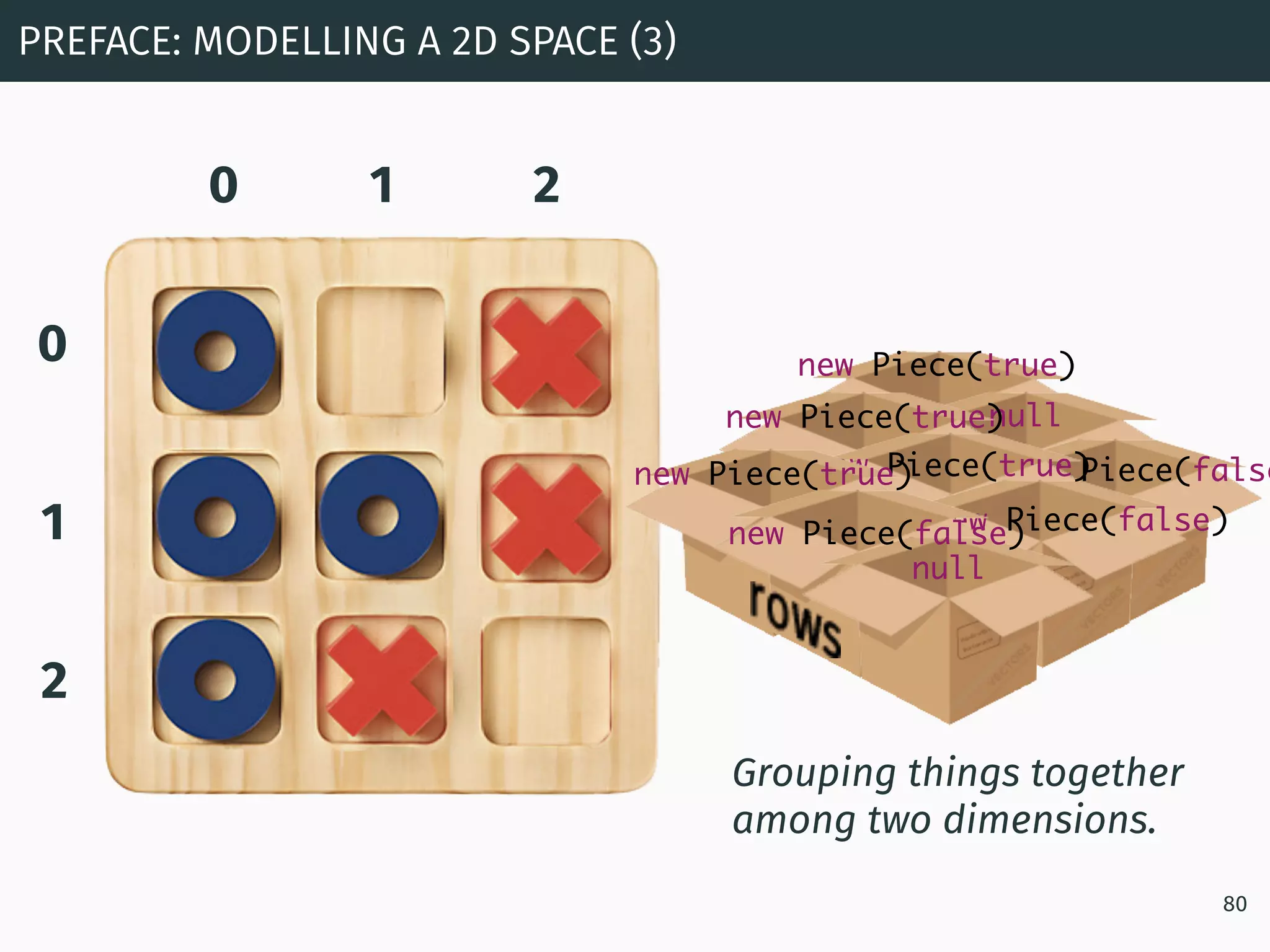
![PREFACE: MODELLING A 2D SPACE (4) 81 0 1 2 0 1 2 Piece[][] rows = { { new Piece(true), null, new Piece(false) }, { new Piece(true), new Piece(true), new Piece(false) }, { new Piece(true), new Piece(false), null }, }; One outer array, three inner arrays; each index of the outer array is itself an array; there arrays in an array with three positions.](https://image.slidesharecdn.com/9wt4em3btiqhrbnptnkk-signature-1d71bc69af8e1ce5cfd06165f1692fb262b99bc72e1cbb4e076cc65ccd63e69f-poli-180215150739/75/Programming-in-Java-Arrays-81-2048.jpg)
![PREFACE: MODELLING A 2D SPACE (5) 82 0 1 2 0 1 2 Piece[][] rows = new Piece[3][3]; rows[0][0] = new Piece(true); rows[0][1] = null; rows[0][2] = new Piece(false); Column Row](https://image.slidesharecdn.com/9wt4em3btiqhrbnptnkk-signature-1d71bc69af8e1ce5cfd06165f1692fb262b99bc72e1cbb4e076cc65ccd63e69f-poli-180215150739/75/Programming-in-Java-Arrays-82-2048.jpg)
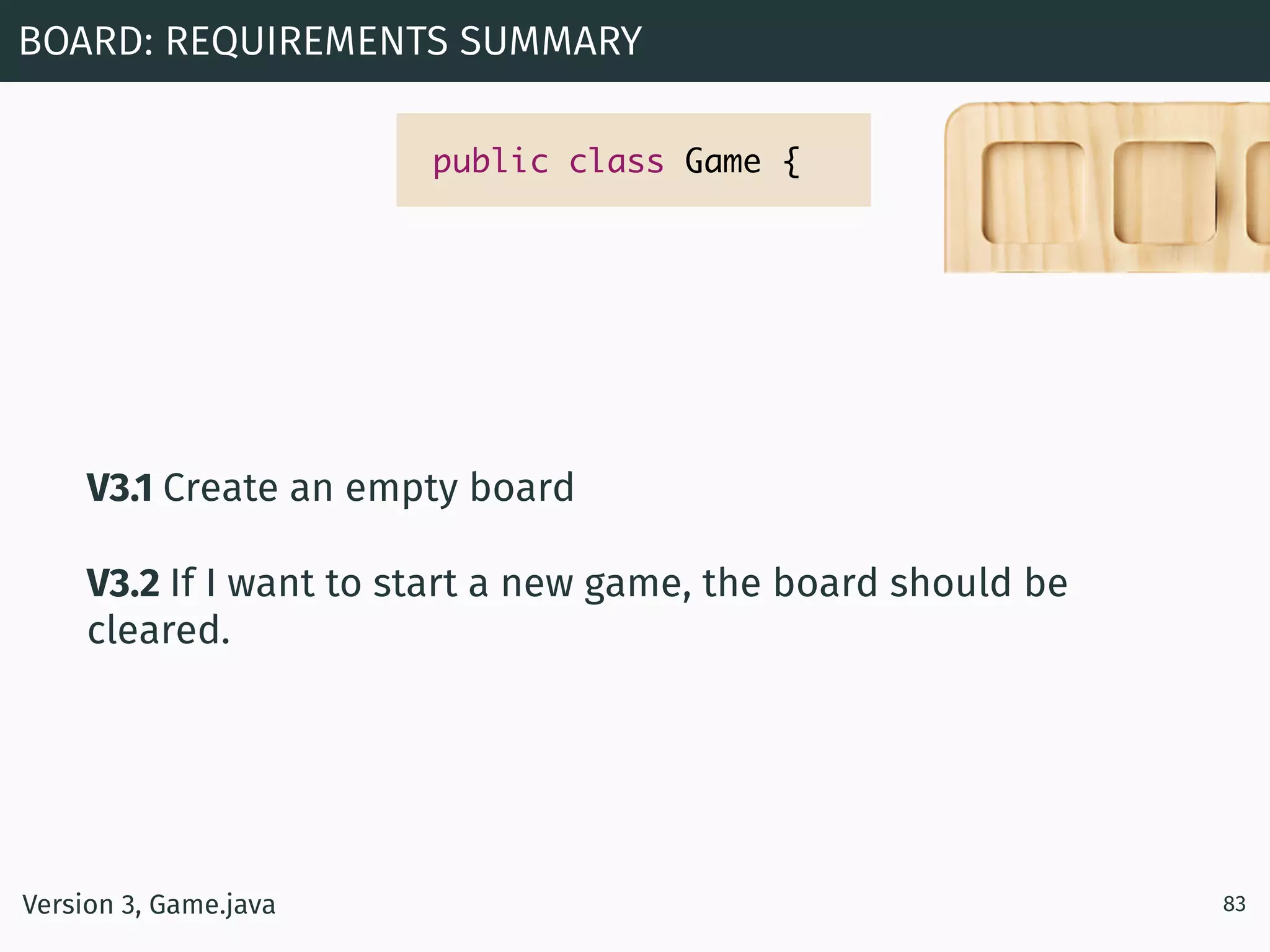
![V3.1 Create an empty board. BOARD: REQUIREMENT V3.1 84Version 3, Game.java, constructor public class Game { private Piece[][] board; public Game() { board = new Piece[3][3]; }](https://image.slidesharecdn.com/9wt4em3btiqhrbnptnkk-signature-1d71bc69af8e1ce5cfd06165f1692fb262b99bc72e1cbb4e076cc65ccd63e69f-poli-180215150739/75/Programming-in-Java-Arrays-84-2048.jpg)
![V3.2 If I want to start a new game, the board should be cleared. BOARD: REQUIREMENT V3.2 85Version 3, Game.java, newGame public void newGame() { for ( int row = 0; row < board.length; row++ ) { for ( int column = 0; column < board[0].length; column++ ) { board[row][column] = null; } } } We could simply overwrite the board array with a new array, but this feels a little brute force. The number of columns in the first row.](https://image.slidesharecdn.com/9wt4em3btiqhrbnptnkk-signature-1d71bc69af8e1ce5cfd06165f1692fb262b99bc72e1cbb4e076cc65ccd63e69f-poli-180215150739/75/Programming-in-Java-Arrays-85-2048.jpg)
![🙈 INTERACTING WITH A 2D ARRAY: NESTED LOOPS 86 Value of row Value of column board[row][column] 0 0 1 board[0][0] 0 (Stays fixed) 1 board[0][1] 0 (Stays fixed) 2 board[0][2] 1 (Increments) 0 (Restarts) board[1][0] 0 1 2 0 1 2 for ( int row = 0; row < board.length; row++ ) { for ( int column = 0; column < board[0].length; column++ ) { board[row][column] = null; } }](https://image.slidesharecdn.com/9wt4em3btiqhrbnptnkk-signature-1d71bc69af8e1ce5cfd06165f1692fb262b99bc72e1cbb4e076cc65ccd63e69f-poli-180215150739/75/Programming-in-Java-Arrays-86-2048.jpg)
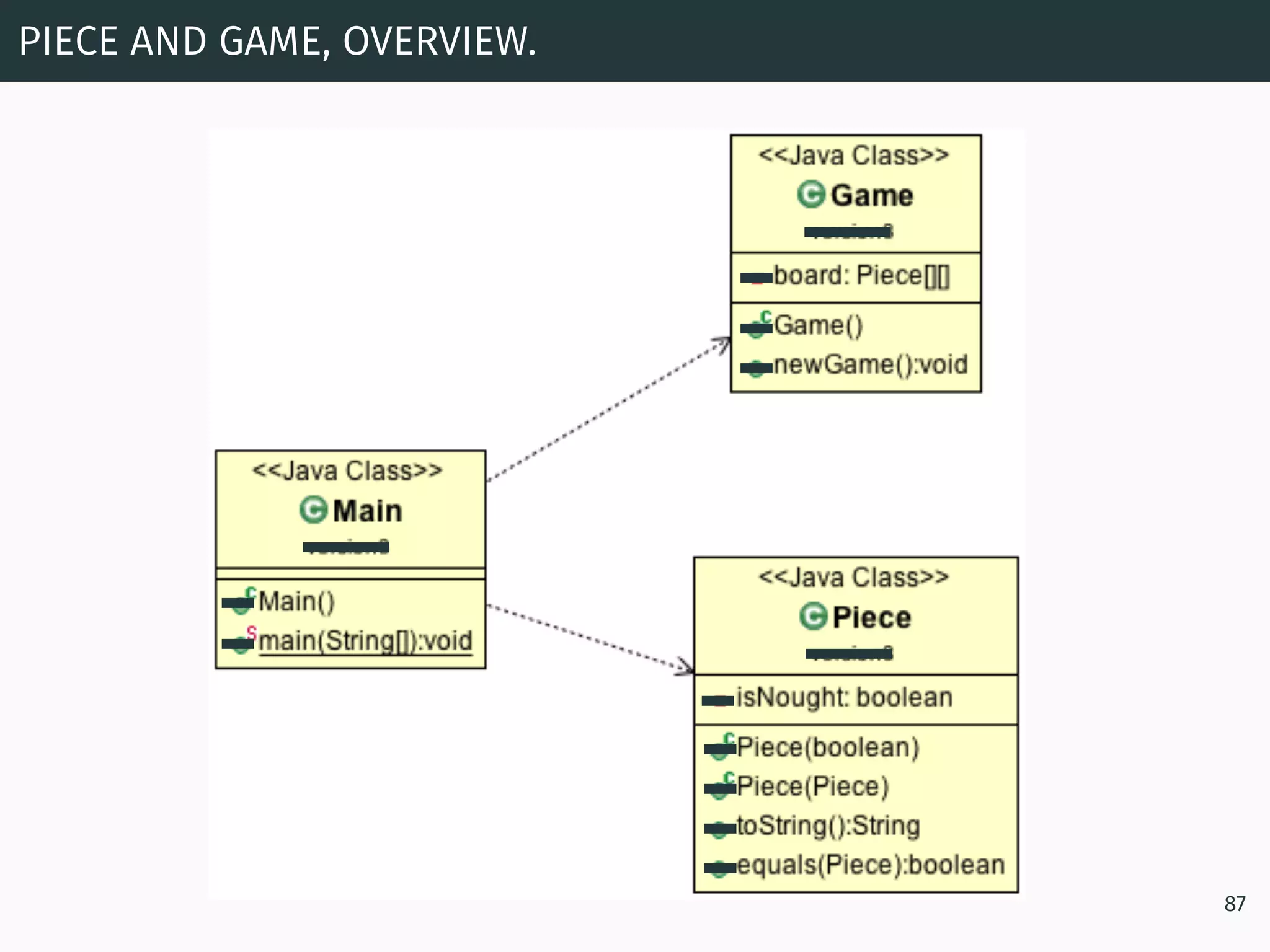
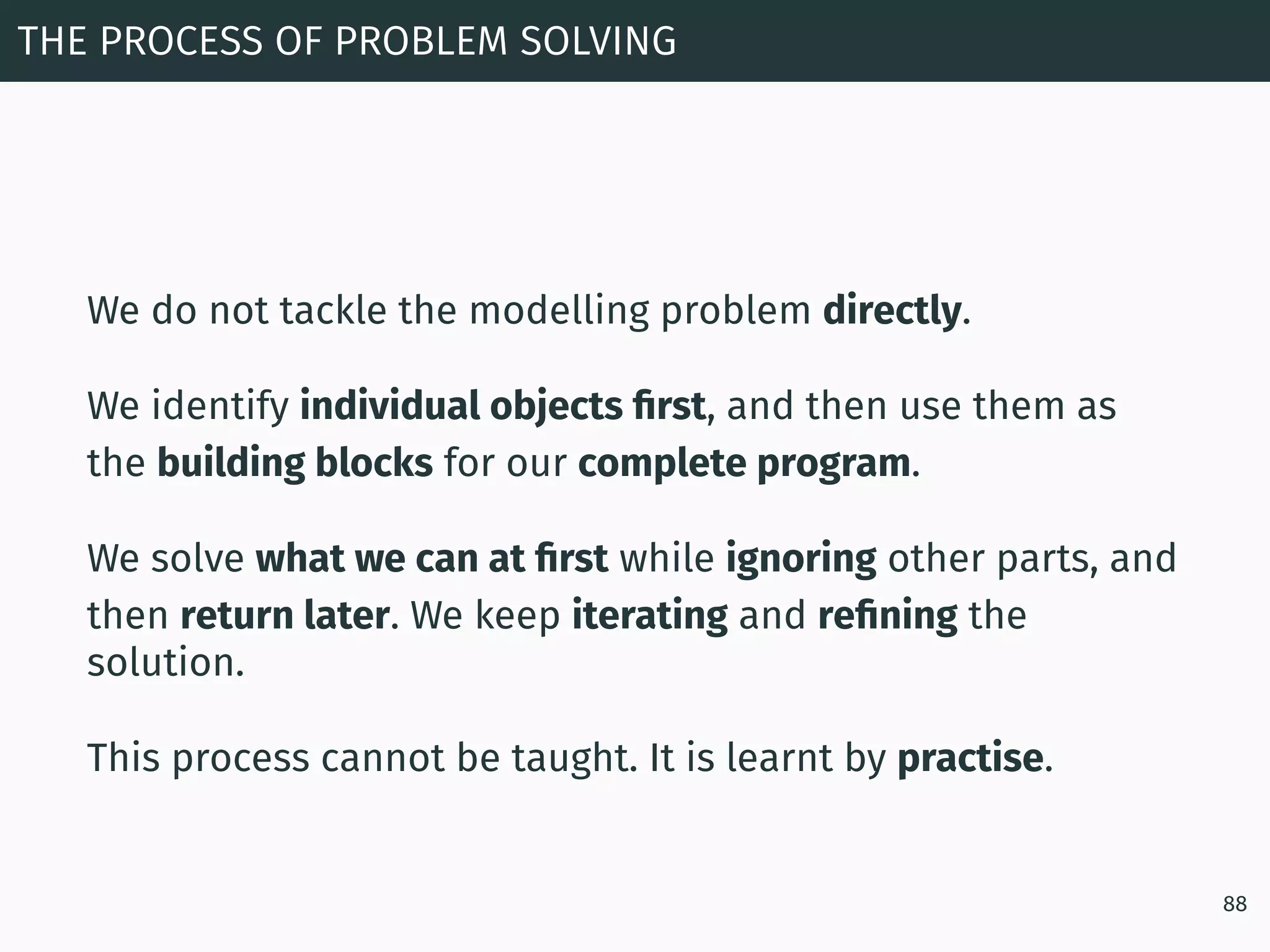
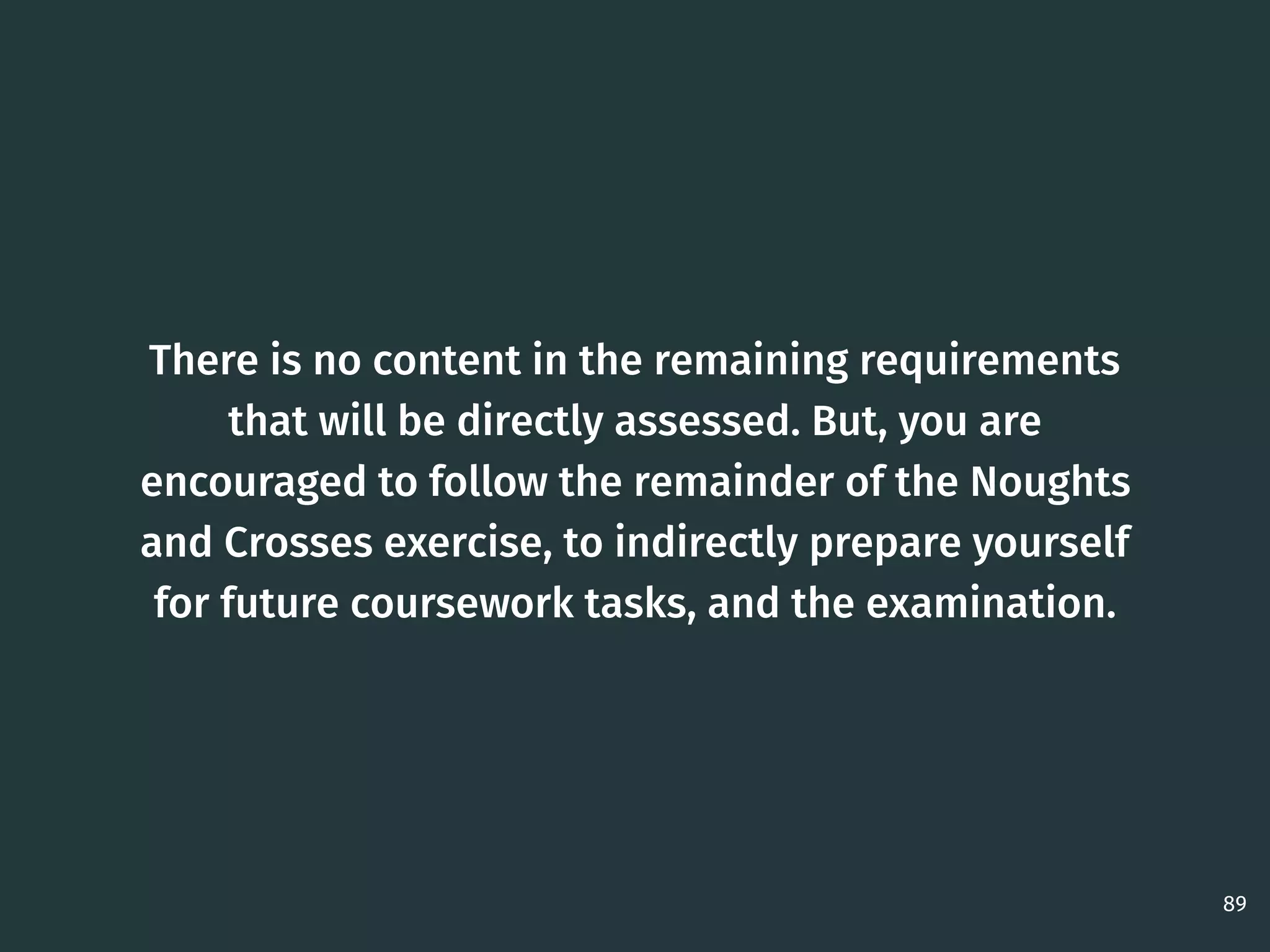
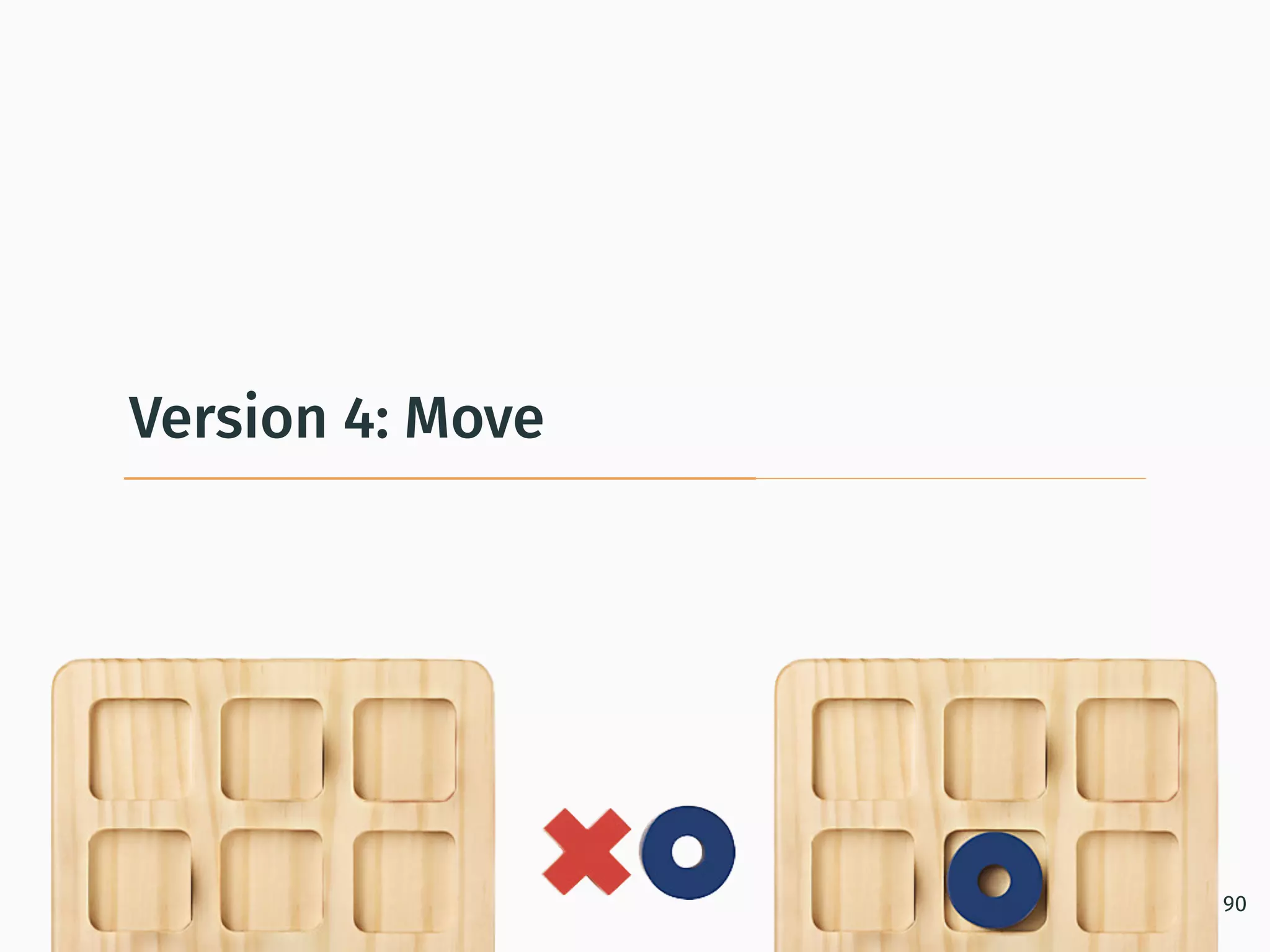
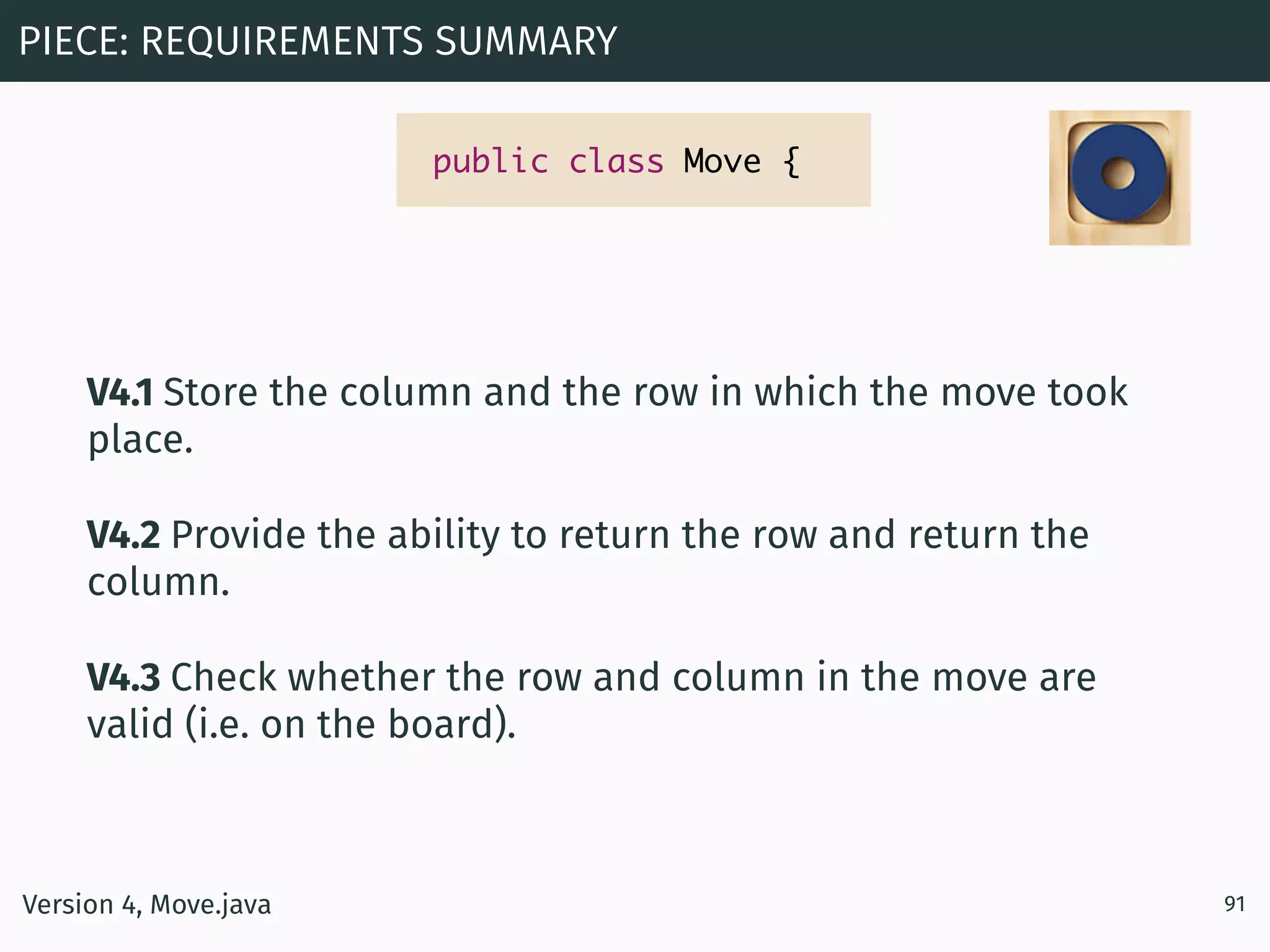
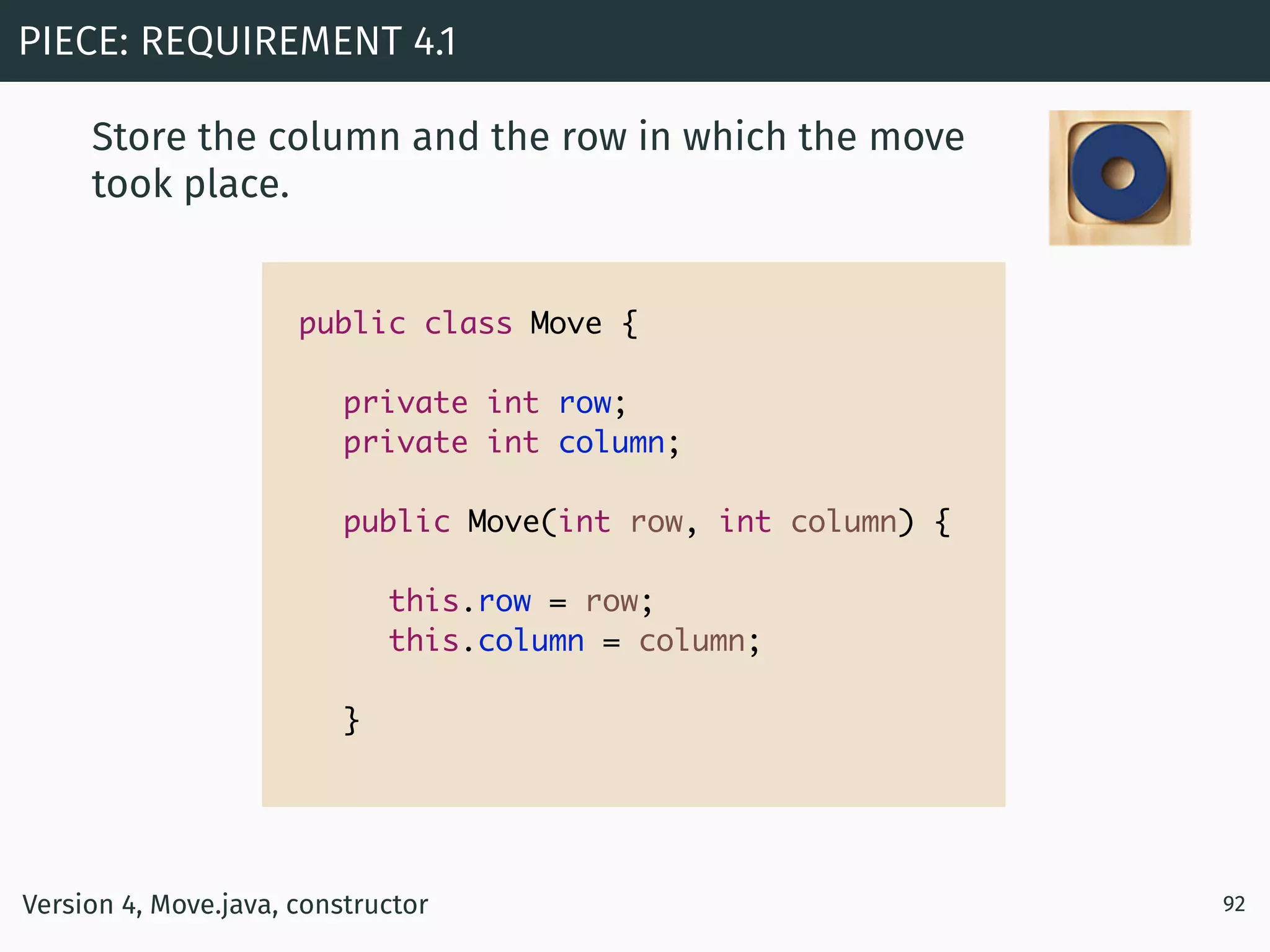
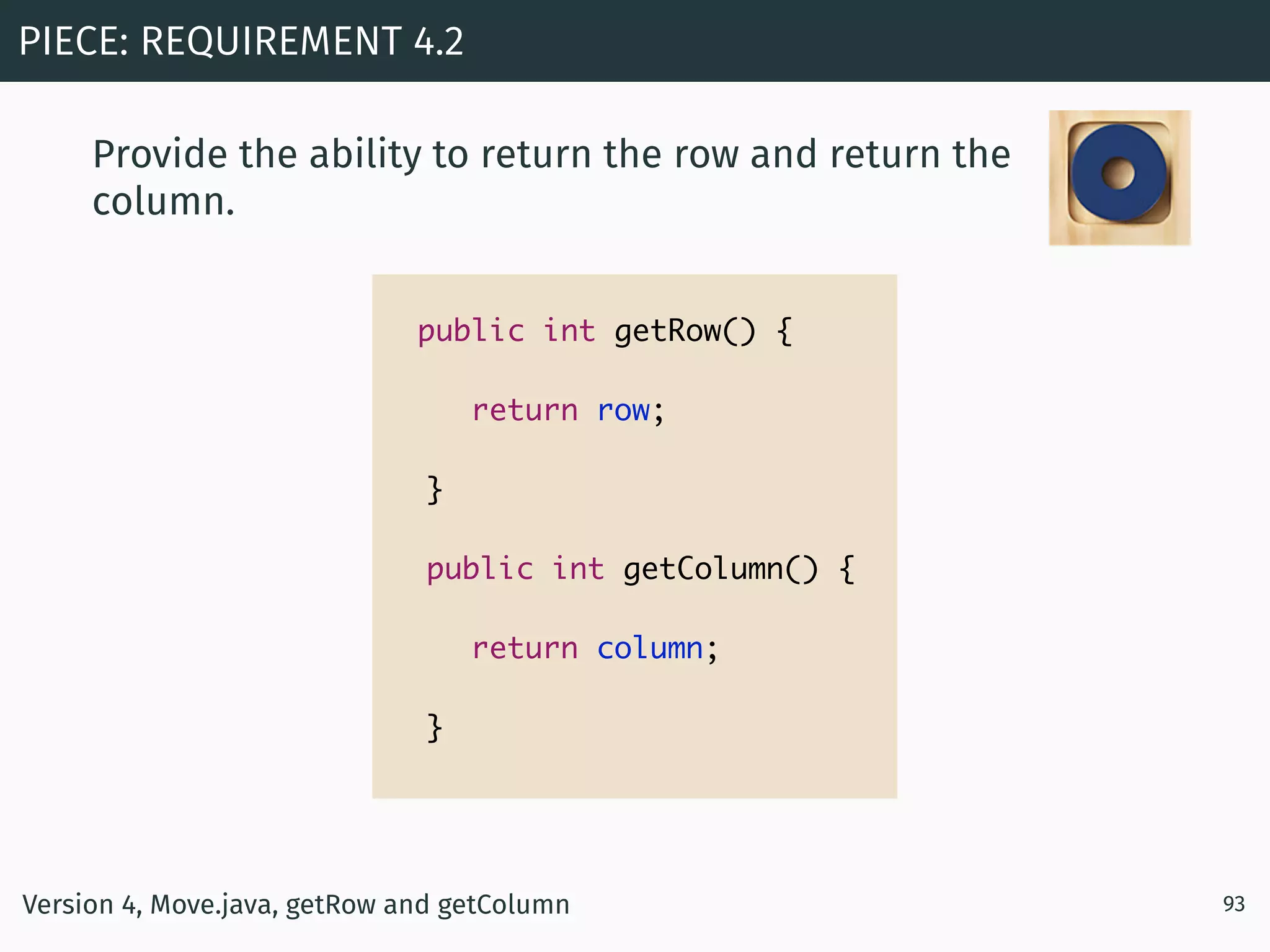
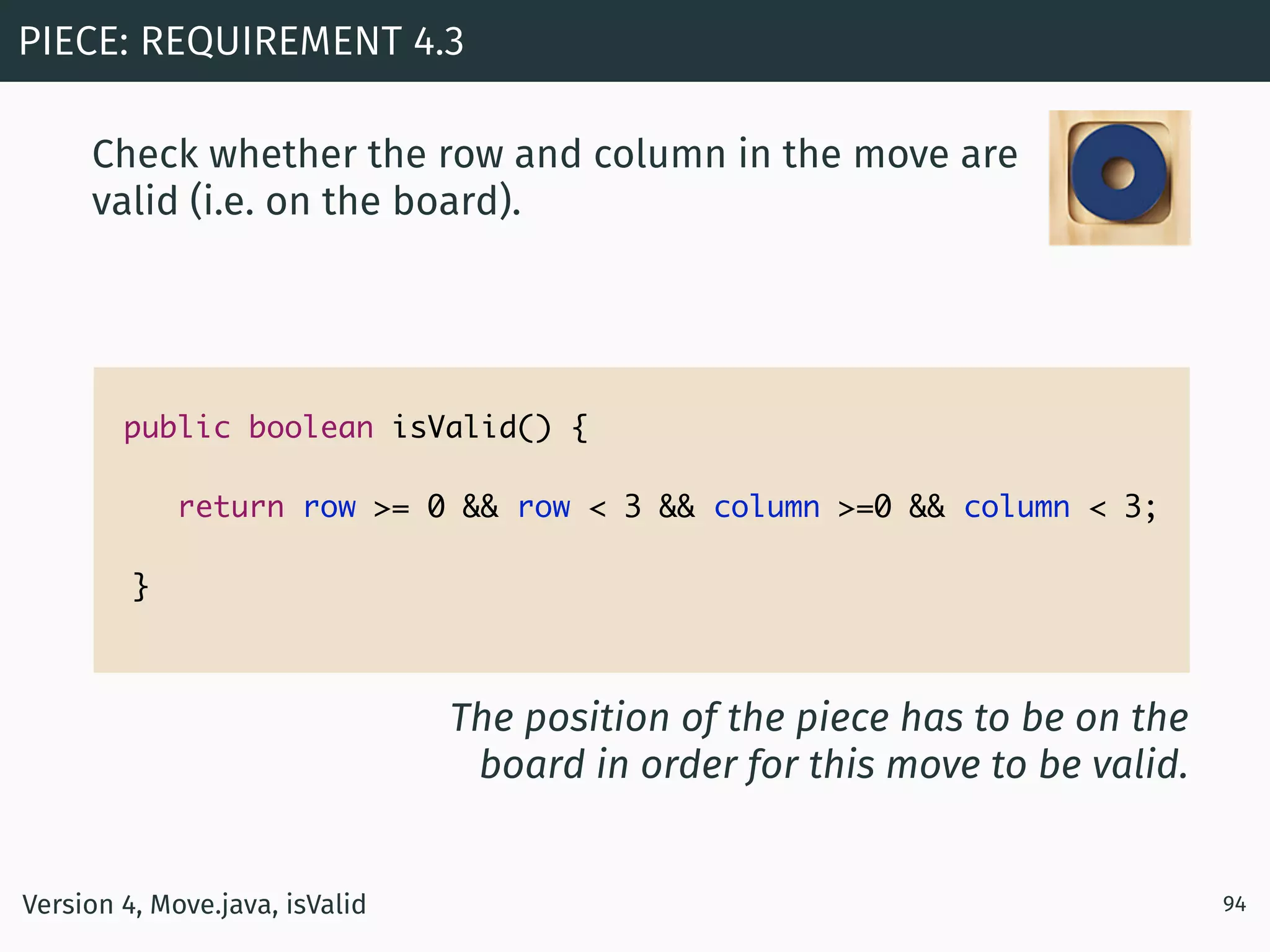
![public static void main(String[] args) { Move move1 = new Move(1, 1); System.out.println(move1.isValid()); Move move2 = new Move(2, 1); System.out.println(move2.isValid()); Move move3 = new Move(100, 100); System.out.println(move3.isValid()); } VERSION 4: TESTING 95Version 4, Main.java, main](https://image.slidesharecdn.com/9wt4em3btiqhrbnptnkk-signature-1d71bc69af8e1ce5cfd06165f1692fb262b99bc72e1cbb4e076cc65ccd63e69f-poli-180215150739/75/Programming-in-Java-Arrays-95-2048.jpg)
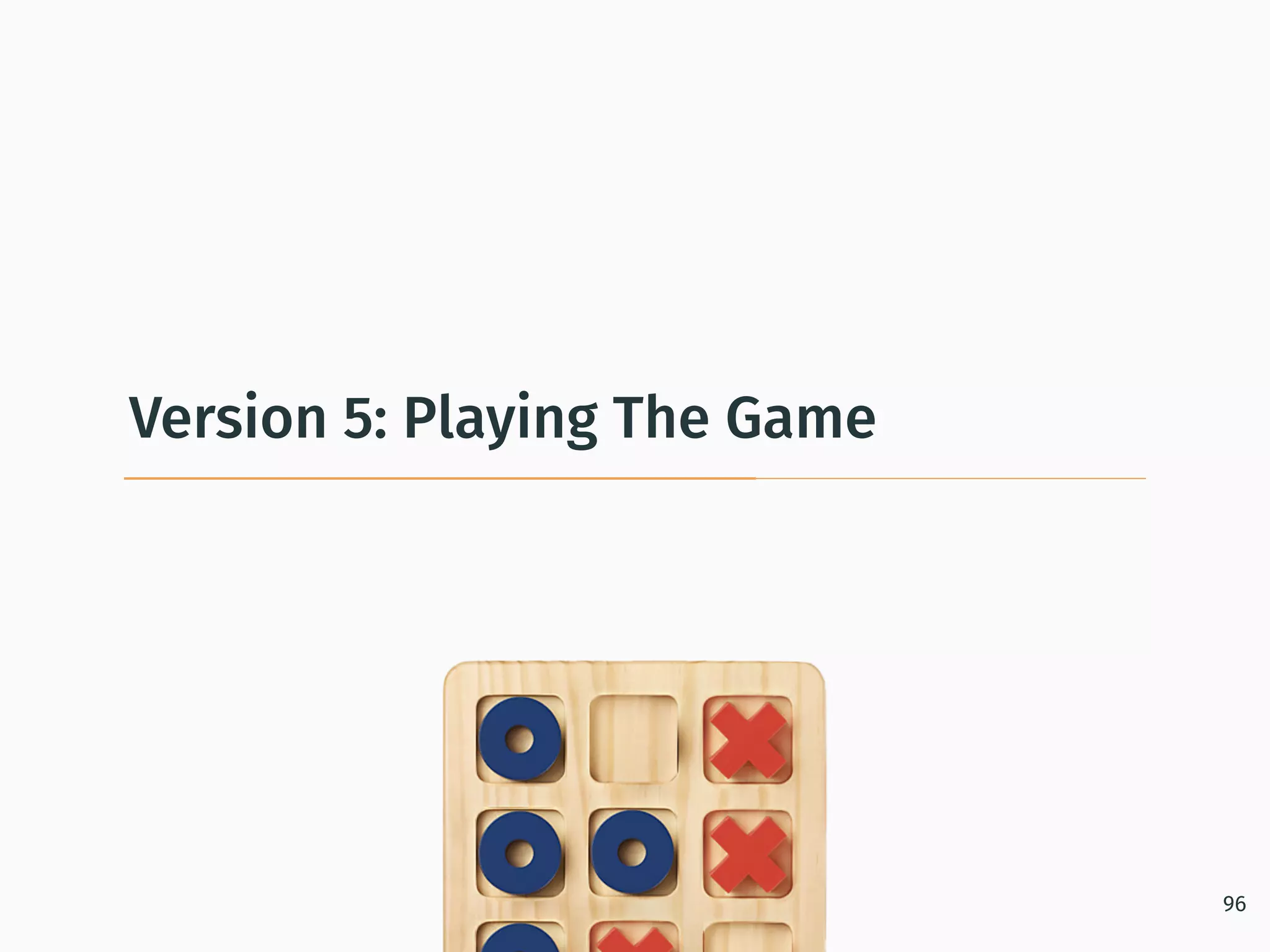
![PLAYING THE GAME: REQUIREMENTS 97Version 5, Main.java, main public static void main(String[] args) { Game g = new Game(); Piece piece = new Piece(true); Move firstMove = new Move(1, 1); } If I want to play a piece in the middle square of the board, this is the expressivity I have to do so, currently. Really though I want to be able to add a piece to the board (V5.1).](https://image.slidesharecdn.com/9wt4em3btiqhrbnptnkk-signature-1d71bc69af8e1ce5cfd06165f1692fb262b99bc72e1cbb4e076cc65ccd63e69f-poli-180215150739/75/Programming-in-Java-Arrays-97-2048.jpg)
![PLAYING THE GAME: REQUIREMENT 5.1 98 Supply a method that, given a move and a piece, makes that move by adding the piece to the board. public void play(Piece piece, Move move) { board[move.getRow()][move.getColumn()] = piece; } Version 5, Game.java, play](https://image.slidesharecdn.com/9wt4em3btiqhrbnptnkk-signature-1d71bc69af8e1ce5cfd06165f1692fb262b99bc72e1cbb4e076cc65ccd63e69f-poli-180215150739/75/Programming-in-Java-Arrays-98-2048.jpg)
![VERSION 5: TESTING 99 public void printBoard() { for ( int row = 0; row < board.length; row++ ) { for ( int column = 0; column < board[0].length; column++ ) { System.out.println(board[row][column]); } } } public static void main(String[] args) { Game game = new Game(); Piece piece = new Piece(true); Move firstMove = new Move(1, 1); game.play(piece, firstMove); } Version 5, Game.java printBoard and Main.java, main](https://image.slidesharecdn.com/9wt4em3btiqhrbnptnkk-signature-1d71bc69af8e1ce5cfd06165f1692fb262b99bc72e1cbb4e076cc65ccd63e69f-poli-180215150739/75/Programming-in-Java-Arrays-99-2048.jpg)
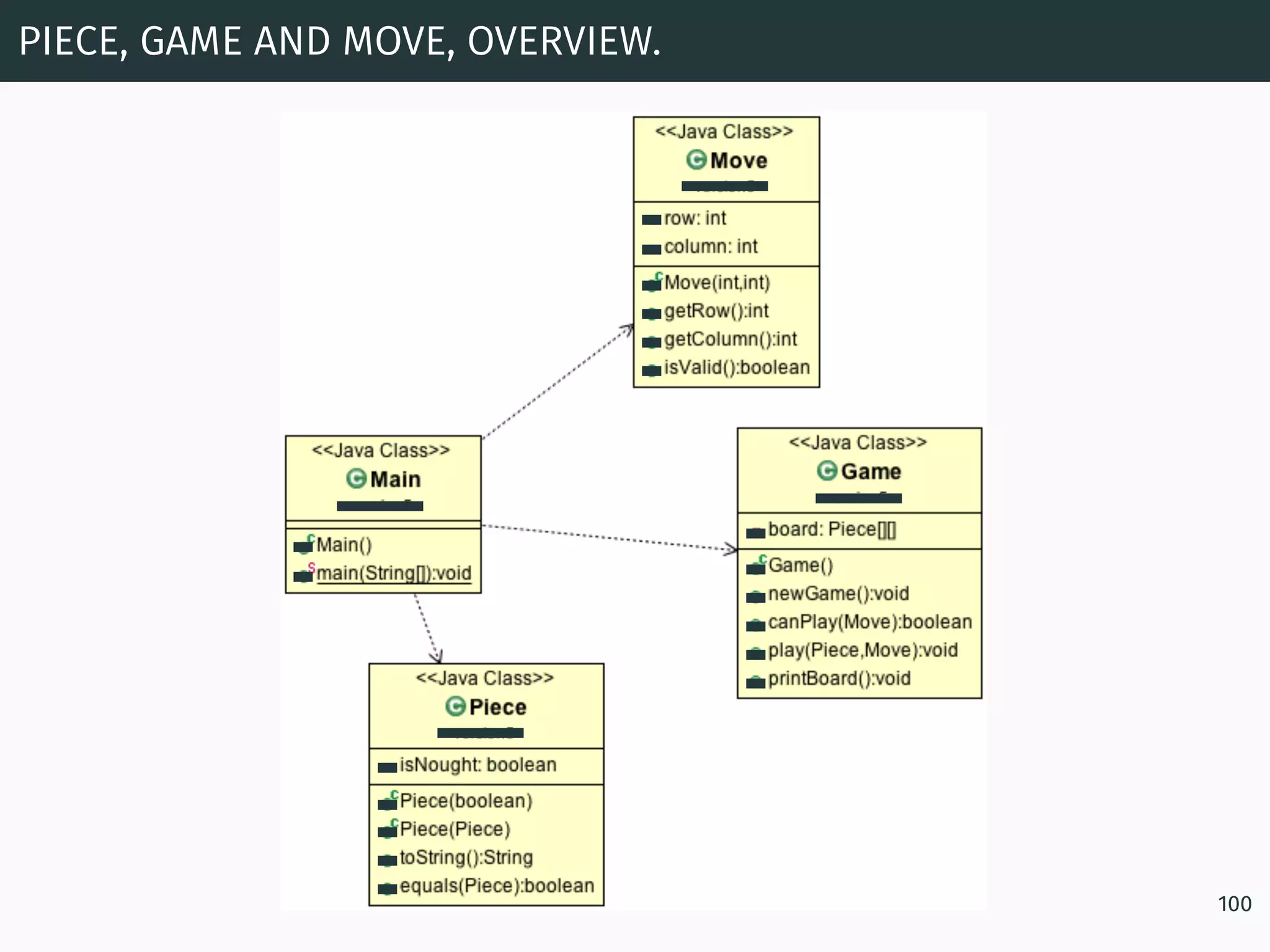
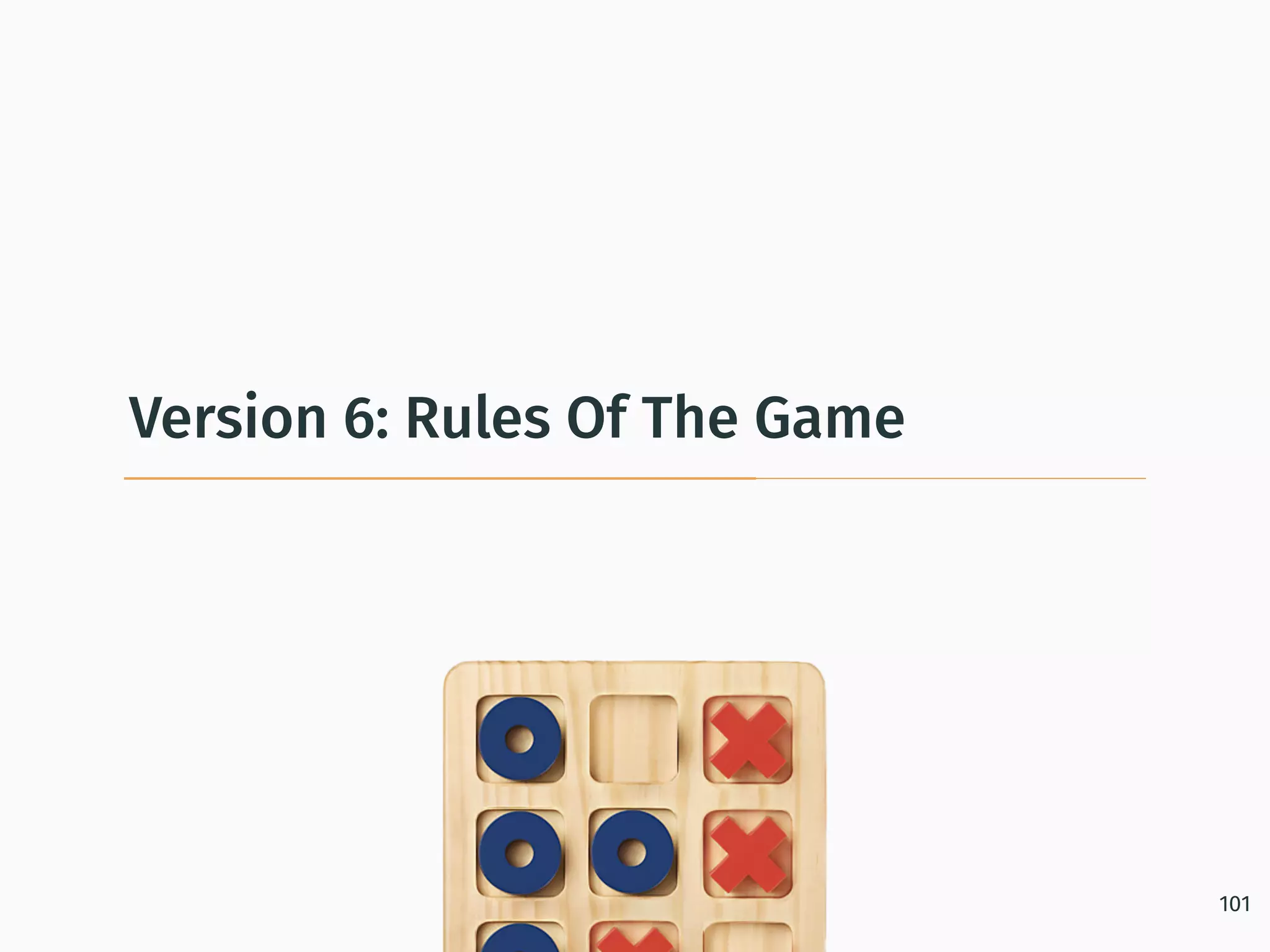
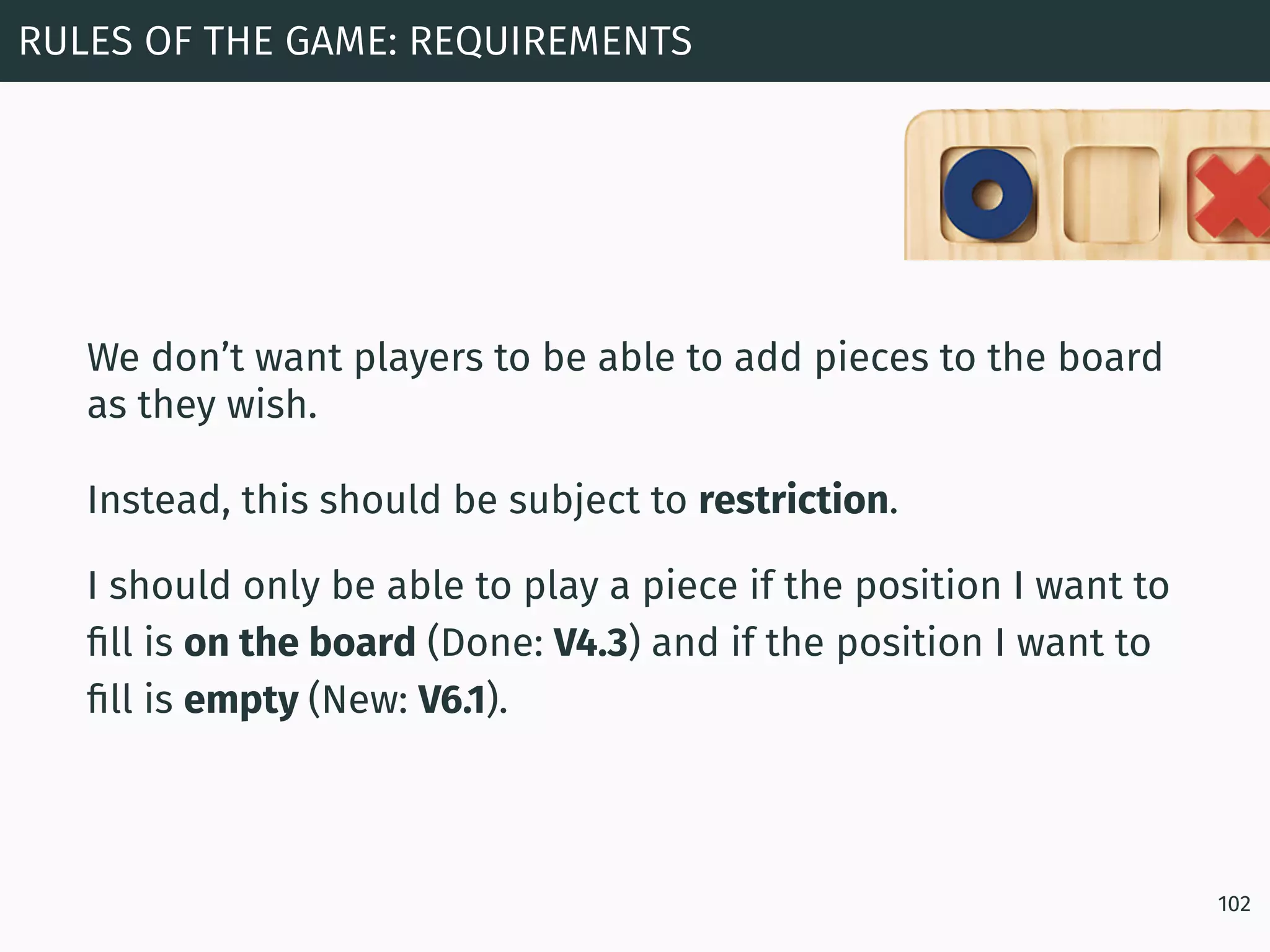
![RULES OF THE GAME: REQUIREMENT 6.1 (1) 103Version 6, Game.java, canPlay Check whether a position on the board is empty. public boolean canPlay(Move m) { return board[m.getRow()][m.getColumn()] == null; } Given a move, this method will tell me whether the row and column in that move refer to an empty position on the board.](https://image.slidesharecdn.com/9wt4em3btiqhrbnptnkk-signature-1d71bc69af8e1ce5cfd06165f1692fb262b99bc72e1cbb4e076cc65ccd63e69f-poli-180215150739/75/Programming-in-Java-Arrays-103-2048.jpg)
![PLAYING THE GAME: REQUIREMENT 6.1 (2) 104 I should only be able to play a piece if the position I want to fill is on the board and if the position I want to fill is empty. Version 6, Game.java, play public boolean play(Piece piece, Move move) { if ( move.isValid() && canPlay(move) ) { board[move.getRow()][move.getColumn()] = piece; return true; } else { return false; } }](https://image.slidesharecdn.com/9wt4em3btiqhrbnptnkk-signature-1d71bc69af8e1ce5cfd06165f1692fb262b99bc72e1cbb4e076cc65ccd63e69f-poli-180215150739/75/Programming-in-Java-Arrays-104-2048.jpg)
![public class Main { public static void main(String[] args) { Game game = new Game(); Piece piece = new Piece(true); Move firstMove = new Move(1, 1); System.out.println(game.play(piece, firstMove)); } } VERSION 6: TESTING 105Version 6, Main.java, main](https://image.slidesharecdn.com/9wt4em3btiqhrbnptnkk-signature-1d71bc69af8e1ce5cfd06165f1692fb262b99bc72e1cbb4e076cc65ccd63e69f-poli-180215150739/75/Programming-in-Java-Arrays-105-2048.jpg)

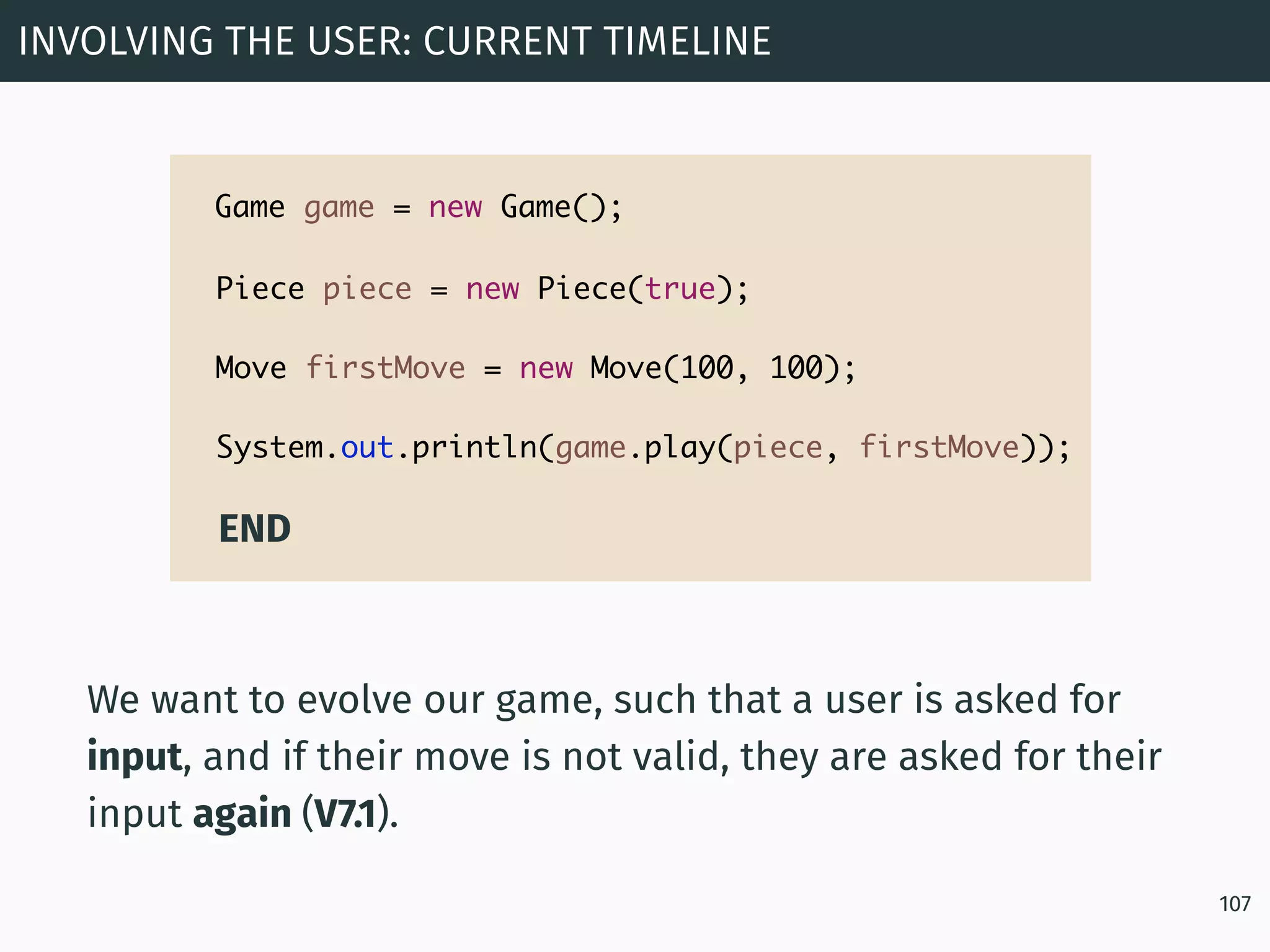
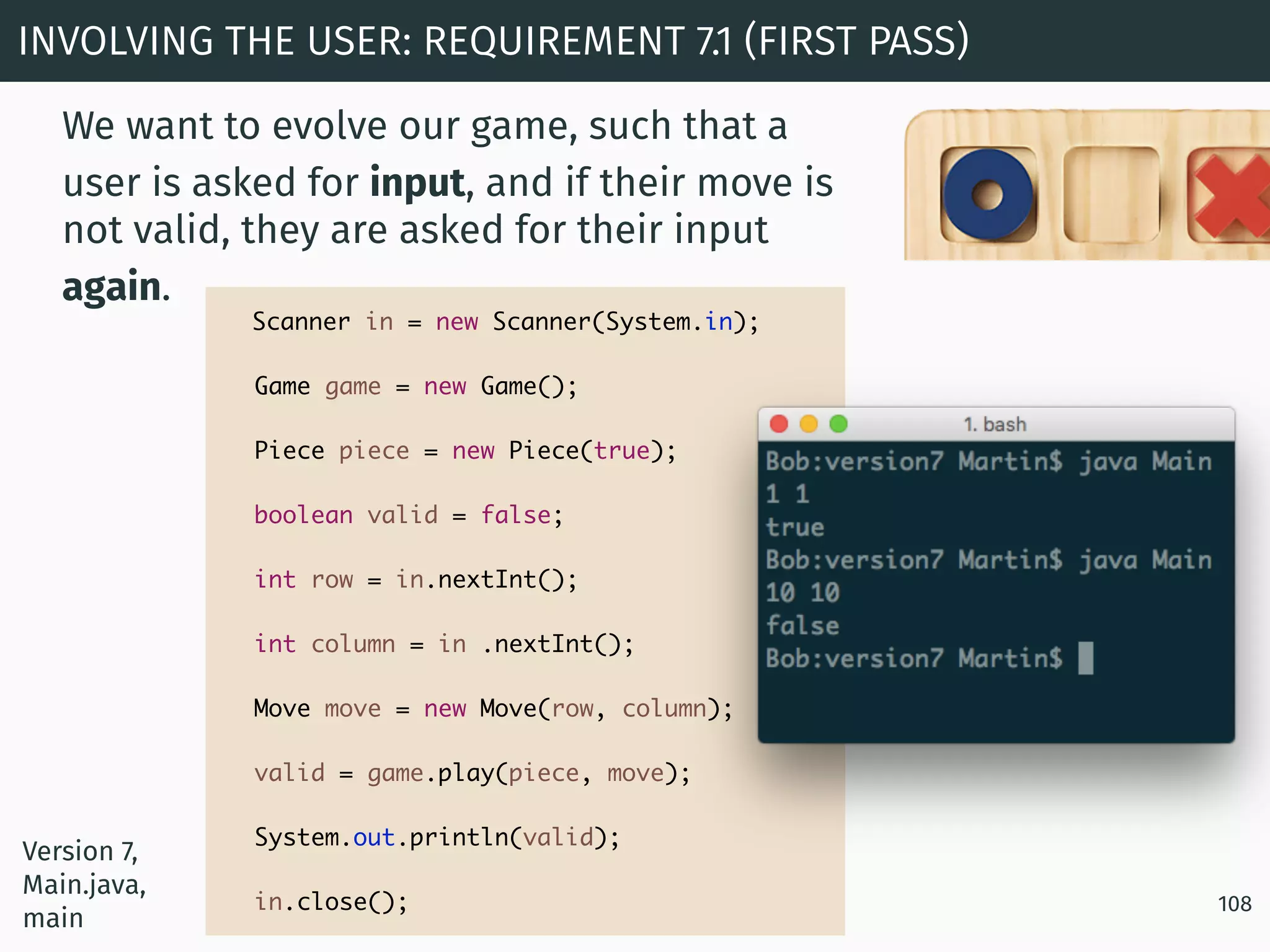
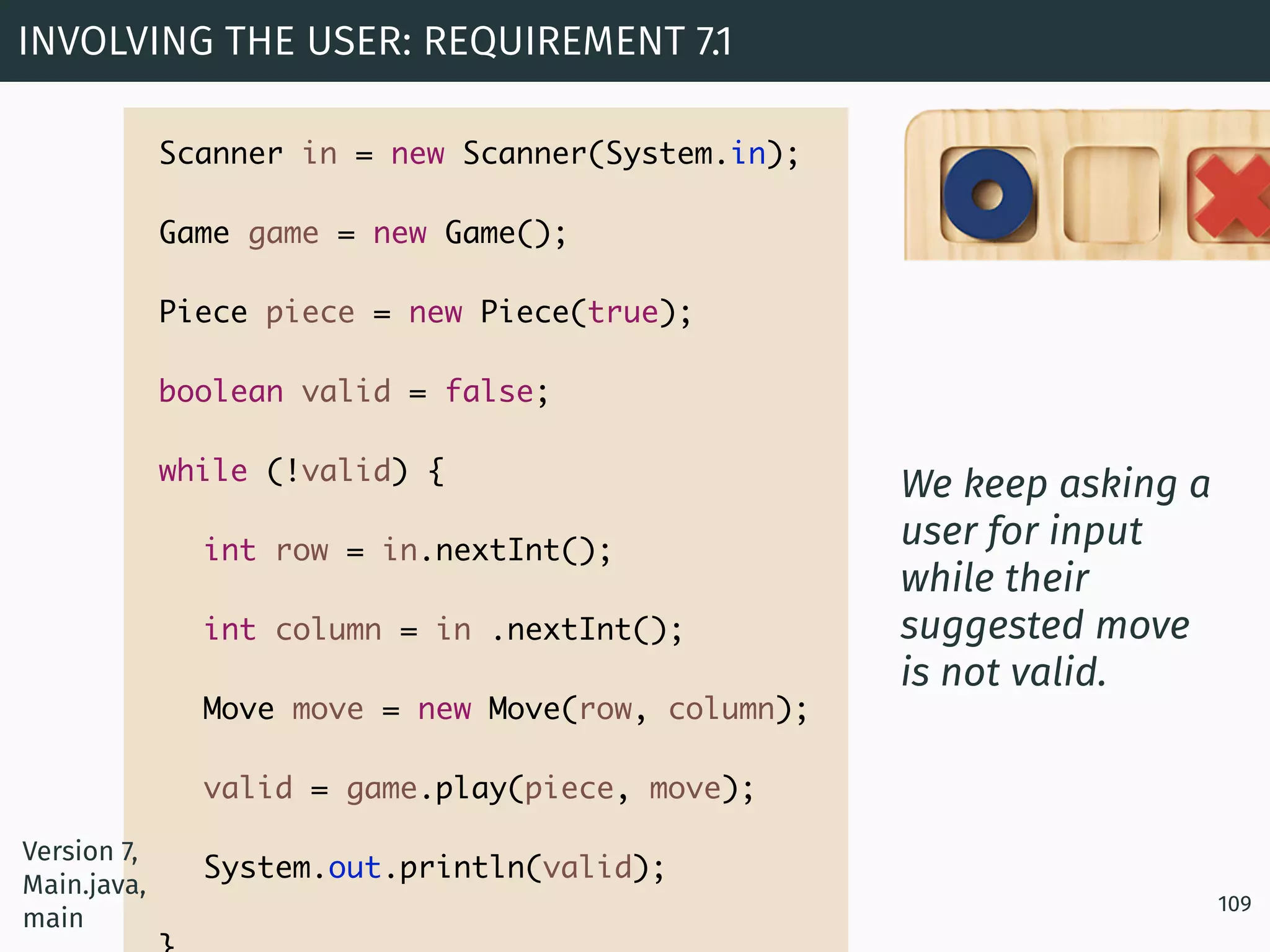
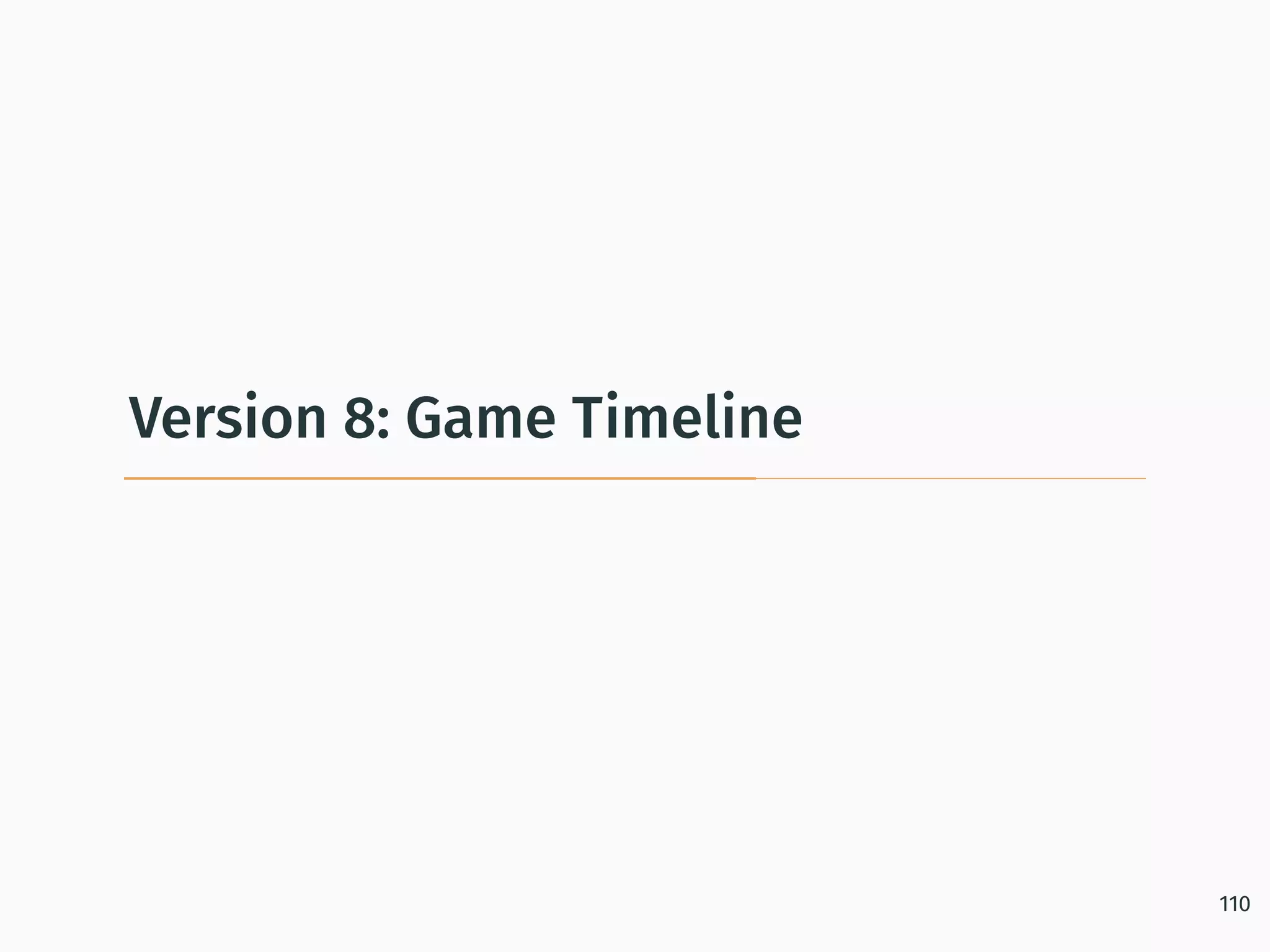
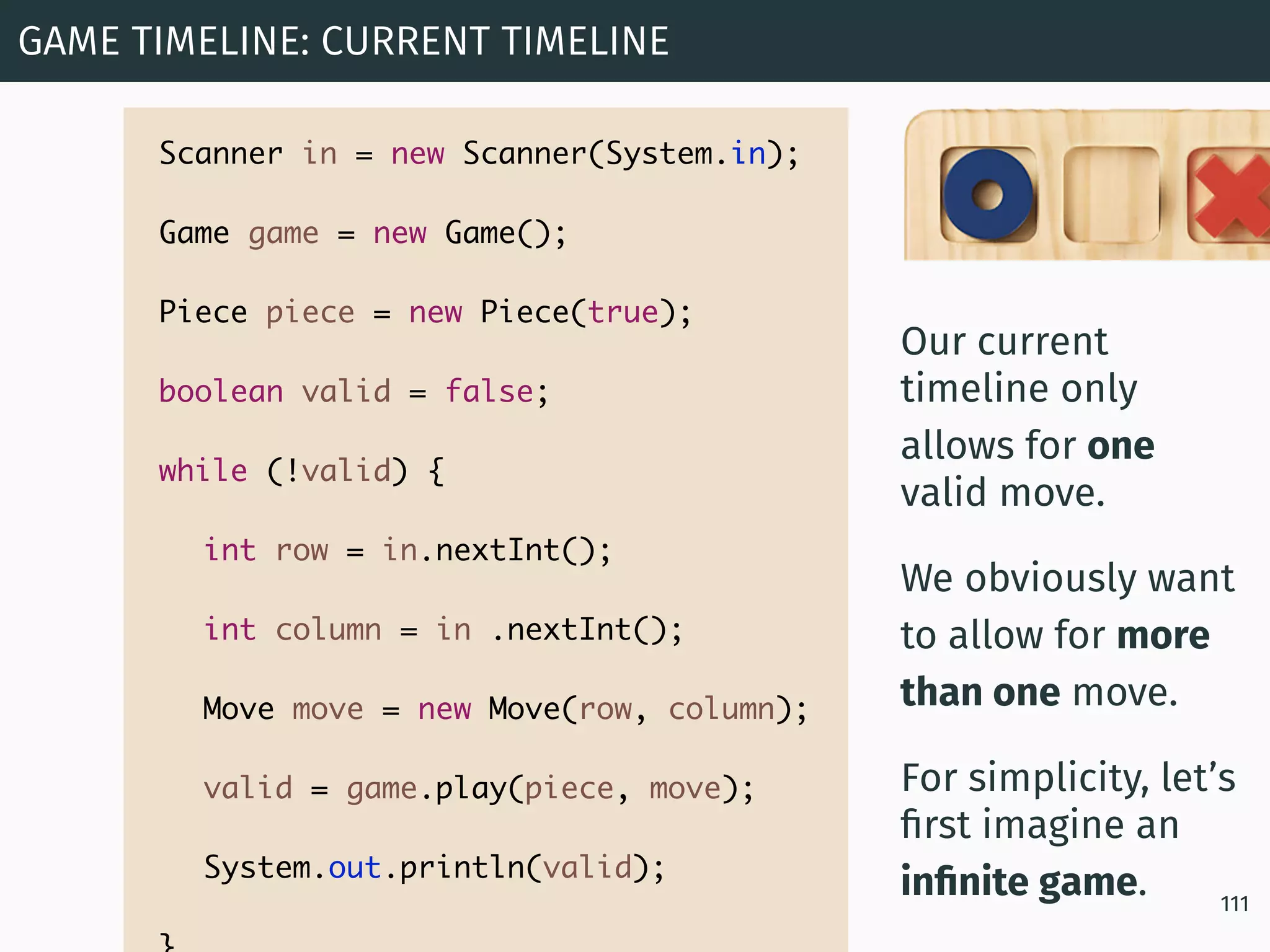
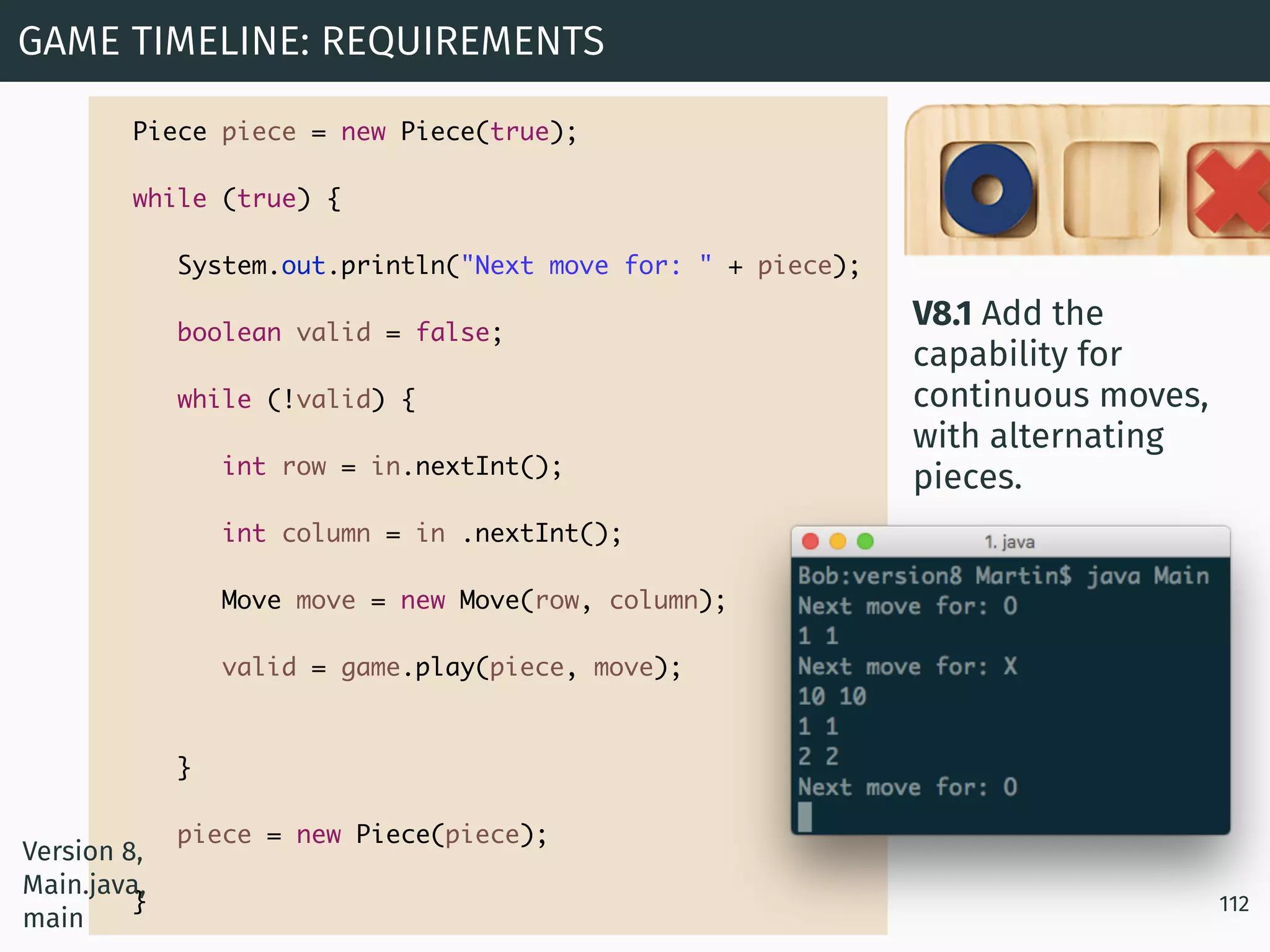
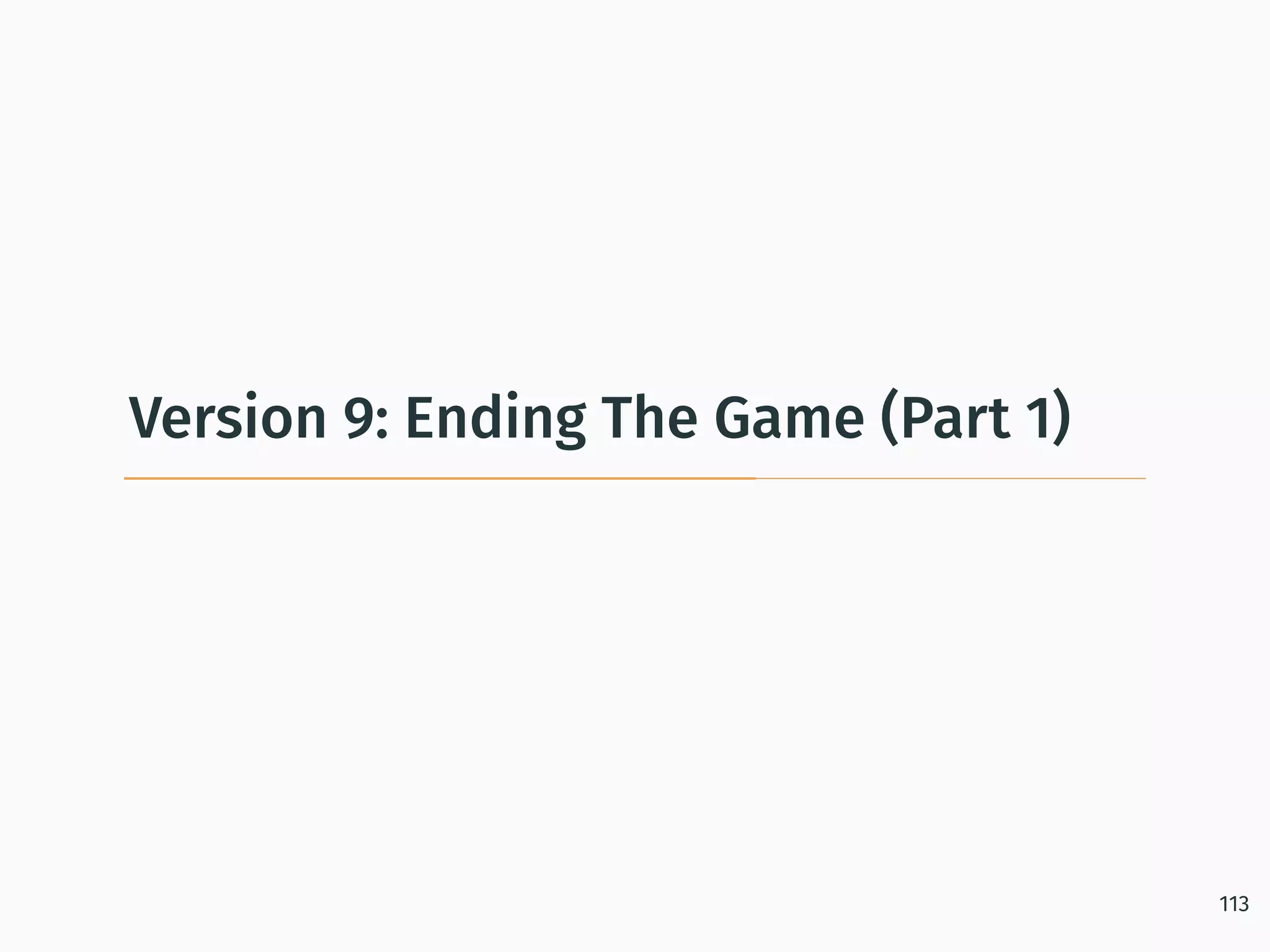
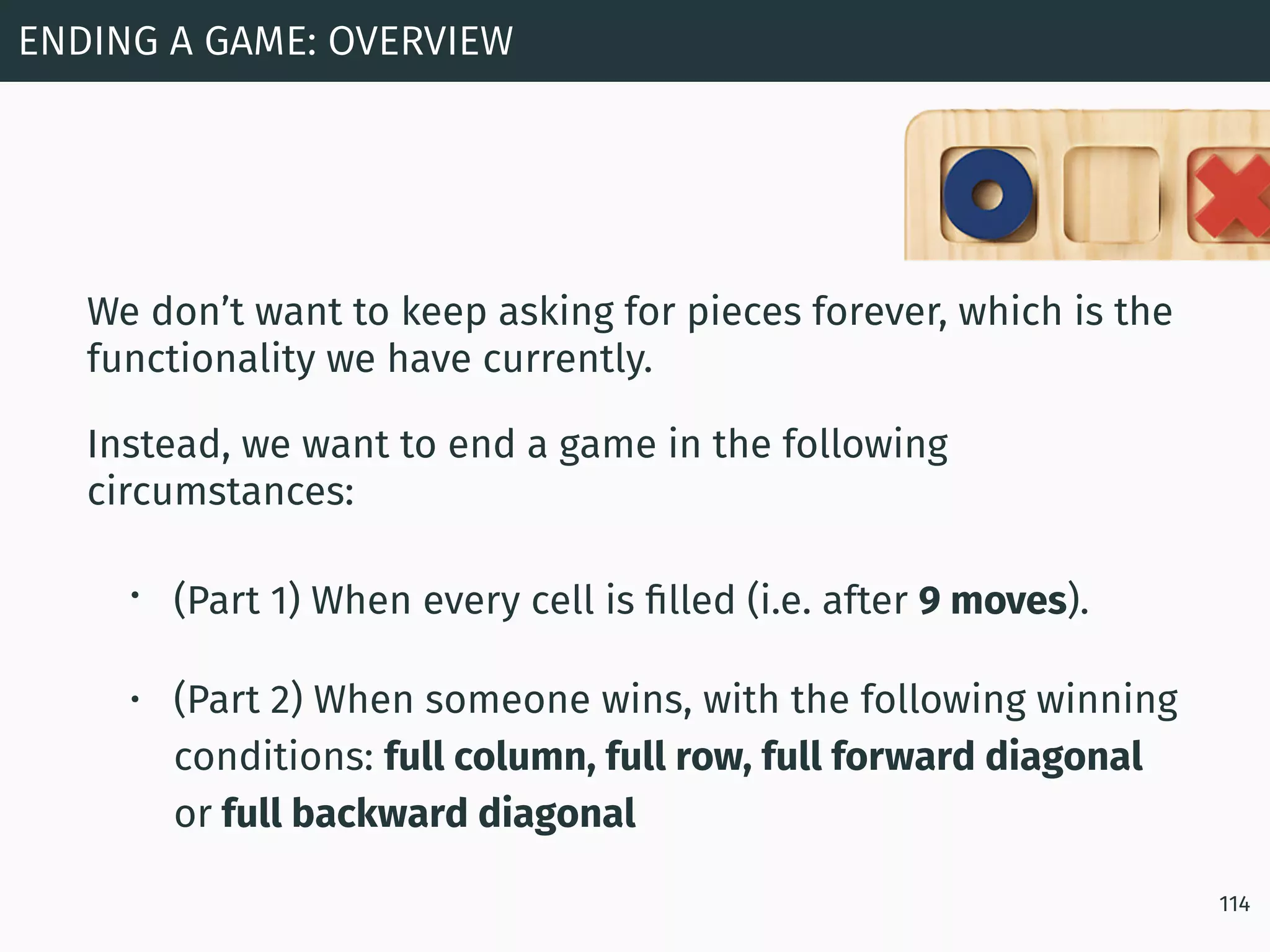
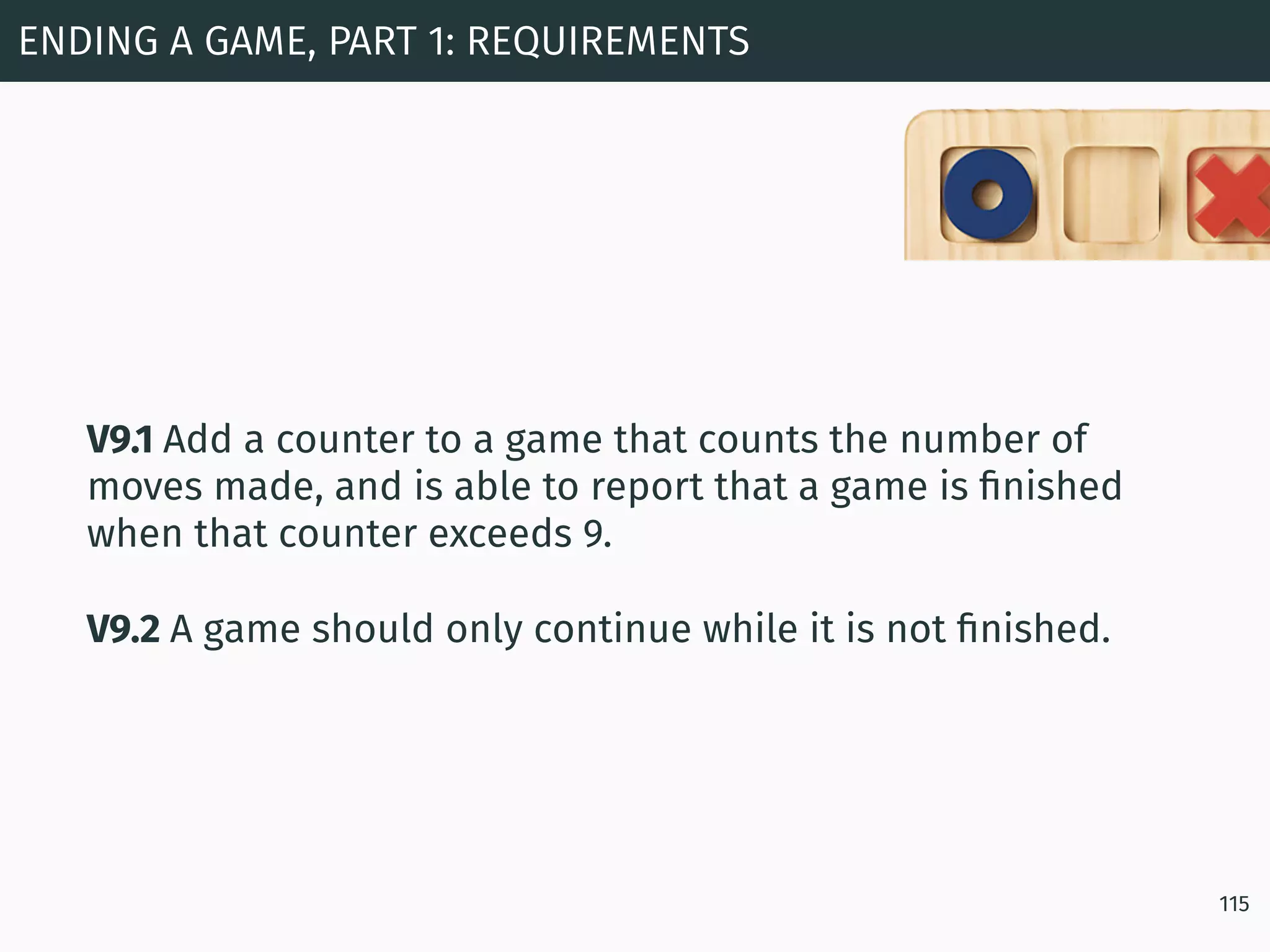
![ENDING A GAME, PART 1: REQUIREMENT V9.1 (1) 116 private int plays; private boolean finished; public boolean play(Piece piece, Move move) { if ( move.isValid() && canPlay(move) ) { board[move.getRow()][move.getColumn()] = piece; plays++; if ( plays == 9 ) finished = true; return true; } else { return false; } } Version 9, Game.java, play V9.1 Add a counter to a game that counts the number of moves made, and is able to report that a game is finished when that counter exceeds 9.](https://image.slidesharecdn.com/9wt4em3btiqhrbnptnkk-signature-1d71bc69af8e1ce5cfd06165f1692fb262b99bc72e1cbb4e076cc65ccd63e69f-poli-180215150739/75/Programming-in-Java-Arrays-116-2048.jpg)
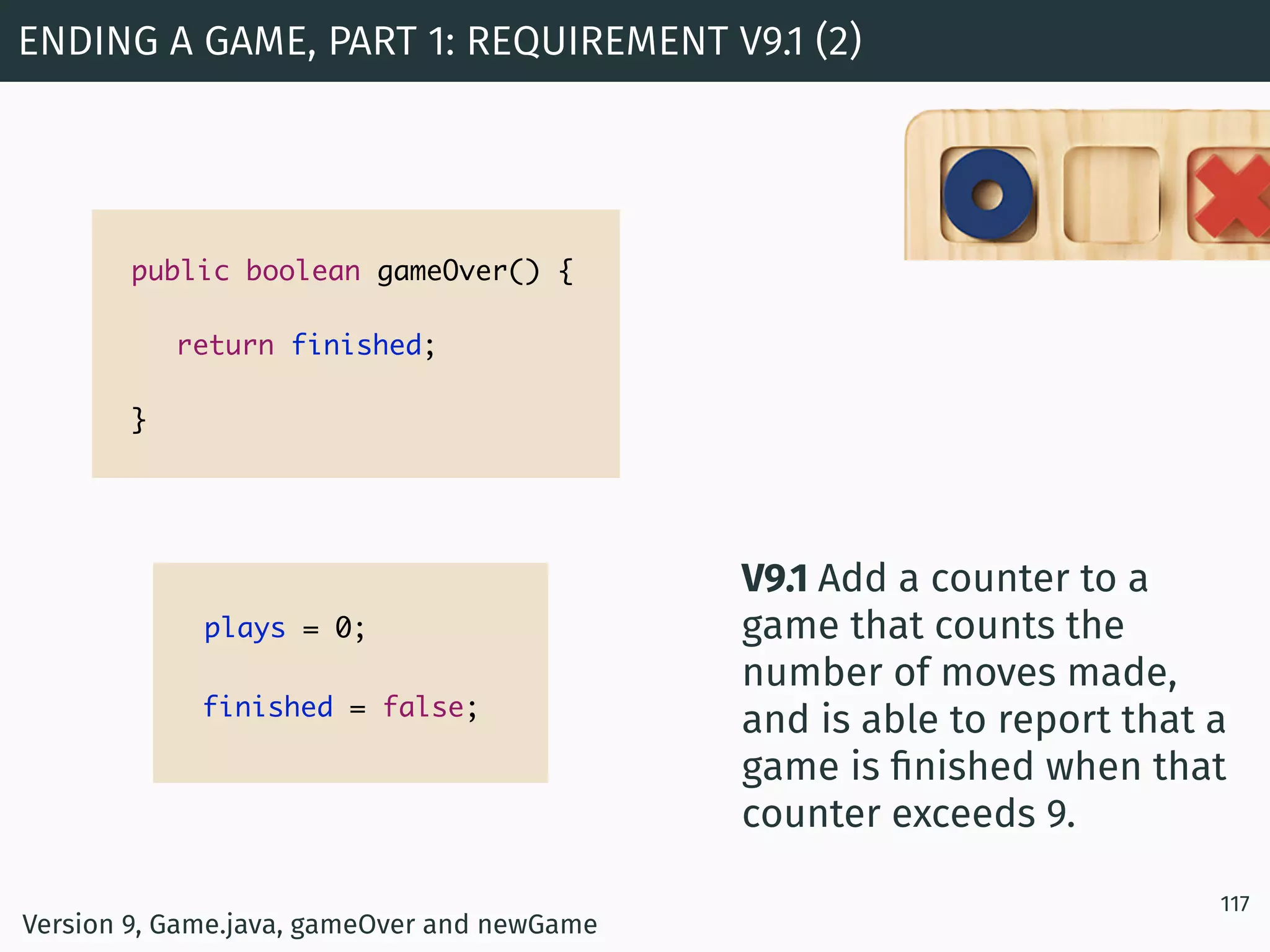
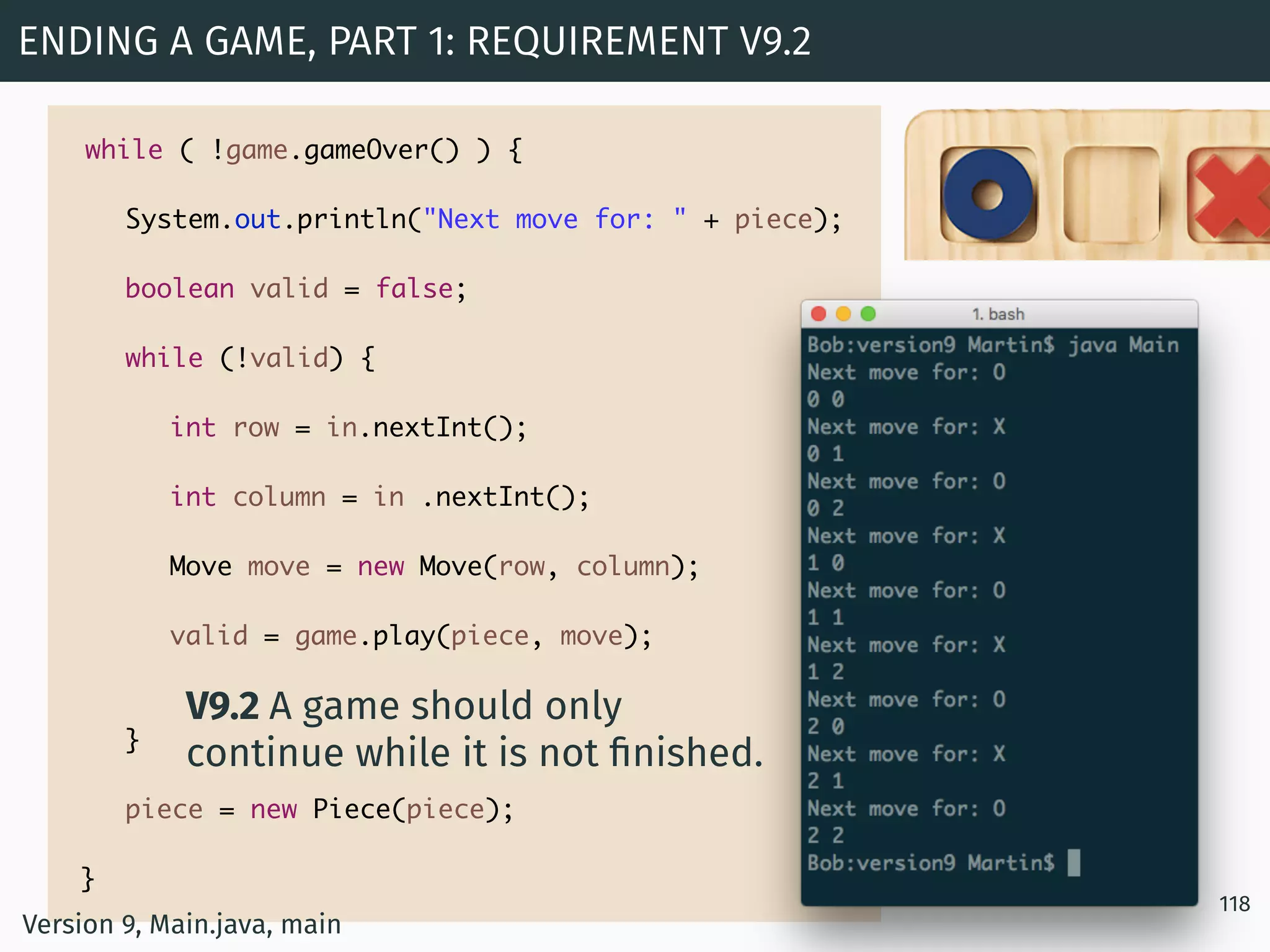
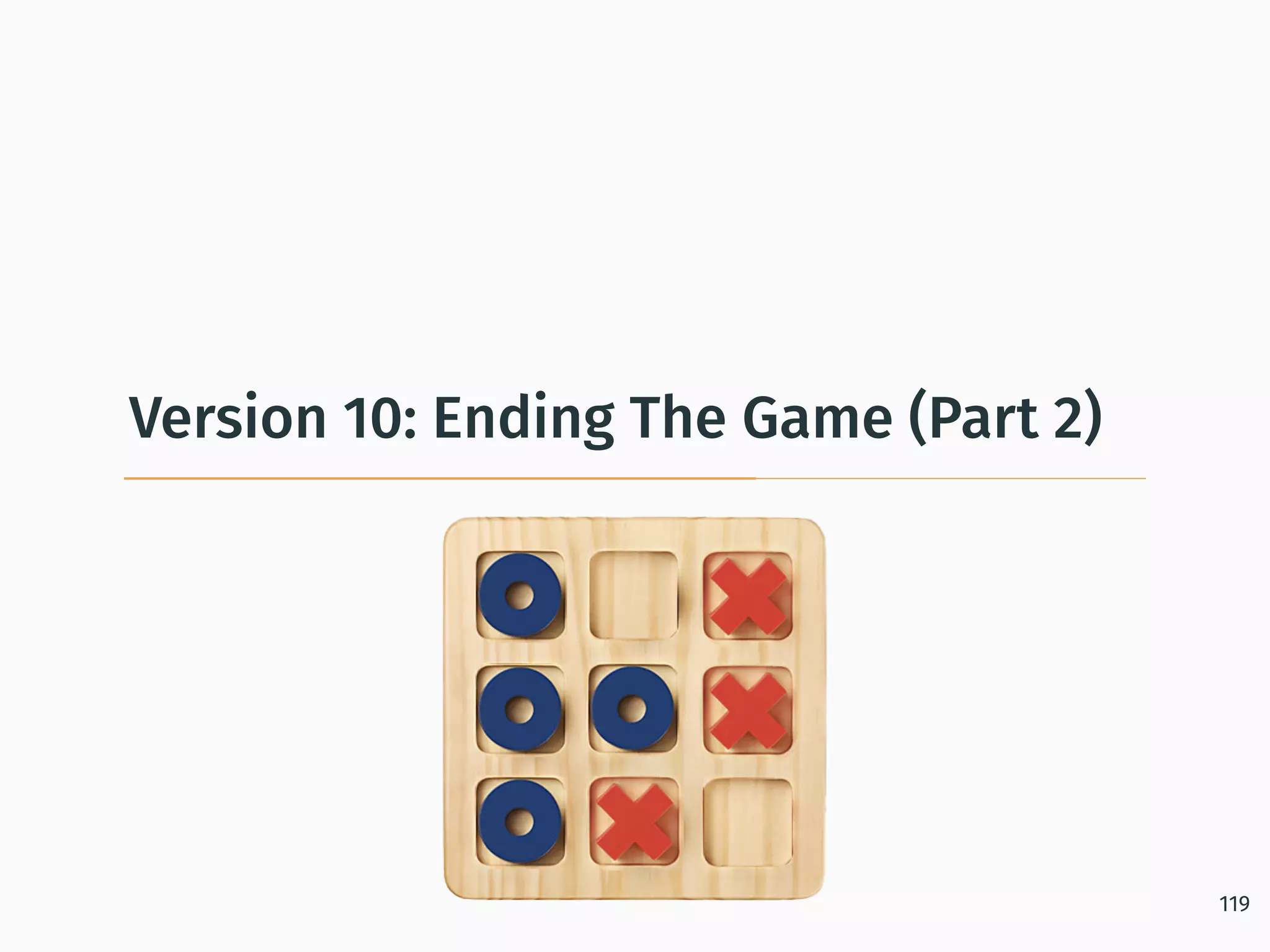
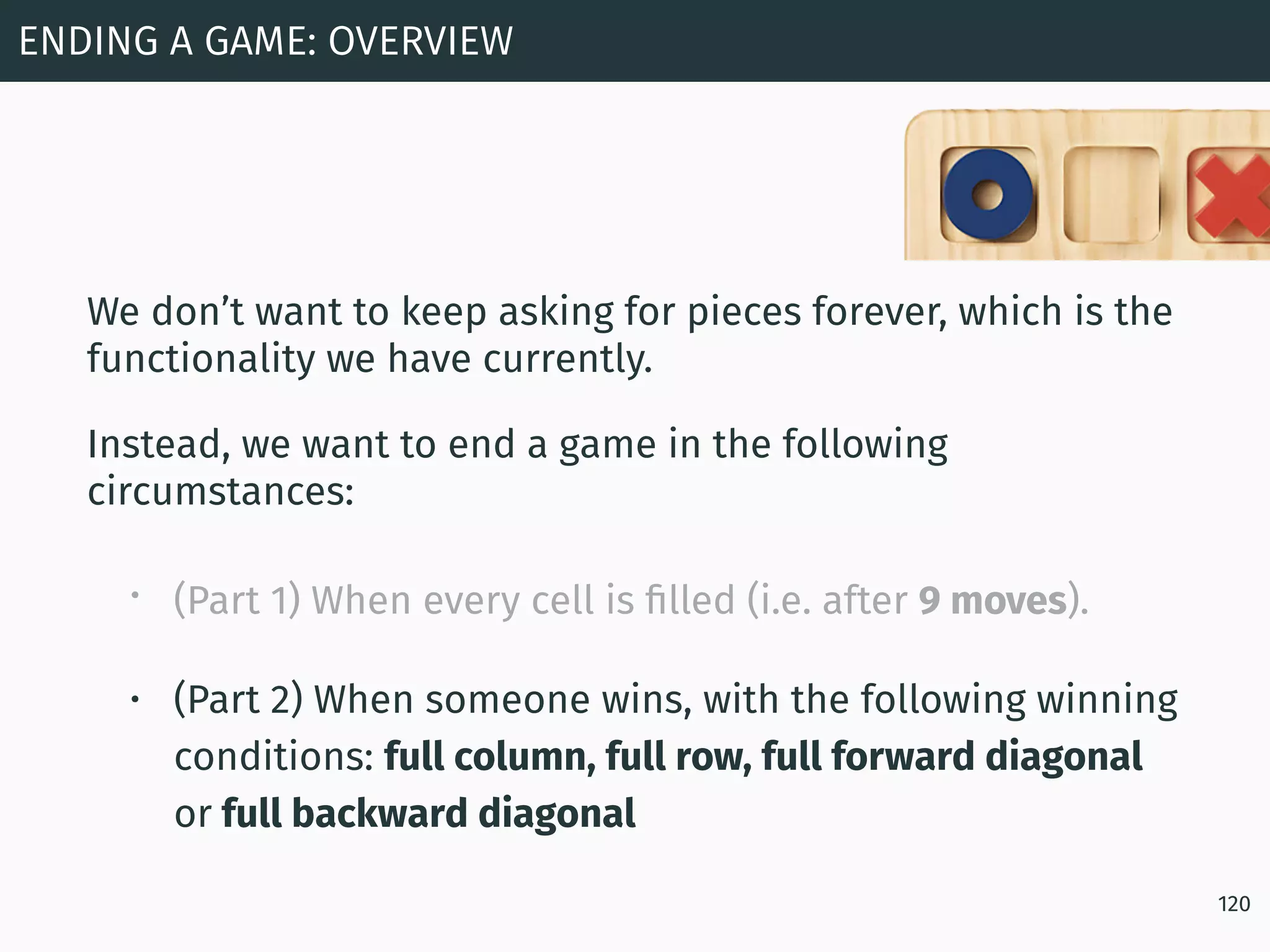
![public boolean play(Piece piece, Move move) { if ( move.isValid() && canPlay(move) ) { board[move.getRow()][move.getColumn()] = piece; plays++; checkWinner(); if ( plays == 9 ) finished = true; return true; } else { return false; } } ENDING A GAME, PART 2: SCAFFOLDING 121 public void checkWinner() { } We know that we want to check for a winner after each play. Methods provide us with the ability to scaffold for future functionality.Version 10, Game.java, play](https://image.slidesharecdn.com/9wt4em3btiqhrbnptnkk-signature-1d71bc69af8e1ce5cfd06165f1692fb262b99bc72e1cbb4e076cc65ccd63e69f-poli-180215150739/75/Programming-in-Java-Arrays-121-2048.jpg)
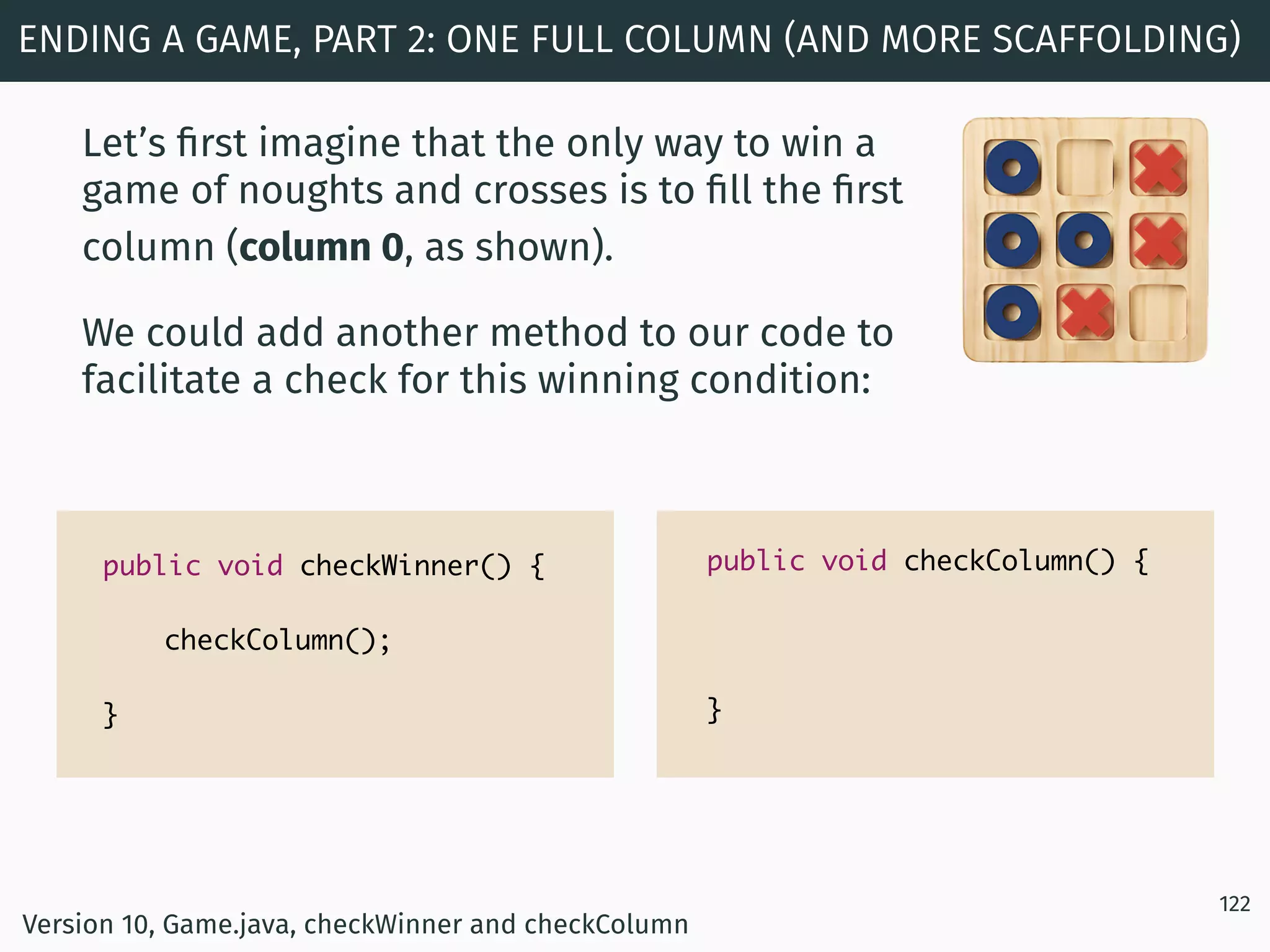
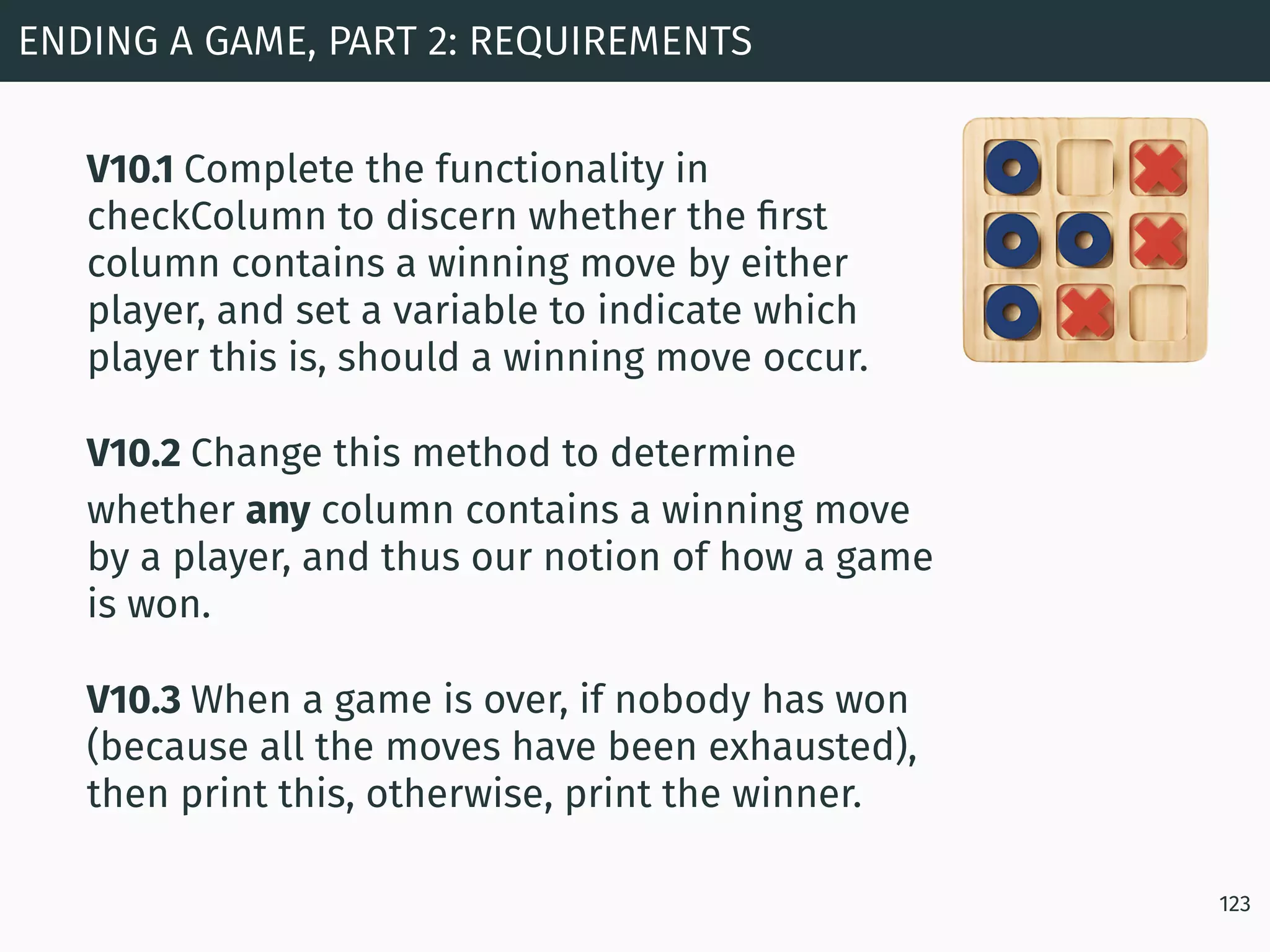
![ENDING A GAME, PART 2: REQUIREMENT V10.1 124 private Piece winner; public void checkColumn() { Piece extractedFirstPiece = board[0][0]; if ( extractedFirstPiece != null && extractedFirstPiece.matches(board[1][0]) && extractedFirstPiece.matches(board[2][0])) { finished = true; winner = extractedFirstPiece; } } V10.1 Write a method that checks whether the first column contains a winning move by either player, and sets a variable to indicate which player this is, should this occur. We use null here and short- circuit evaluation to protect against null references. 0 1 2 0 1 2 Version 10, Game.java, checkColumn](https://image.slidesharecdn.com/9wt4em3btiqhrbnptnkk-signature-1d71bc69af8e1ce5cfd06165f1692fb262b99bc72e1cbb4e076cc65ccd63e69f-poli-180215150739/75/Programming-in-Java-Arrays-124-2048.jpg)
![🙈 ENDING A GAME, PART 2: REQUIREMENT V10.2 125 0 1 2 0 1 2 public void checkColumn(int column) { Piece extractedFirstPiece = board[0][column]; if ( extractedFirstPiece != null && extractedFirstPiece.matches(board[1][column]) && extractedFirstPiece.matches(board[2][column])) { finished = true; winner = extractedFirstPiece; } } public void checkWinner() { for ( int column = 0; column < 3; column++ ) { checkColumn(column); } } public Piece getResult() { return winner; } V10.2 Extend this method to determine whether any column contains a winning move by a player, and thus our notion of how a game is won. Version 10, Game.java, checkColumn, checkWinner and getResult](https://image.slidesharecdn.com/9wt4em3btiqhrbnptnkk-signature-1d71bc69af8e1ce5cfd06165f1692fb262b99bc72e1cbb4e076cc65ccd63e69f-poli-180215150739/75/Programming-in-Java-Arrays-125-2048.jpg)
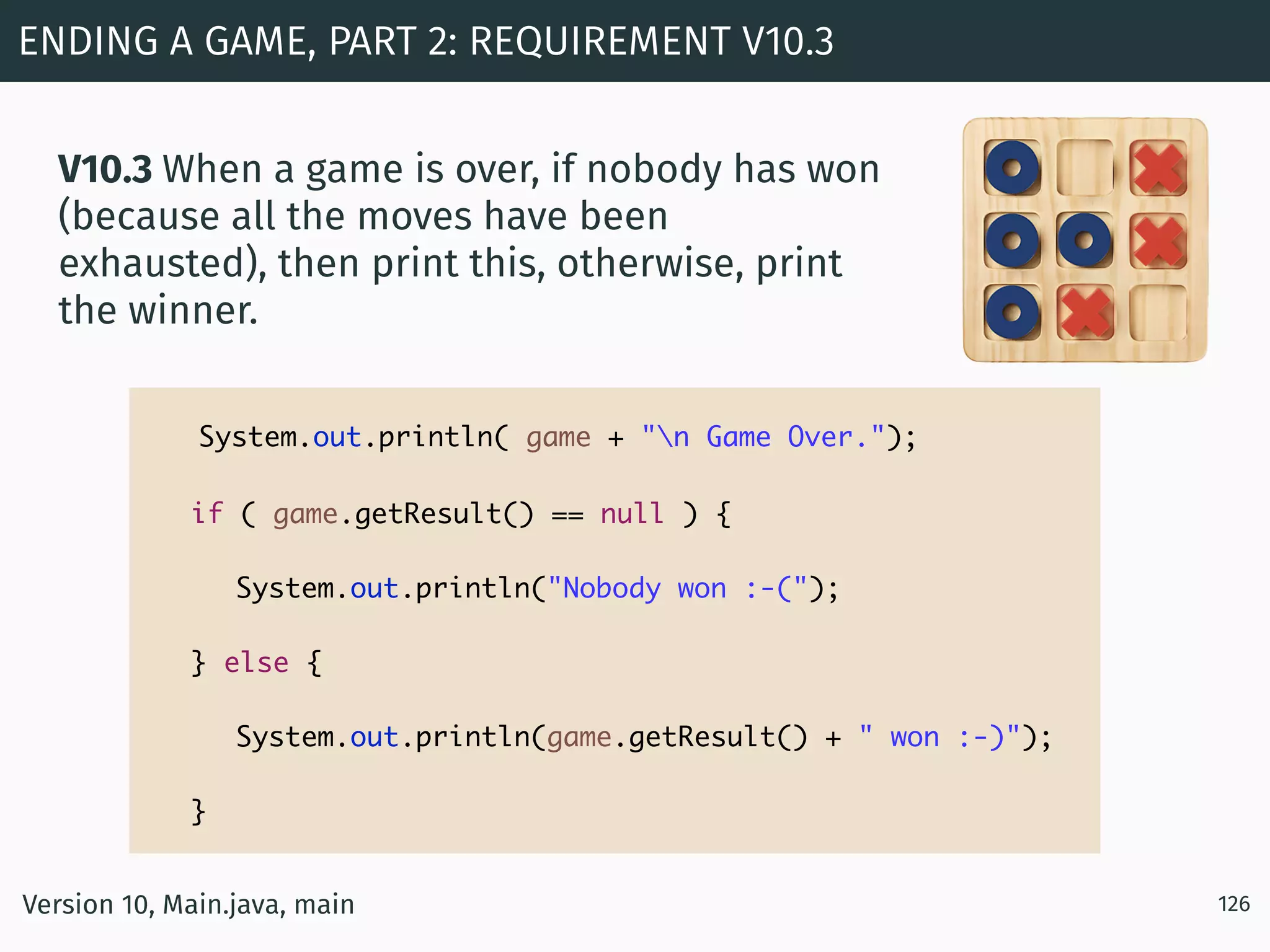

![MAKING THINGS PRETTY 128 public String toString() { String output = "+---+---+---+n"; for ( int row = 0; row < 3; row++ ) { output = output + "| "; for( int column = 0; column < 3; column++ ) { if ( board[row][column] == null ) { output = output + " | "; } else { output = output + board[row][column] + " | "; } } output = output + "n+---+---+---+n"; } return output; } Version 10, Game.java, toString](https://image.slidesharecdn.com/9wt4em3btiqhrbnptnkk-signature-1d71bc69af8e1ce5cfd06165f1692fb262b99bc72e1cbb4e076cc65ccd63e69f-poli-180215150739/75/Programming-in-Java-Arrays-128-2048.jpg)
